 USN Fleet Submarines (1941-43): About 77 subs
USN Fleet Submarines (1941-43): About 77 subsWW2 US submarines:
O class | R class | S class | T class | Barracuda class | USS Argonaut | Narwhal class | USS Dolphin | Cachalot class | Porpoise class | Salmon class | Sargo class | Tambor class | Mackerel class | Gato class | Balao class | Tench classThe Gato class were emergency wartime fleet submarines, built for the USN as a near-repeat of the Tambor class launched in 1941–1943. These mass-production U.S. submarine and the closely related Balao and Tench classes accounted by far for most of the US submarine effort in wartime, and destroyed not only much of the Japanese merchant marine but also a large portion of the Imperial Japanese Navy. With a grand total of 237 combined, all named after aquatic creatures, they really changed the face of the war in the Pacific and succeeded there whereas Dönitz’s Grey wolves failed to do in the Atlantic against Britain: Crippling an Empire.
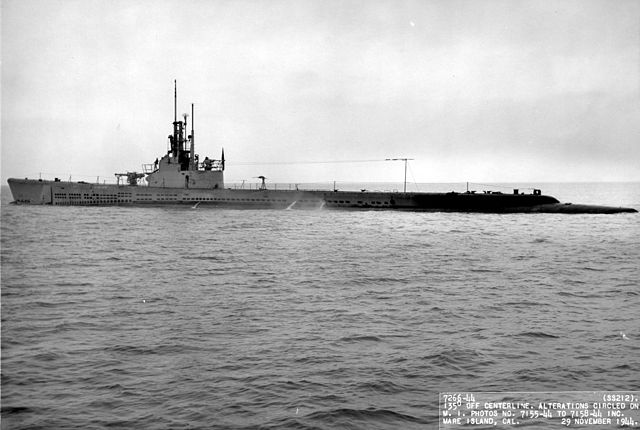
USS Gato
There is a lot to see in the development, design, construction and operation of these submarines, so the original article will be split in three, with the following Tench and Balao closing the chapter of late WWI, interwar and WW2 US submarines. See also the Guppy article for a follow-up. More addon-articles are planned in the future, such as the cruise missile variants and MIGRAINE program picket boats.
Author’s note
After covering the entire line of US submarines since 1914 to this point, here is the crowning jewel of the entire saga: The Tambor class’s poster child, build in wartime: The Gato class. Essentially a repeat design aimed at mass production, this became, for once, the second largest submarine class in history after the German Type VII, and before the Soviet Project 613 (Whiskey), if numbers of the Gato/Tench/Balao are mixed, thus, 704 vs. 237, vs. 215.
Second, this was probably the most instrumental in history. Indeed, the Gato/Tench/Balao (for simplification i will put the trio under the umbrella of the first serie) won the Pacific war. I know, pilots would not like to hear it, but it took almost hundred aircraft, dozens of bombs and torpedoes to sink Yamato and Musashi, whereas it took only USS Archerfish to claim their half-sister IJN Shinano.
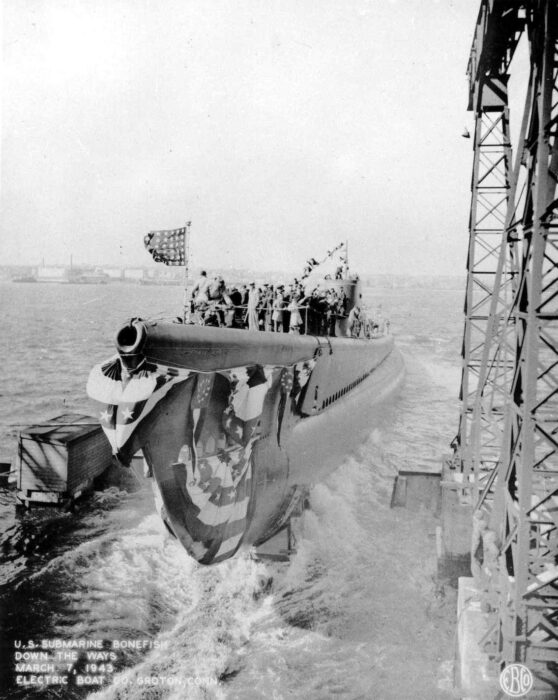
USS Bonefish SS-223
Not the mighty TF38/58 and its impressive Essex class carriers, escorting battleships (including revenants from pearl Harbor), numerous cruisers and hundreds destroyers (notably the famous Fletchers) also built in wartime could do so much damage. Yes, aviation turned the tide at Midway and Leyte. But no, this got to be the Gatos that took the crown. Statistically these submarines made collectively more damage than any other in WW2, only overshadowned by WWI U-Boat classes. They not only sank more ships of the IJN than any other US Navy asset, but they ruined completely the Japanese Empire’s lines of communication, sending to the bottom troopships, supplies and oil to war machine, and materials to its industry. Something Karl Dönitz, despite having almost thrice as much submarines and a far more restrictive oceanic area to cover, failed to do.
This, of course, is only part of the story. The Battle of the Atlantic spanned for longer. It started in 1939 and concluded in mid-1945, versus 1942-45. True also, the number of U-Boats deployed was impressive, but so was the allied armada to counter this real threat. As a result, two Island Nations, even once allied in 1903, were confronted to the exact same perile. Only one came on top, certainly with the help of uncle SAM, but also of its own volition, with an unprecedented construction program and several breakthroughs, from Huff-Duff to the hedgehog or cracking the Enigma machine.
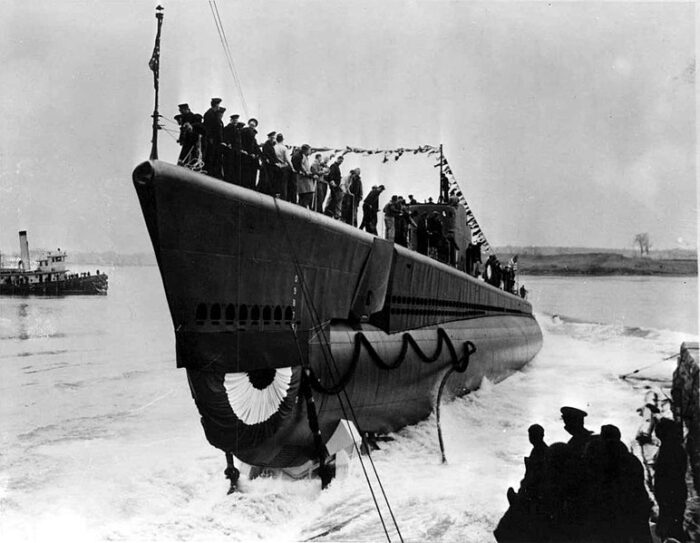
USS Shad
On the other hand, Japan never really considered ASW warfare, for doctrinal and simply budgetary reasons, and only started to realize its importance when it was already too late, added to the fact it was soon unable to sutain the same industrial output as the allies after 1943. Whereas the combined might of British, Canadian, Australian and US Industries were just unmatched. But it doesn’t mean this was a picnic either. The Gato class took the most losses (20) of all US submarine classes in history. Still it was way better to be a US submariner (between the roomy interiors, air conditioning and ice cream) than a German one. The Type VII, with a few other types, lost 739 U-boats along with more than 30,000 German crewmen, 70% of the Kriegsmarine crews. The Type VII were twice smaller compared to the Gatos, cramped, but well suited for the Atlantic.
For reasons of scope and size, i will thus separate all three sub-classes in their own (mighty) successive articles instead of trying to have all them in the same over-bloated one. The present article will thus focus on the genesis, design, construction, operation and legacy of the Gato class alone (70 boats), and later the Balao (120 boats) and Tench (40). I could not dwelve in detail in the career of all 77 of these boats for obvious reasons, but focus instead of outstanding boats and ace skippers. So stay tune for follow-up posts.
This post was first published on January 10, 2017 as a guest post, so eight years prior, and was long overdue for a rewrite and massive expansion.
Development
Situation in 1940
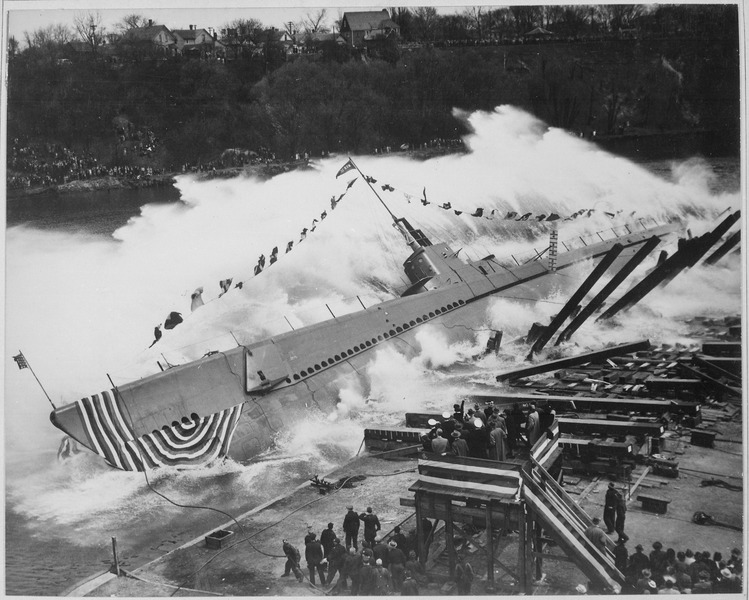
Launching of USS Robalo at Maniwotoc Shipbuilding Co, 9 may 1943.
In 1939, designs for a new class of submarine, closely resembling the Tambor Class were submitted and approved in response to President Roosevelt’s statement of “limited emergency”. By 1940, the designing phase for the new class of submarine was complete, and the first boat of the new Gato Class, the USS Drum, was laid down for construction in September of that year. Drum was completed by November of 1941, just in time for the start of hostilities toward Japan.
Roots of the lineage
The Gato-class were the pinnacle of USN fleet submarine development. But the concept of fleet submersible went back to before WWI. They were originally designed to operate as adjuncts to the main battle fleet, the 1912 “standards”, 21-knots battleships. These subs were usable as scouts, ahead of the fleet, reporting on the enemy fleet’s composition, speed, and course. The could also attack and reduce the enemy’s strenght before the main fleet action in a Mahanian sense. The experience in World War I just fuelled extra details in this portayal and led to devise specifications such as a high surface speed, long range and endurance, plus heavy armament in guns and torpedoes.
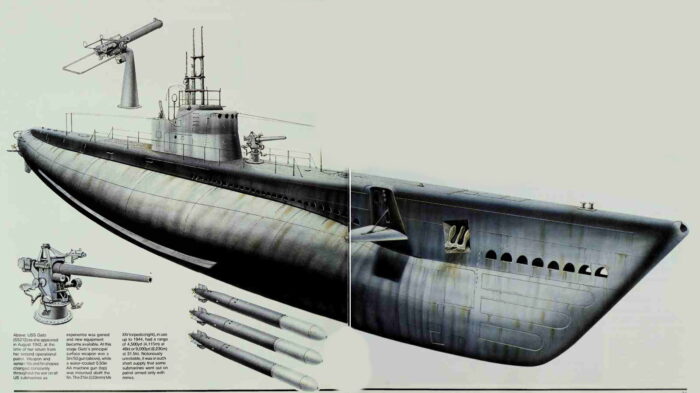
Gato class projection as built, unknown src via warhistory.org
This was complete break from traditional view in the USN staff, that saw submarines since 1914 as coastal defense assets, preferrable to torpedo boats (once explored in the 1890s with a dozen built). The coastal subs advocates remained strong. So strong in fact the 1937 new submarine boss, Admiral Thomas Hart which was also Chairman of the General Board, was against fleet subs, estimating they were a wast of budget, as more coastal subs to be built for a single of these large vessels. He was opposed by the fleet sub faction led by Commander Charles A. Lockwood, later Admiral and Commander of the Submarine Force in the Pacific, seconded by Lieutnant Commander Andrew McKee, as planning officer at Portsmouth Navy Yard, and Lt. Armand M. Morgan of the submarine design section.
Wargaming performed at the Naval War College in Rhode Island, showed in a pacific war, fleet subs would be very useful indeed. The path to the last in line, the 1939 Tambor class, was not smooth sailing though. Limitations in submarine design and construction in the 1920s and 1930s made this ideal very difficult to achieve. The USN experimented constantly with hulls and powerplants, alternating between private sector proposals (in particular Electric Boats in Groton) and state sponsored Yard Portmouth, producing limited series of submarines whoch most often than not proved unreliabe, especially compared to the rock solid S-class of 1918 (still in service as training subs in WW2). The AA-1 class (or T class) and experimental V-boats were 1920s unsuccessful attempts.
1918: The sorry state of US submarine fleet
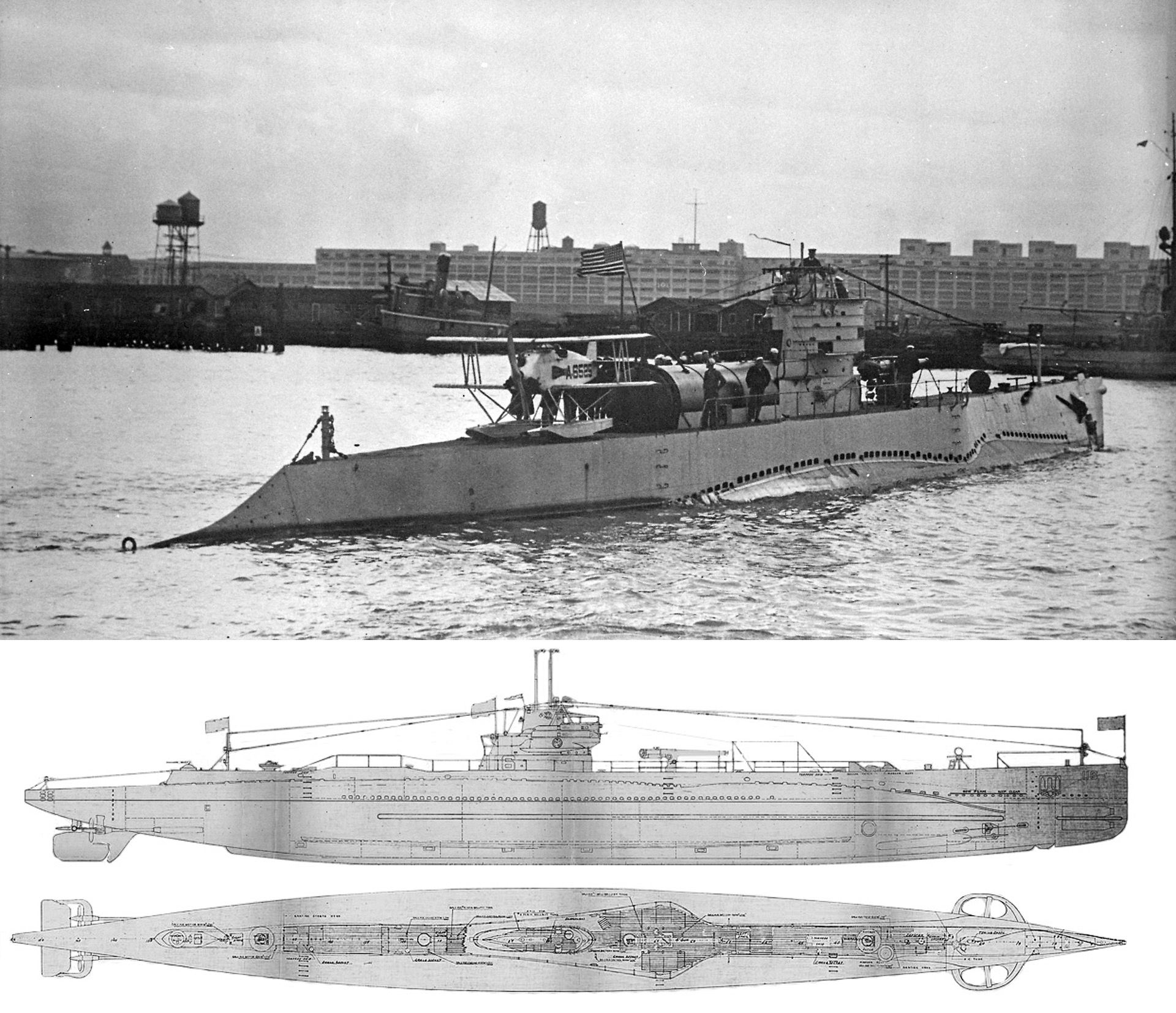
SS-105 testing a floatplane postwar. For the whole interwar, the mass-produced S-class made the bulk of USN submarine fleet. But they were considered as coastal types.
In 1918 already the “fleet sub faction” were acutely aware of the small size and lackluster performances of US subs compared to what was done in Europe. The Germans and their “U-Kreuzer” (already the Deutschland which arrived in the then neutral US to take a cargo made a sensation), the remarkable UB-III design (forebear of the 1936 Type VII), the british giant M-class and R-class hunter killers all raised concerns that the US sub fleet was sub-par. Traditionally, the Holland type reigned supreme and emphasised underwater performances over surface speed and range. His company, Electric Boat, also was the leader in submarine design for decades.

USS AA-1 (or T, or Schley class) were a very early attempt of a fleet sub. Mediocre, they only were tested for a few years. Propulsion issues more than anything else crippled progresses in this field. The goal of reaching 21 knots surfaced remained distant for more than a decade.
But by 1919 the S-class however seemed smaller, slower, less well armed than nearly all European types. Frustrations born from several treaties after Versailles, notably the Washington treaty, left the US with only one credible adversary in a future war: Japan. The young Empire on the rise emerged as growingly militaristic, with a nationalist eal leading to pro-expansion factions to win out gradually power in the country. The Navy was seen as an instrumental part of these grand plans, and after Korea, China was next in the menu. After 1937 it was quite obvious that US possessions in the region were in the path of this Empire and seen as major obstacles.
Interwar progresses
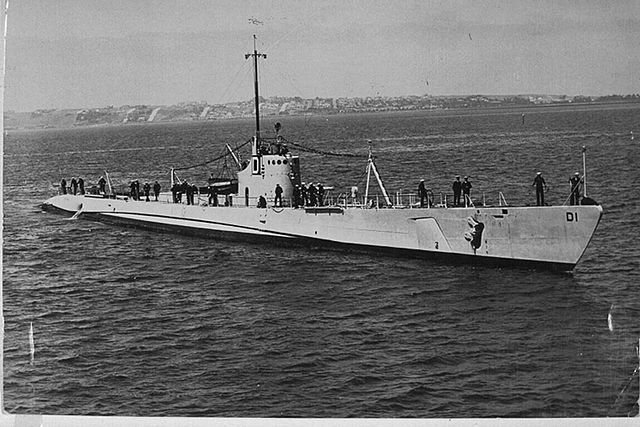
USS Dolphin (SS-169) aka V-7 was at the same time the last V-Boats and start of the interwar US fleet submarine lineage.
In between as the fleet submarine concept was explored, the US studied and experimented with German war reparation U-boats. U-140 in particular made such an impression it was clear that the US would need cruiser submarines as well. There were in 1919-22 until the Washington treaty was signed, banning such designs, a flurry of outlandish proposals with a displacement sometimes up to 20,000 tonnes, heavy guns and aircraft. Only three submarines however were ultimately built of this kind, the V-types USS Argonaut and Narwhal class. But they showed to be too unwieldy for practical operations. Now about the Fleet subs, the T class were mediocre, but so were the Barracuda class. The USS Dolphin (V7) and her 1700 tonnes was perhaps the best of the V-boats and inaugurating a serie of better fleet subs over the years. She was completed in 1932.
From 1931 onward, the time of wild experiments was over, and steady progresses were made towards a standard, which became the Tambor and Gar class. This was the result of building up an industrial base and a lot of experience with classes such as the Cachalot, Porpoise, Salmon, and Sargo. They led to reasonable design which manage eventually, in 1939 to check all boxes for the USN fleet sub faction. Admiral Hart’s partisans would have their last hurrah though as the 1918 S-class were reaching their service age limit and needed replacement. He obtained the construction of the Mackerel class, which were seen also as an alternative for coastal defence in case of war.
1940 Emergency
But in 1940, the situation in the Pacific rapidly degenerated. In 1937 already, Japanese aggression in China alarmed the British, Dutch and French all having colonies here, and to some extent the US which had interests such as the protectorate of Philippines and many advanced islands such as Midway and Guam. War games concerning a war in the pacific pitting available assets against the IJN were not encouraging, especially in case of a war against Germany. For context, for several months at the end of 1941, the USN was in state of quasi war with Germany already and Pdt. Roosevelt pushed for maintaining strenght in the Atlantic, often against CNO Admiral King advices.
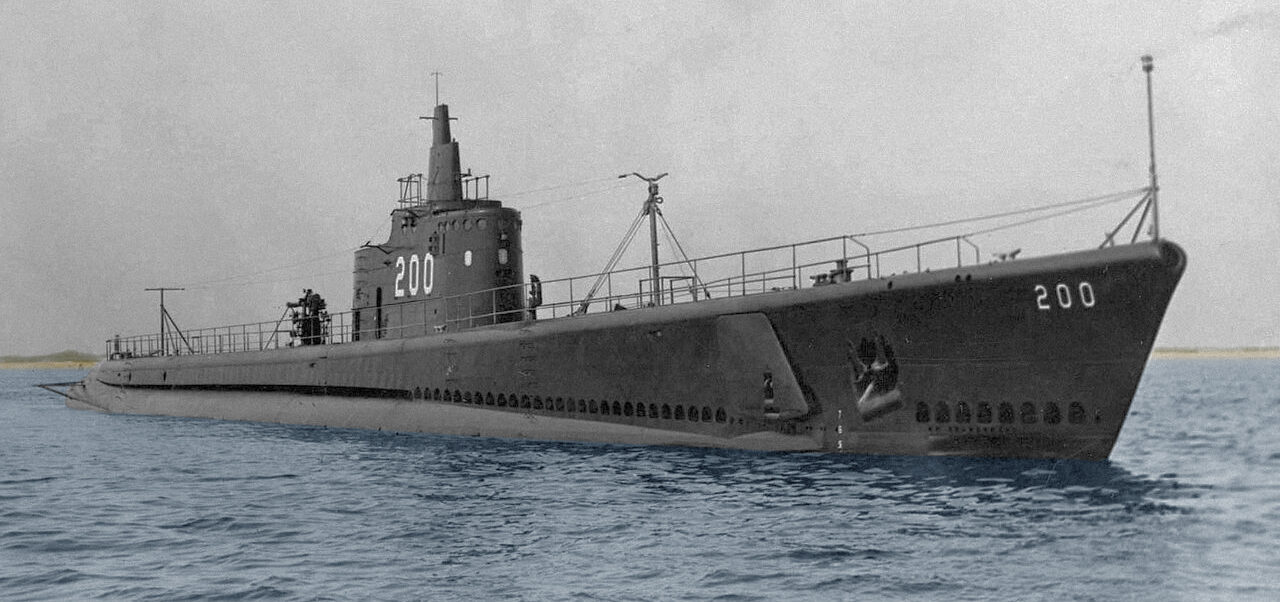
USS Thresher of the Tambor class. In January 1939 when this serie started it seems the “fleet sub” faction led by Lockwood had it’s winner.
The Gato class was at first planned in all this as a successor to the Gar class in a limited serie of six boats as previous classes, tailored for Pacific operations in case of war. It was all long-term as a war with Japan seems still more distant than a war with Germany. By January 1940 the Gato class was rapidly developed as a successor with all the assets for a long-desired fleet submarine. USS Gato herself would be ordered to Electric Boat in October, followed by USS Greenling and Grouper (November and December), but the class could have been named Drum, as she was ordered earlier at Portsmouth NyD in Kittery, Maine in September, followed by USS Flying Fish in December. However USS Gato was immatriculated when ordered the first as SS-212, launched on 21 August 1941 versus Drum being SS-228 and launched earlier (12 May), completed on 1st November, versus 31 December for USS Gato.
But the calendar conspired against this new class. The attack on Pearl Harbor on 7 December 1941 destroyed the Pacific Fleet battle line, and so the battleship-led gun battle with fleet subs as scouts, shattering 20 years of submarine strategic doctrine. Fleet submarine became orphans, only for Lockwood to take back the torch and raise awareness among the top brass, that these fleet subs were superbly qualified for a new mission, commerce raiding against the Japanese Empire. Basically trying what the Germans were already doing in the Atlantic.
Of the Six units initially planned in FY41, the Two-Ocean Navy Act 48 ordered immediately additional units ordered and shortly after Pearl Harbor, 33 more Gato keels were laid. Soon Mare Island Naval Shipyard in Vallejo, California was contracted, as well as Manitowoc Shipbuilding Company, in Manitowoc, Wisconsin, to provide these extra hulls. Together they produced 77 subs over 1942-43, with the last being laid down in May 1943, only to be completed in March 1944. In between standardization and simplifications as well as new organization led to a construction time for keel laying to commission of less than a year, nine months in some cases. This was even pushed further in the next Balao class (120 built).
Design
Design Genesis
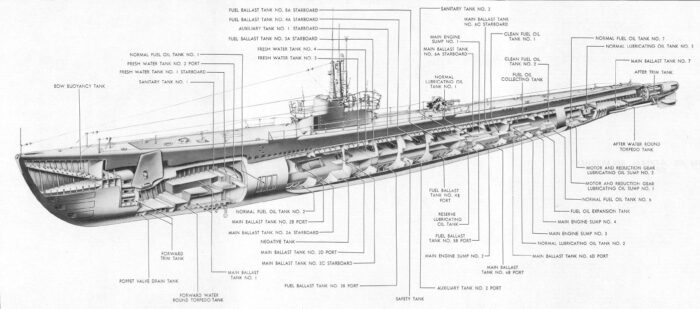
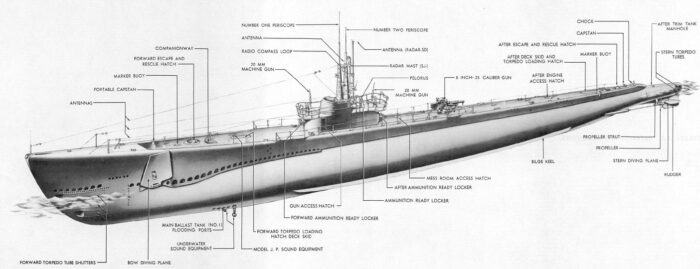
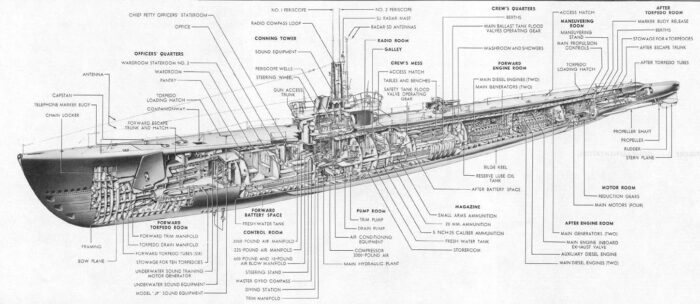
Line drawing of the General Arrangement of the Gato (SS-212) class, courtesy of Lester Palifka, declassified ONI documentation via navsource.
The Gato class submarines were a direct repeat of the 1939 Tambor class design (built 193-40). They were essentially the first USN truly successful fleet submarine, capable of 21 knots (39 km/h) in reliable conditions, and 11,000 nautical miles bringing them close to Japanese home waters with six bow torpedo tubes, plus improved combat operations with all main operators under the the conning tower, a new fire control system (and ballistic computer) and several other advantages. This was as close to perfection it could be, so the next design planned in late 1939 would be a simple improvement. By the way there were no significant differences between the Gar and Tambor so saying the Gato derived from the Tambor rather than the Gar sub-class is perfectly sound.
Differences between the Gato and Tambor
Outwardly, these boats were nearly indistinguishable from the Gatos and indeed went through many of the same wartime modifications that their later cousins received. A few features though will make these boats stand out:
The first visual difference of the early (first batch) Gato class compared to the Tambor and Gar was the stepper shears of the CT periscopes fairing and faired in twin fairlead or bullnose forward at the prow. Government’s boats had ring-type bull nose towing fairlead at the very tip of the bow. Next at the prow there were EB style limber holes, and Curved, then horizontal bulwark, as well as the superstructure ending short of the stern. Government boats of the previous class were retrofitted with a small set of limber holes. This becale standard on all Gato class boast whatever their yard.
The major difference was in the periscope shears with the Tambor/Gar having two 40-foot periscopes, but still retained a periscope station in the control room. The first periscope eyepiece was lower, for a shorter shear support hence the stepped appearance of the fairwater. But oustide this, the Tambor/Gar class was five feet shorter (1.524 meters) as all four main engines and generators were contained in a single large engine room, which was a real safety problem in case of flooding. The Gato class engine room was divided in two with a watertight bulkhead between the diesels. The extra lenght was to accomodate said bulkhead. Electric Boat continued fairing the bull nose towing fairlead into the superstructure. And the superstructure aft ended short of the hull was a feature retained for all Gato/Tench/Balao.
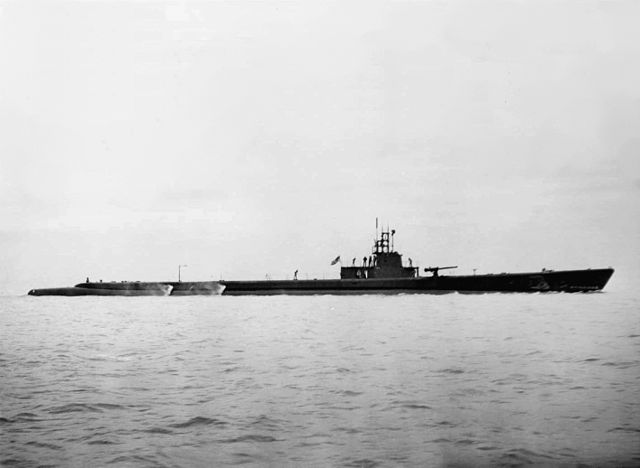
USS Bar (SS-220)
The Gato-class design kept the main advantages of the Tambor, notably their 11,000 nautical miles (20,000 km) radius, but the hull was a bit stronger, enabling deeper dives, from 250 feet (76 m) to 300 feet (91 m). The also kept the partial double-hulled construction with an inner pressure-resistant hull wrapped by an outer, hydrodynamic hull. Voids between the these provided extra space for fuel and ballast tanks. The outer hull merged with the pressure hull at both ends, forward close to the torpedo room bulkheads so it was still considered “partial”. Naval architects and engineers at the Bureau of Construction and Repair (BuC&R) believe they had been unduly conservative in their estimates of hull strength so the thickness of the pressure hull steel was uncharged, apart extra reinforcements. The new 300 feet, so a 50-foot (15 m) increase in diving operation ability was merely a matter of “trust” in the design. This meant the crushing depht was at least 600 feet or 180+ meters. To compare, the smaller German Type VII were routinely capable of diving under 250 meters or 820 ft in emergency.
General Layout
The Gato Class were longer as seen above, at 311 feet (95 meters) compared to 307 ft 2 in (93.62 metrs), for a beam of 27 feet (8.3 meters) same as before, and varying draft depending on the load, from 16 to 17 feet (4.8-5.1 meters), about the same for the Tambor (14 ft 7+1⁄2 in or 4.458 m).
Displacement rose to 1,525 tons surfaced, 2,424 tons submerged. The conning tower (in the cold war the name became a “sail”), was still located in front-middle part of the deck. Both periscopes were in a fairing with a covered surface navigation wheelhouse forward, and anti-aircraft guns aft of the “bath tub” arrangement. The single deck gun was located either at the bow or stern depending on the yards. Fomr some, these boats were still estimated “cramped” with the 60 crew members in a space slightly longer than an American football field. But compared to a German Type VII, this was paradise.
Hull and Ballasting
The Gatos were still double-hulled boats with a pressure hull surrounded by a second non-watertight hull containiun the fuel and oil tanks as well as the ballast, and trim tanks for diving and surfacing, completed with pumps blowers. They could be accessed in case, but this was a very restrictive space. If anything needed to be stored, to the limit of stability, wrapped in waterproof tarps, it was in the space between the upper pressure hull and external deck. It was easy to dismount deck panels, steel aft and forward, with a “cigarette deck” in teak where the deck gun was located to step easier. When diving water rushed in between these interstices.
The central section of the pressure hull was externally-framed, cylindrical, made of 14.3 mm (0.56 inches), 12.5 kg/M2 untreated steel. The two end compartments were truncated conical sections. The conning tower presented a conincal cylinder fitted on top of the main pressure hull, above the control room, surrounded by a fairing.
The maximum diameter of the pressure hull was 16 feet (4.9 m). On top of the outer hull was the deck and a shaped hull tailored for great surface speeds. The forward deck casing comprised the anchor and capstan, forward dive planes, buoyancy tank. The deck was strengthened forward and aft to install up to two 3-inch, 76.2 mm deck guns or heavier. Given the lack of space, one was carried only.
Deck and CT
This deck casing above the pressure hull, which left water entering also trapped air and was responsible for a slow diving time. This, generous limber holes were cutout at its sides, the largest half moon at its base. The conning tower was enclosed in a fairwater structure comprising originally the enclosed bridge and conning station.
The above “cigarette deck” was also covered with teak but as supply ran dry, later simpler serrated anti-slip steel plating replaced these. Generally there was a pintle mount for two Browning AA HMGs. Between Yards, the giverway was often detailes in the fairing and pattern of limber holes, shapes and placement. They were generally more numerous and extended further aft for government-built boats (Portsmouth notably). Many modifications of the faiting to gain time when diving and better adapt radars and AA led to diverging apperances during the war. The next Balao and Tench adopted later mods of the Gatos as standard, in which the CT was reduced and adapted.
Detailed design
Forward Torpedo Room:
The six forward torpedo tubes were located in the bow, four reachable by removing the deck plates. At the start of any patorl, there were torpedoes in each tubes plus a reload each for the two lower tubes stored below the deck plates, two reloads for each of the four upper tubes for a total of sixteen. The sonar gear was raised, lowered, rotated from its compartment as was the pitometer log, and the same compartment hosted fourteen bunks, moslty torpedo operators.
Forward Battery Compartment:
Half of the 252 battery cells were located below the deck plating in this compartment. Above was located the officers’s wardroom, and a dedicated gallery where their food was prepared, they ate separate from the ratings. There were three compartments where the officers were berthed in 4-men or 2-men cabins and one solo for the captain. One compartment was for three junior officers. The executive officer (XO) and first lieutenant shared one of these compartment. The captain had the onlyprivate space on board, and a dedicated attendant and caterer. The five senior chief petty officers shared a fourth compartment. Some boats sailed wiuh ten officers when acting as wolfpack flagships. The yeoman′s office was also there, receiving reports and logbook. Neaby was the the officers′ shower and head as well.
Control Room:
Located at the center, it comprised the steering and depth was control operations. The Hull Opening Indicator Panel, (“Christmas Tree”) displays red and green lights for every opening in the pressure hull. Flooding or blowing was controlled also there. Below it room was the pump room with the backup compressors and radio shack was at its aft end.
Conning Tower:
There was a reduced cylindrical compartment above the control housed by the fairing structure. Both periscopes (attack and watch) were operated from the conning tower. The first Gato possessed a Type 2 attack or (“needle”) periscope with a reduced profile not to be spotted, and faired not to create a wave. The large one was the Type 3 search periscope, with a broader angle and better scope giving bearings. From 1944, the Type 4 “night” periscope replaced the Type 3, fitted with a primitive system: It admitted more light but had a shorter tube so less light was dispersed, and incorporated an ST range-only radar for submerged night attacks. The Torpedo Data Computer, same as the previous Tambor class, was on the port bulkhead aft (expect an upgrade on later models). There were operators for the surface search radars and active sonar displays, and secondary steering position. Repeaters for all gauges were also there. In addition to the captain and XO in an attack were were often two operators, two radar and sonar operators, and talker, repeating orders at loud.
Aft Battery Compartment:
The remaining 126 battery cells and main magazine were located beneath the deck plating, there as well as the main pantry for the crew, freezer, and refrigerated food storage. Above it was located the small medical locker, crew′s mess, galley for ratings and men and 36 individual bunks. Their showers and head were at its aft end close to the washing machine and small storage lockers for valuables items. This is the largest compartment.
Forward and After Engine Rooms:
These were basically identical, separated by a fireproof, waterproof bulkhead unlike the Tambor class. Each contained two of the four main diesel engines. They drove each a 1,100 kilowatt electrical generator to charge batteries and/or drive the electric motors, a flexible system. However the heat inside this compartment was quickly unbearable, if the air conditioning failed. For the anecdote, the excellent Fairbanks-Morse were derived from Junkers Jumo engines and adapted to diesel oil. The GM engines had two banks of eight cylinders running at 750 rpm. The Fairbank Morse engines came in nine-and ten-cylinder versions using opposed-piston running at 720 rpm. They were by far, the most reliable diesels in US submarine history.
Maneuvering/Motor Room:
In this were located the four electric motors rated for 1,350 hp each along with two sets of reduction gears connected them to the propeller shafts, below the deck plating. Switch panels controlling these motors and gearboxes were located above the deck, in the “maneuvering room”. These electric motors ran at a constant, high speed and it controlled by the Westinghouse gearboxes, which were derived from standard automotive transmission.
After Torpedo Room:
This compartment housed the remaining four torpedo tubes with eight torpedoes total, four in tubes, four spares on skids. There were the last 15 bunks for torpedo crews, and the bosun′s tool locker. However later in the war, with extra AA and systems, the crew grew often to eighty men and the return of the practice of “hot bunking” depnding on quarters. Some bunks in the torpedo rooms couldn′t be lowered due to the reloads.
Internal Improvements and equipments
The Gato class made due with new “crew comforts” to alleviate the two months of patrol with the 60-strong crew. More even than the Tambor and earlier classes. Considered still by some in the Navy as “undue luxuries”. They had extra showers, a good air conditioning, refrigerated storage and generous freshwater distilling units at several locations on the boat, plus clothes washers and bunks for almost all individual crew member. And since alcohol was prohibited in the USN (unlike in the RN, with sometimes dodgy wartime exchanges of rum between allies), there was instead, like in the all USN ships, an ice cream dispenser. These virtually unheard of in other navies to say the least, added to the fact food was better than in the surface fleet. All these took part in boosting morale.
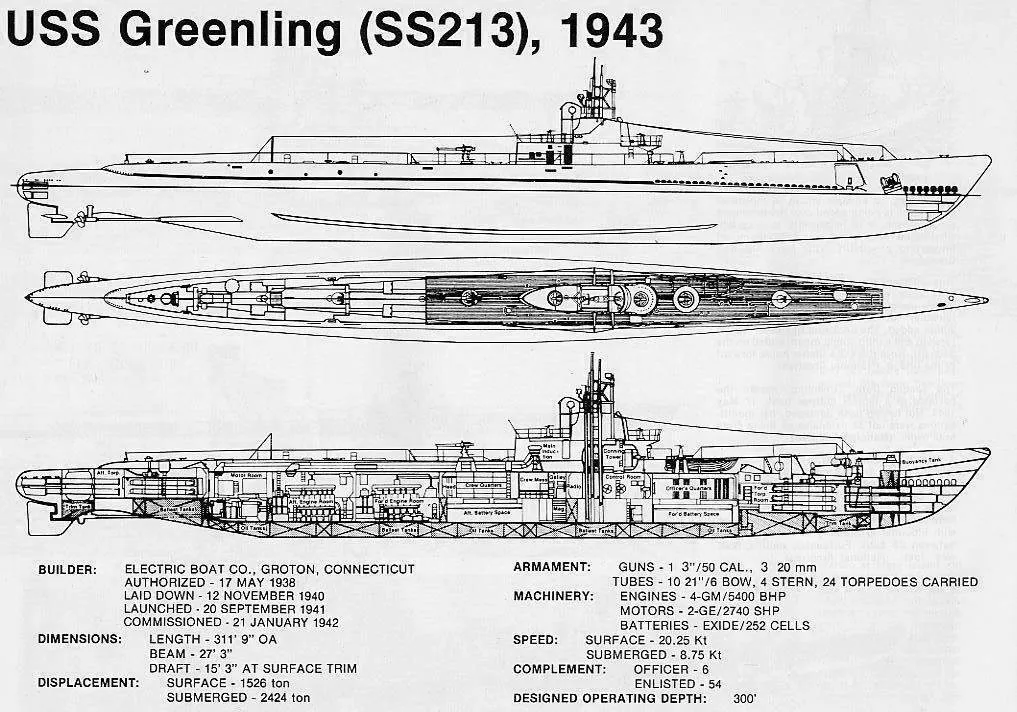
USS Greenling scheme, from i.namu.wiki
The designers of the class, initially felt that if a crew of 60–80 were expected to conduct 75-day patrols in the warm waters of the Pacific these were also essential to keep health and efficiency for the crew, and that was facilitated in the extra five feet or 1.5 meters in the hull. They could be added without impact to its fighting abilities and make an enormous difference. The air conditioning was also a safety feature. Indeed if a submarine submerged for any length of time, the heat generated by the shut-down diesels and electronic gear, plus human warmth all would rapidly raise internal temperatures above 100 °F (38 °C), compounded by high humidity already present in these tropical waters, condensating, dripping into equipment and causing electrical shorts, even fires. So the Air conditioning system acted as a dehumidifier, and also greatly increased general reliability. It ended as a vital equipment than all navies wanted post-WW2.
Propulsion
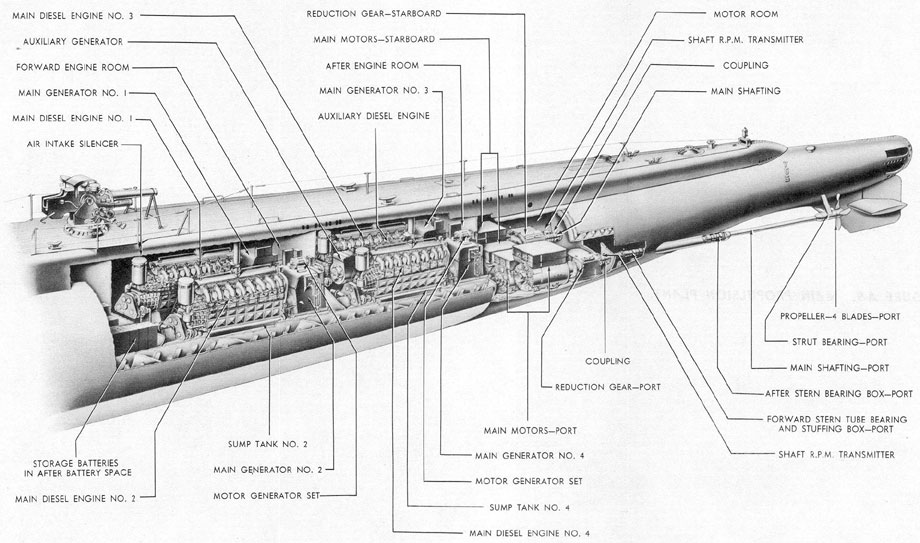
Stern section cutout, from ONI instructional book, Courtesy of Lester Palifka via navsource. The bulkheads separating the engine spaces is quite evident here.
The Gato class started with an already trusted desig, the Tambor class, and repeated the same system, with four electric motors, driven by four diesel engines (all separated by pairs via a watertight bulkhead) and driving 2 propellers. Top speed was exactly what the USN hoped for since 1918, a surfaced top speed of 21 knots so compatible with the speed of a standard battleship fleet, and still 9 knots while submerged, a still god fiigure courtesy of Holland’s heritage of Electric Boat.
They were very different from German submarines as the latter used a diesel transmission when surfaced, then electric transmission underwater. On the Gato class the system was a true diesel-electric arrangement and the diesel engines were used to charge electric batteries AND power an electric motor at the same time. It allowed more redundancy. It allowed also for the diesels to run at a high speed without breakdown and bith these and the electric motors to run at different speeds thanks to a differential in th transmission, leaving great reedom to shut down the diesels in turn for proper maintenance while underway without stopping.

Line drawing, general arrangement of a Gato (SS-212) class, inboard profile cut out via navsource.
At 10 knots, the Gato class and their range of 20,000 km (11,000 nm, 12,400 mi) could operate from Hawaii to Japan and back. Of course in reality they often needed to reach top speed while durfaced to intercept convoys or be re-routed with new orders. This ate up the diesl oil reserves and forced operations from closeer bases such as Guam or Midway, and as the war progressed, closer base. At some point in 1944 there was massive based at the Majuro attoll. As an extra safety, the large size and great buoyancy of thrs subs was enougb to trap air for the crew and stay underwater for up to 48 hours while still udnerway at 2 knots. However depht charge attacks never reach that time. In general, they had to endure 2-3 hours at the worst of depht-charging before escaping.
A large size however at its pros and cons. The major letdown compared to smaller Eropean models was the time they needed to dive. But this was an aunavoidable tradeoff given the scale of Pacific operations. There was no way around a large size, just to have enough oil bunkerage for a 75-day patrols from Hawaii to Japan and back, which was a greater distance than crossing the Atlantic. This limitation was well undesrstood by the bureau and designers incorporated a negative (or “down express”) tank, quickly flooded through massive valves to provide a lot of negative buoyancy for a crash dive. This tank was normally kept full or nearly full while surfaced and emptied up to a point to restore neutral buoyancy. All this was semi-automated on displays.
The surfacing time was also improved. To be fully surfaced, up to periscope depth was done in 45–50 seconds. The superstructure atop the pressure hull provided a walking deck covered with a “cigarette deck” which allowed water to pour in rapidly, then fell down to the pressure hull and be evacuated by lower scoops. When the dive began, the boats would “hang” for a few extra seconds as this superstructure filled with water and to speed it up, additional limber or free-flooding holes were drilled and cut into the superstructure, making a difference externally to the Tambor class.
As the war raged on in 1943, extra measures combined with improved crew training enabled 30–35 seconds dives, now very acceptable for a 95 meters long boat. However the even superior hull ratio (95m vs 8.3m that’s a 11.4/1 ratio) hampered these boats surface and underwater maneuverability. There just was no “magic fix” to alleviate the issue apart installing more powerful hydraulic systems to move the rudder. The turning radius was remaining acceptable and in more thazn one occasion, Gato class boats were able to dodge incoming torpedoes while surfaced, or “swap tubes” on an incoming target, notably for a “down the throat” last minute stern tubes launch. Postwar, some boats even experimented with an additional rudder topside at the very stern.
Armament
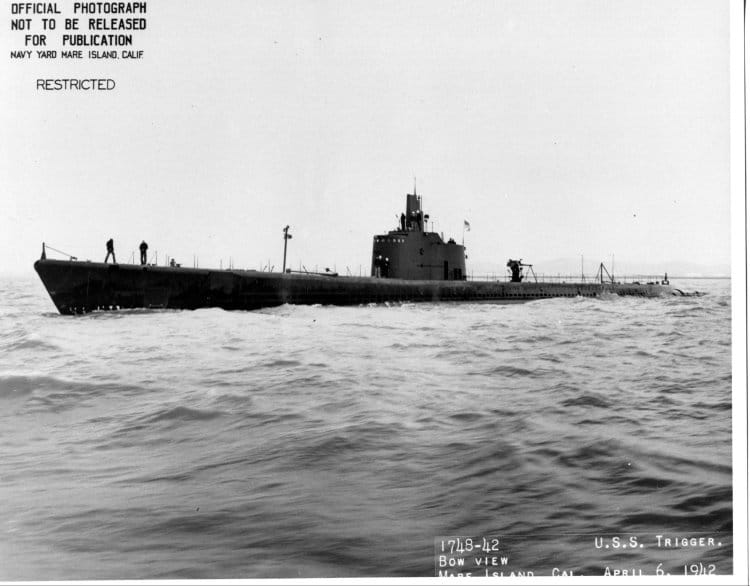
USS Trigger, Mare island Navy Yard, April 6 1942
The Gato Class remained among the most heavily armed subs of WW2, both underwater and surfaced. Standard armament as designed started however with a single 3-inches/50 deck gun, a compromise made postwar to Admiral Hart and his insistance on smaller subs, and four 0.5-in HMG AA in twin liquid-coled Browning mounts in the rear of the “bathtub”. Quickly they were replaced by at least one 20mm Oerlikon Anti-aircraft cannon in 1942. Soon also, whe the conning tower was “razed” (also to improve the diving time), it became standard to have platforms fore and aft of the CT supporting a 40mm Bofors Anti-aircraft cannon at the rea and 20mm Oerlikon Anti-aircraft cannon forward. This became a very potent AA configuration, and helped Gato class boats repelling air attacks in many occasions.
As for the initial 3 inch (76mm) it was swapped in wartime (something Lockwood insisted upon) by a far more potent 5 inch (127mm) deck cannon. It was either forward of aft depending on the batches, often the 5-in gun was located aft to preserve stability and balance. In some cases, the initial 3 inch gun gun was replaced by a larger 4 inch gun. Last but not least, in the eventuality a boat would be beached or stranded in an enemy area, there was a locker with plenty of small arms, such as the M3 Grease Gun, M1 Thompson and grenades, usable for boarding, landing party or security plus at least two extra M2 Browning 0.5 inches machine guns for good measure. In some cases, crews added extra pintle mounts where possible for these, adding to the AA defence.
While underwater, the Gato class kept the same arrangement as before, with ten toedoe tibes, all for 21 inches or 533mm torpedos, with six fore and four aft. The first boats were provided the trusted Mark 10 but as production of the Mark 14 ramped up, they became the nex standard in 1942, for the worst, given their troubelsome nature. In 1944 the new Mark 18 electric torpedo, which was practically invisible, also supplemented this stock. Like the previous Tamlbor, they carried also a generous supply of 24 torpedoes, less the ten already in tubes, meaning fourtnee spares, enabled by the large size if the boats. Previous tests of stocking extra torpedoes between the outer and poressure hull was not repeated by designers as the reloading process was just nightmarish. Submarine commanders just spared torpedoes given their artillery to surface and attack that way preys of less importance. For this, the addition of a 5-inch gun, 40 mm Bofors, 20 mm Oerlikon plus two 0.5 in Browning MGs was a solid proposition.
The insistence for a bigger deck gun was not an easy win, only provided by wartime. The US submarine doctrine wrote by senior officers prevented the installation of a large deck gun as a way to prevent young and brash sub commanders to engage targets when surfaced, risking their boat to counter battery fire. Of course in 1942, reports piled up in the issues encountered by the Mark 14 and inadequacies of the puny 3-in/50 in engagements against smaller vessels, too shallow and “cheap” for a torpedo. Even back on the drawing table for the Tambor lass, Lockwood obtained to reinforce the base support of the deck gun in order to mount a heavier caliber in the future, making the swap easier. It was thus rare to keep the 3-in/50 later in 1942. The use of a 5-in gun was later praised by some commander which were able to boost their hunting board after speing all 12 torpedoes, especially after the utter frustruation caused by all the misses from the infamous Mark 14…
3-inch/50-caliber gun Mk 17/18
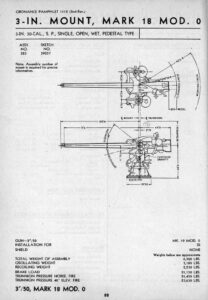 This proven ordnance went right back to the O class and its 3 inch (76 mm)/23 caliber gun, non-retractable in later batches. The new 50 caliber model became pretty standard, with a design going back to 1898 when designed, Mark 6 for the Electric Boat models. The 3″/50-caliber Marks 17 and 18 were installed on the Cachalot class, first used on R-class submarines launched in 1918–1919 and all subsequent models inclusing the Sargo and Tambor class as completed. The Tambor class were the last US submarine fitted with such gun. The Mark 17 guns had a Mark 11 mounting and the Mark 18 guns had the Mark 18 mounting. Image: 3-in/50 Mark 18 specs and sheet, src HNSA via navweaps.
This proven ordnance went right back to the O class and its 3 inch (76 mm)/23 caliber gun, non-retractable in later batches. The new 50 caliber model became pretty standard, with a design going back to 1898 when designed, Mark 6 for the Electric Boat models. The 3″/50-caliber Marks 17 and 18 were installed on the Cachalot class, first used on R-class submarines launched in 1918–1919 and all subsequent models inclusing the Sargo and Tambor class as completed. The Tambor class were the last US submarine fitted with such gun. The Mark 17 guns had a Mark 11 mounting and the Mark 18 guns had the Mark 18 mounting. Image: 3-in/50 Mark 18 specs and sheet, src HNSA via navweaps.
⚙ specifications 3-in/50 Mark 18 |
|
| Weight | 6,500 Ibs |
| Barrel length | 120 inches |
| Elevation/Traverse | -15/+40 degrees |
| Loading system | Manual, vertical sliding wedge type breech |
| Muzzle velocity | 2,700 fps (823 mps) |
| Range | 14,000 yards (12,802 m) at 33° |
| Guidance | Optical |
| Crew | 6 |
| Round | 24 lbs. (10.9 kg) AP, HC, AA, Illum. |
| Rate of Fire | 15 – 20 rounds per minute |
4-inch/50-caliber gun Mk9
Standard intermediate light gun which design dated back 1898. The Mark 9 was installed as an alternative to the 5-in/25 in short supply. It had heavier rounds and higher muzzle velocity but was slower to fire and only had a marginally better range.
⚙ specifications 4-in/50 Mark 9 |
|
| Weight | 5,900 lb (2,700 kg) (with breech) |
| Barrel length | 204.5 in (5,190 mm)oa, barrel 200 in (5,080 mm) |
| Elevation/Traverse | -15/+20 degrees |
| Loading system | Manual, vertical sliding wedge type breech |
| Muzzle velocity | 2,900 ft/s (880 m/s) |
| Range | 15,920 yd (14,560 m) at 20° |
| Guidance | Optical |
| Crew | 6 |
| Round | Fixed 33 lb (15 kg), 62.4–64.75 lb (28.30–29.37 kg) complete round |
| Rate of Fire | 8 – 9 rounds per minute |
5-inch/25-caliber gun Mk17
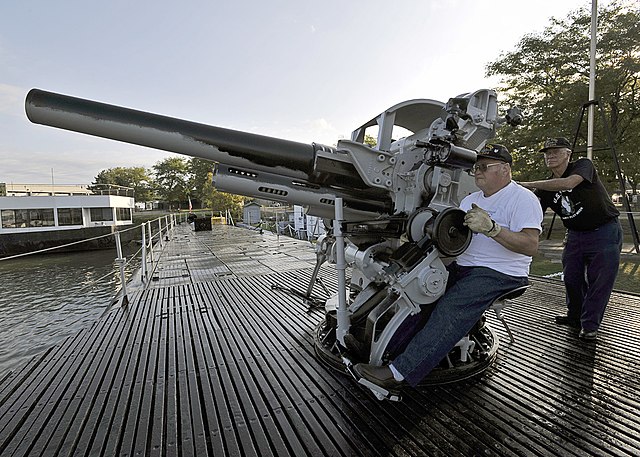
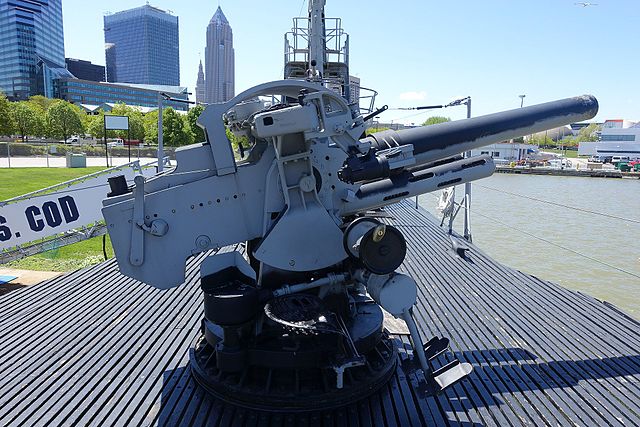
Installed when available from 1943, this ordnance started its career in the 1920s as a new 5″/25 AA gun before being declined in furth variants, Mark 17 being the last of these, developed for submarines. It weighted 2 metric tons, used the Mark 40 submarine gun mount for semi-fixed ammunition (case and projectile handled separately), but existing WW II photographs and drawings of ammunition storage show fixed ammunition. Range was just of 14,500 yards (13,300 m) the same or inferior to the 3-in/4-in/50 guns due to the short barrel, at 40 degrees elevation which was manual as well as training. From august 1944 some Gato class received even two of these (additional one forward) assisted by the Mark 6 “Baby Ford” fire control computer with a Mark 6 stable element. Not on the Tambor. They kept their single aft gun all along.
⚙ specifications 5-in/25 Mark 17 |
|
| Weight | 2 metric tons |
| Barrel length | 11 ft 10 in (3.6 m) oa, Barrel 10 ft 5 in (3,175 mm) |
| Elevation/Traverse | -15/+40 degrees |
| Loading system | Manual, vertical sliding wedge type breech |
| Muzzle velocity | 2,100 ft/s (640 m/s) average |
| Range | 14,500 yards (13,300 m) at 40° (effective) |
| Guidance | Optical |
| Crew | 6 |
| Round | Fixed, 127 × 626 mm R 54.5 lb (24.7 kg) |
| Rate of Fire | 5 rounds per minute |
Mark 10 Torpedoes
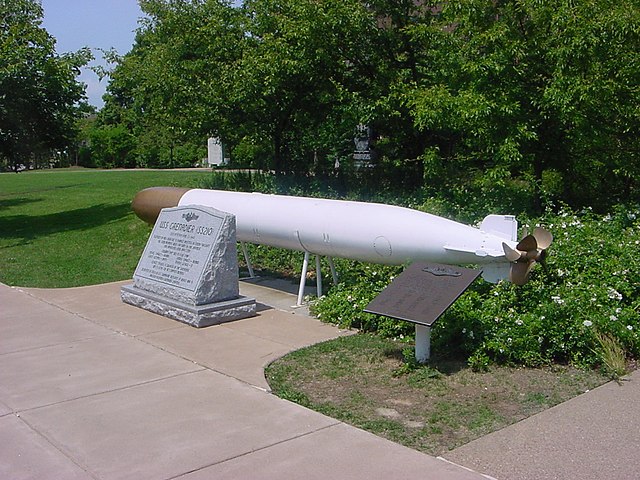
These boats were capable of firing the 21-inches Mark 10 21″ (53.3 cm) Mark 10, a 1917 design entering service in 1918. From 1927 these were the Mod 3, last designed by Bliss and manufactured by the Naval Torpedo Station at Newport. They equipped the WWI R and S boats, most V Boats, The Cachalot, Porpoise and Sargo, but were not intended for the Tambor class. They soldiered on in World War II still, as a trusted straight course in replacement for the infamous Mark 14. Before the latter had its defaults ironed out in 1942-43, the Mark 10 was in high demand and stocks starting to dwindle down rapidly. Thus, production was maintained until 1943.
⚙ specifications Mark 10 Mod 3
Weight: 2,215 lbs. (1,005 kg)
Dimensions: 183 in (4.953 m)
Propulsion: Wet-heater
Range/speed setting: 3,500 yards (3,200 m) / 36 knots
Warhead: 497 lbs. (225 kg) TNT or 485 lbs. (220 kg) Torpex
Guidance: Mark 13 Mod 1 gyro
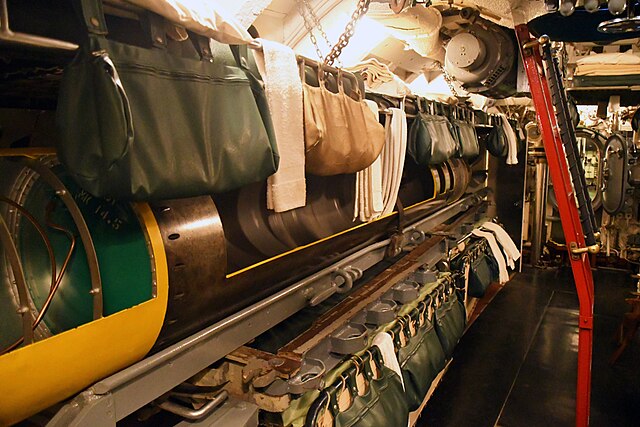
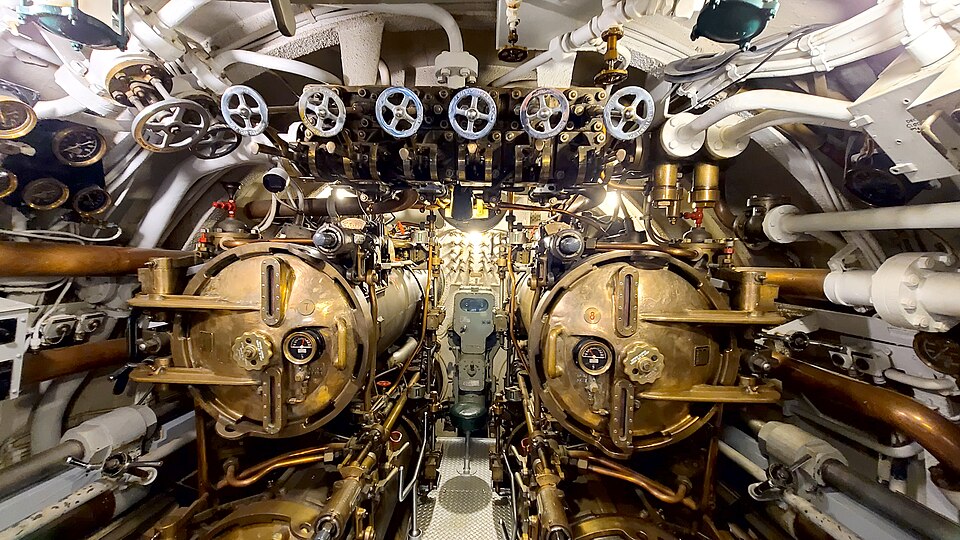
Mark 14 Torpedoes
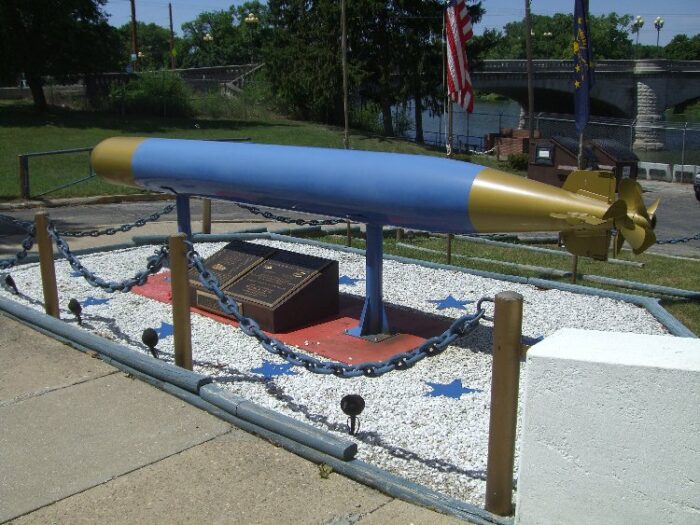
In 1941 she carried the Mark 14, entering service in 1930. Designed replacement for the Mark 10, this was the new standard. Unfortunately the model was infamous for its legendary unreliability, explaining the poor results obtained in 1942 and until mid to late 1943; Long story short, the Mark 14 was a revolutionary new model that was tailored to use a gryroscope combined with a magnetic pistol. The principle was not to detonate on impact, but use magnetoc proximity of the enemy hull to explode ideally under the hull of the target. This way, it was easier to break its hull instead of just making contact below the waterline. These torpedoes were designed at the Naval Torpedo Station Newport, Rhode Island from 1930 and considered state of the art, benefiting from a $143,000 budget for its development.
Production was pushed forward after testings, and at 20 ft 6 in (6.25 m), it was incompatible with older submarines’ 15 ft 3 in (4.65 m) torpedo tubes, like the R and O classes. It was also the best performer, capable of 4,500 yards (4.1 km) at 46 knots (85 km/h). Lots of promises, but the war proved that testings had not been thorough and the rate of misses compared to the Mark 10 became obvious in reports in 1942, this infuriated many captains that disabled the magnetic pistol, but did not solve the problem as it was proved later that their too fragile impact fuse was also faulty.
Responsibility lied with the Bureau of Ordnance, which specified an unrealistically rigid magnetic exploder sensitivity setting while not providing enough funding to a feeble testing program. BuOrd had a hard time later accepting it and enable a new serie of tests, which were mostly from private initiatives.
Only by late 1943 and early 1944 most problems had been allegedly fixed, so that the 1944 Mark 14 at least allowed captains to claim far more kills. The “mark 14 affair” sparkled a lot of controversy postwar and it’s not over.
Mark 14 issues:
The Gato like the Tambor class were of course given the promising new Mark 14 as standard when completed in 1940. They had an abysmal record and ushered in a storm of captain’s protestations in upper echelons, which coupled with the stubborness of the Ordnance delayed the issue to late 1942, mid-43, when their numerous issues were fixed. There were still stocks of the older, straight course contact fuse Mark 10 aplenty, which were “pillaged” every time they were available on forward deployment zones. The problem was that Mark 14s had been provisioned to the frontline, notably from Guam and Midway, so fustrated captains had to make due with these. Frustration amounted as detonations were often heard, but the warheads seldom exploded in a useful way, prematurely quite often or too low under the keel to do any damage and many alleged “kills” in 1942-43 were debunked postwar.
⚙ specifications Mark 14 TORPEDO
Weight: Mod 0: 3,000 lbs. (1,361 kg), Mod 3: 3,061 lbs. (1,388 kg)
Dimensions: 20 ft 6 in (6.248 m)
Propulsion: Wet-heater steam turbine
Range/speed setting: 4,500 yards (4,100 m)/46 knots, 9,000 yards (8,200 m)/31 knots or 30.5 knots
Warhead Mod 0: 507 lbs. (230 kg) TNT, Mod 3: 668 lbs. (303 kg) TPX
Guidance: Mark 12 Mod 3 gyro
Mark 18 Torpedoes
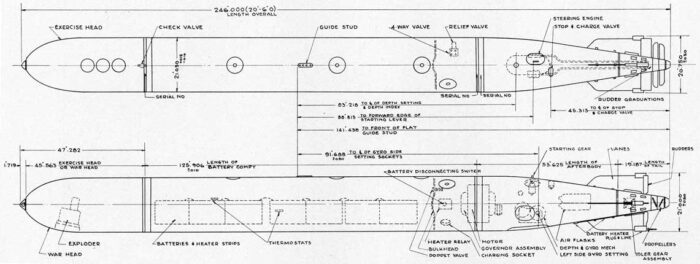
The Mark 18 was USN’s first electric torpedo, and as troublesome at its beginnings as was the Mark 14. They were developed after the German submariners “second happy times”, when firing on US merchant traffic in early 1942. Several G7e electric torpedoes ran ashore and were recuperated for study on order by Admiral King. BuOrd turned not to NTS or GE but Westinghouse for development, at first as a copy starting on 10 March 1942. Design was complete for tests by mid-April.
2000 were ordered and 2600 warheads, 500 being summy practice. They were scheduled for delivery by the summer 1942, but issues accumulated wit the new Exide batteries which overpromised and underperformed, producing dangerous hydrogen gas. Quality control was at fault. But Naval Torpedo Station (NTS), Newport was nof no help and the torpedo was improved by commanders such as Oliver G. Kirk (USS Lapon).
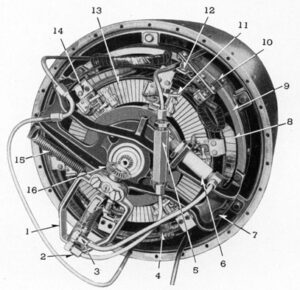 But NTS all but blocked progress so much it ended on the desk of Admiral Lockwood, who rushed into William H. “Spike” Blandy, Chief of BuOrd’s office. After vivid explanations, added to the general discontent with the mark 14, the matter was settled and the Mark 18 prioritized. By late 1943, as it was already delivered for months, issues reported in droves, the most damming being a dangerous ciscular pattern in some cases (likely claiming USS Tang). It should be said that the orginal G7e itself was already problematic. But most issues were ironed out by late 1944. Still, the Mark 18 made only 30% of the torpedoes fired by US subs in WW2.
But NTS all but blocked progress so much it ended on the desk of Admiral Lockwood, who rushed into William H. “Spike” Blandy, Chief of BuOrd’s office. After vivid explanations, added to the general discontent with the mark 14, the matter was settled and the Mark 18 prioritized. By late 1943, as it was already delivered for months, issues reported in droves, the most damming being a dangerous ciscular pattern in some cases (likely claiming USS Tang). It should be said that the orginal G7e itself was already problematic. But most issues were ironed out by late 1944. Still, the Mark 18 made only 30% of the torpedoes fired by US subs in WW2.
The main advantage of the Mark 18 was its lack of bubble wake or visible turbine exhaust. It was virtually invisible. But it was slow, dangerous to reload and complicated to maintain. The batteries were way too sensitive. In July 1944 a new model appeared, but it remained problematic until replacement in 1950.
⚙ specifications Mark 18 TORPEDO
Weight: 3,154 lb (1,431 kg)
Dimensions: 245 in (6.2 m x 21 in (530 mm)
Propulsion: Electric motor, Exide batteries
Range/speed setting: 29 knots (54 km/h) 4,000 yd (3,700 m).
Warhead Mod 0: 600 lb (272 kg), Mod2: 595 lb (270 kg), Mod 3: 575 lb (261 kg)
Guidance: Mark 12 Mod 3 gyro, straight pattern
Detonation: Mk 8 contact exploder or Mk 9 contact/influence exploder.
Mines
Like the previous Tambor/Gar classes, the Gato class could carry same caliber (21 inches) mines in place of torpedoes of the Mk 10 and Mk 12 type, two traded for one torpedo for a maximum capacity of 48 mines, but doctrine commands to keep always at least four torpedoes making for 40 mines, which is confirmed in most publications. In practice however, this was even lower as commanders preferred to have 8 torpedoes, with the largest recorded minefields laid being of 32 mines, not 40. Post-war, the Mk 49 mine replaced the Mk 12 and the Mk 27 an acoustic-homing ‘mine-torpedo’ was carried as a one-for-one replacement (see later).
Mark 10 Mines Mod 1
In December 1941 the USN had in stock some 1,200 Mark 10 as Moored Hertz Horn for 21-inch torpedo tube and only 600 Mark 12.
Production was rapidly ramped up. The Mark 10 project was started in 1921, halted and resumed.
Base specs were:
Mod 1 contact fired: 1,760 lbs. (798 kg) total, charge 300 lbs. (136 kg).
Mod 2 was cancelled
Mod 3: Magnetic: Weighed 1,800 lbs. (816 kg) with a charge of 420 lbs. (190 kg) TNT.
Mod 11: Moored contact mine for USS Argonaut (SS-166) only.
Mark 12 Mines Mod 3
Submarine launched mine designed to be launched from a standard 21 inches or 53.3 cm torpedo tube. They were cylindrical, with an aluminum case. The model was derived from war prize German models in the 1920s, the S-type mines. The Mod 1 was an (airborne) parachute mine, M3 was the submarine type. Some were delivered to Manila just before the Japanese invasion and were dumped into deep water to prevent capture. In total, when carrying just a few spare torpedoes in minelaying missions, the S-class could carry a total of 32 Mark 12 mines.
⚙ specifications Mark 12 mod 3 Mines
Dimensions: 94.25 inches long, 20.8 inches wide. (2,394 m x 0.53 m).
Weight: 1,445 lbs. (655 kg), 1,100 lbs. (499 kg) TNT charge or 1,595 lbs. (723 kg) with a 1,250 lbs. (567 kg) Torpex charge.
Pissibly replaced in 1944 by the Mark 24 submarine launched ground mine. src
Sensors
Sonars
QCC sonar:
The QC/JK gear was located in the Conning Tower, companion units with the QC gear as active/passive sonar and JK gear (passive only). Raides and lowered by a hydraulic system, training by electric motor controlled by handle in the operating station. QCC: No data.
JK sonar:
The JK/QC combination projector is mounted portside. The JK face is just like QB. The QC face contains small nickel tubes, which change size when a sound wave strikes this face. (The NM projector, mounted on the hull centerline in the forward trim tank, is used only for echo sounding.)
Se the full reference here
Radars
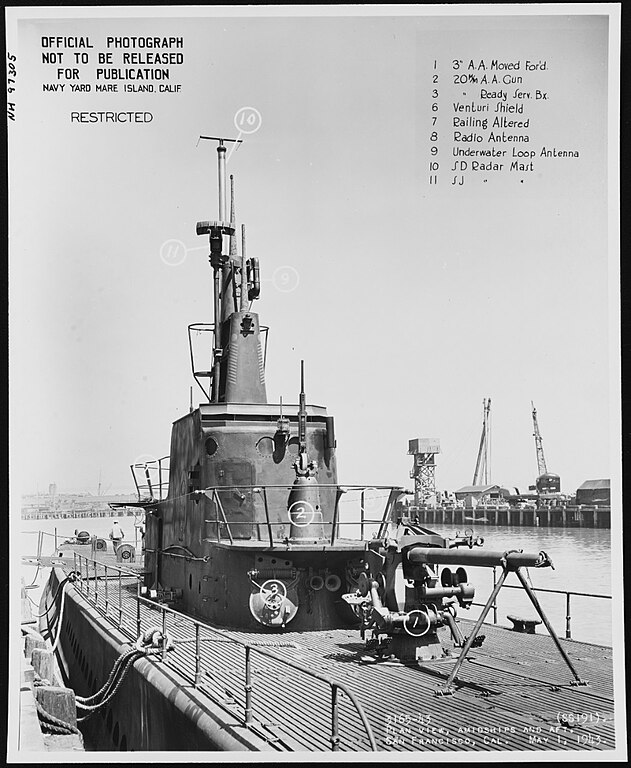
USS Sculpin after overhaul at Mare Island, showing her SD and SJ radars.
SD Radar
The SD radar was a small early navigation and early warning radar developed by the US Naval Research Lab. between 1940 and 1941. It was installed on submarines mostly to warn them of an incoming aircraft beyond visual range. It has an omnidirectional antenna, however and was rather limited in range, and thus could be used also as proximity radar. It could detect bombers at 1000 ft alt. from 12-20 miles, small one at 8-15 miles and no low-flying objects. Plus being active it could also be detected by other submarines, so use was restricted.
Specs:
Introduced in 1941, 400+ made. Powered by 100 kw (SD-5 130 kw).
FRQ 114 MHz, PRF 60 Hz, bmwt 40° horizontal, Pdt 8.5 µs, 4 RPM
RA 20 mi (32 km), accuracy 450 m (1,480 ft).
SJ radar
S band (10-cm) radar developed from 1941 and introduced in June 1942 on US and allied subs. First prototype deployed in December 1941. Stanbdard on US subs from early 1943. Variant of the SG surface search radar. Alaso capabke of detecting low-flying aircraft and used as a communications device with telegraph key, to send signals on a point-to-point basis, used generally in wolf packs, in directional short range mode.
Specs:
Frequency: S-band (10cm wavelength)
PRF: 1350-1650
Beamwidth: 7.5° × 13°
Pulsewidth: 1 μs
Range 30 miles for the SJ-1.
Power 50 KW for the SJa.
JH-1 Hydrophone
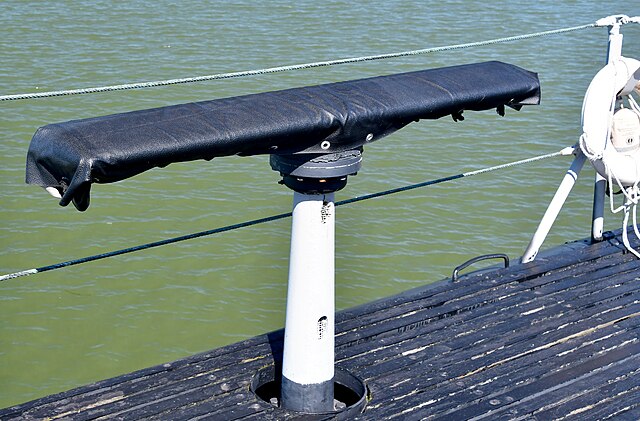
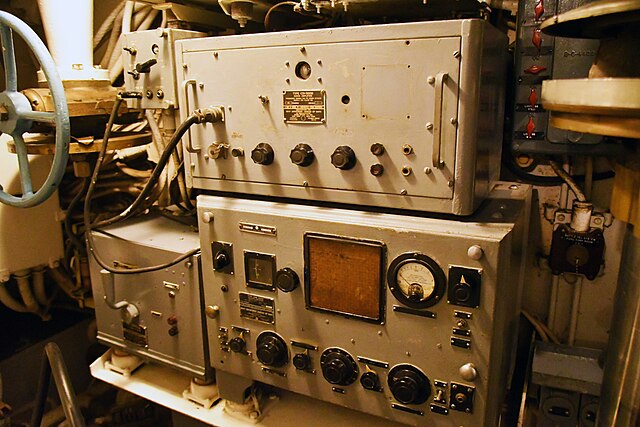
No data so far.
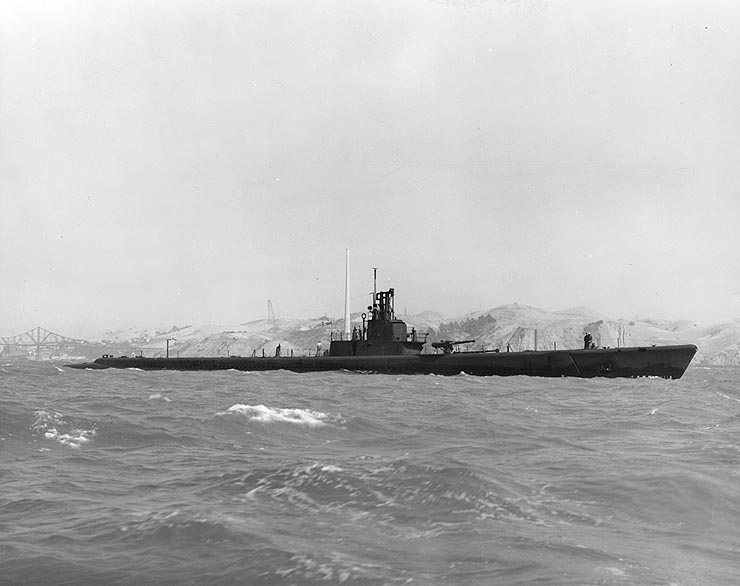
USS Wahoo, one of the most successful Gato class (SS-238)
Appearance

From an unknown Russian publication via topwar.ru, USS Wahoo 1942, USS Drum 1944, USS Trigger 1945.
The boats came out in 1941 with a usual dark gray and black livery standard at the time, and all their hull number painted out for patrolling in wartime. Older boats still used for training kept them for a time. Some received a temporary 2-digut number ion the CT whereas the pain was changed to the same scheme as the previous Tambor class, all medium grey but the darkened rear section and black hull around the pressure hull, roughly at the waterline level but following the filler scoop line. There were rared cases of camouglage like here, USS Gato in 1943 in Measure 9.
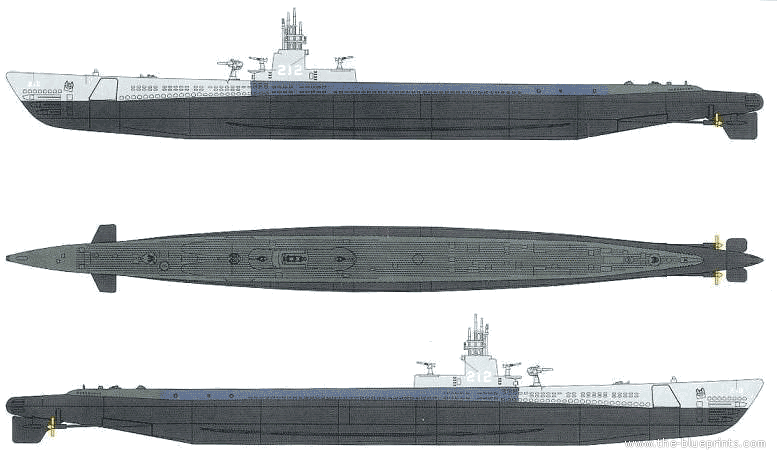
USS Gato in 1944. There were variations in the outer hull paint like here, forward light gray, aft dark marine blue and end in dark grey (the blueprints).

USS Wahoo in 1942, measure 9

USS Gato in 1944, Measure 23-3S
⚙ specifications (1944) |
|
| Displacement | 1,525 tons (1,549 t) surfaced, 2,424 tons (2463 t) submerged |
| Dimensions | 311 ft 10 in x 27 ft 3 in x 17 ft (95.05 x 8.31 x 5.2 m) |
| Propulsion | 2x shafts, 4× diesels, 4x HS EM/red. 5,400 shp/2,740 shp |
| Speed | 21 knots (24 mph) surfaced, 9 knots (10 mph) submerged |
| Range | 11,000 nautical miles (13,000 mi) surfaced at 10 knots |
| Armament | 10 × 21-in TTs (6 fwd/4 aft, 24), 3-in/50, Bofors 40 mm, Oerlikon 20 mm |
| Sensors | QCC/JK Sonar, SJ radar, see notes |
| Test Depth | 300 ft (90 m) |
| Crew | 6 officers, 54 enlisted men |
Construction
The Gato Class would see 77 models produced at $2.6 million until 1944, when it was replaced by the Balao and Tench classes in production. The Gato would see service in 6 different navies until 1969, when it was ultimately replaced by more modern diesel-electric and nuclear powered submarines.
Even though it wasn’t necessarily the best submarine of World War 2, the Gato Class undoubtedly had an impact on the Pacific Theater and on submarine design in general. Ships, weapons, and tactics were developed just to counter American submarines, with the Gato making up the majority of the US submarine fleet during the early parts of the war.
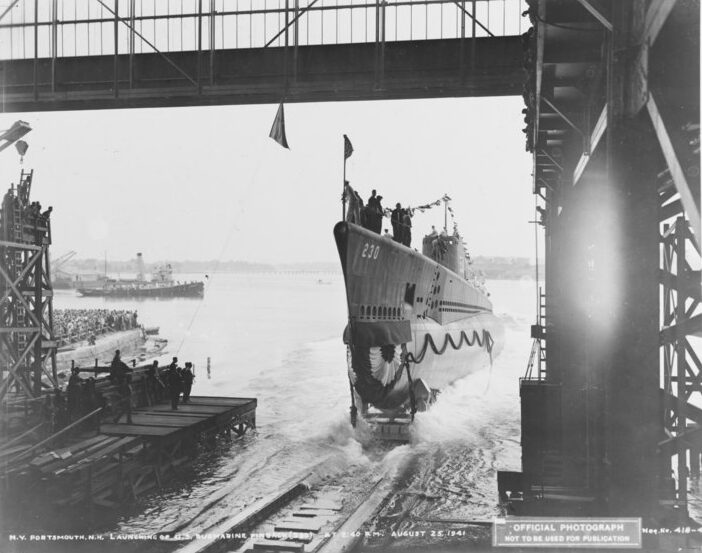
Seventy-seven were commissioned but there is some confusion as to the number of Gato-class actually built, some sources (like Conways) listing 73, due to the transitional nature of the first four (SS-361 through SS-364) under the second contract by Manitowoc NyD in Wisconsin. These were originally intended as Balao-class subs indeed, were assigned hull numbers in middle of the range for the Balao class (SS-285 to SS-416, SS-425, and SS-426).
Manitowoc was designated as the follow-on yard to Electric Boat, usin the exact construction blueprints and plans and same suppliers.
The government-owned shipyards of Portsmouth Naval Shipyard on the east coast, Mare Island Naval Shipyard on the west coast in fact were the first to make the transition to the new Balao design, in the summer of 1942, just as their own boats of the Gato class were laid down earlier. Electric Boat had a massive backlog and just was not ready to make the transition for more hulls until January 1943. Manitowoc completed their allotted production run and was delayed for switching over to the Balao design as Electric Boat did not supplied them with the updated plans. They even face a work stoppage so they got permission to complete four additional boats (SS-361 through SS-364) to Electric Boat’s Gato-class plans instead of Balao class. Manitowoc’s first Balao-class was USS Hardhead.
The Gato boats were authorized in appropriations for Fiscal Year 1941, under Pdt. Franklin Roosevelt’s “limited emergency” by September 1939 as war erupted in Europe. The first laid down was USS Drum at Portsmouth Naval Shipyard as said above. Due to the large construction capacity, more than half (41) of the Gato class were built at Electric Boat, which received three new slipways at their north yard, four new slipways to the south yard for tjis, all financed by the government. The latter also purchased an old foundry downstream from the main yard to constructed 10 additional slipways, turning the yard over to Electric Boat as well, whent it bacame the “Victory Yard” integral part of Electric Boat operations.
Modifications
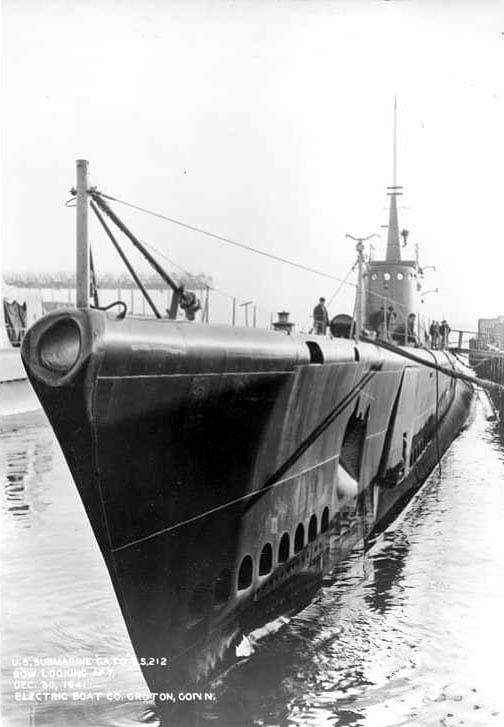
USS Gato, 30 december 1941
Engine changes
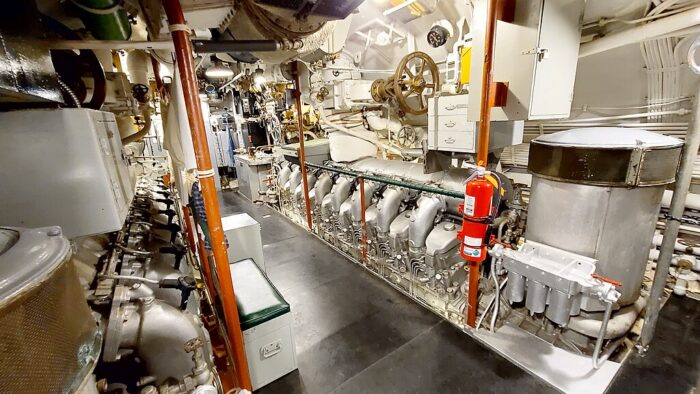
General Motors Cleveland Model 16-248 diesel engine
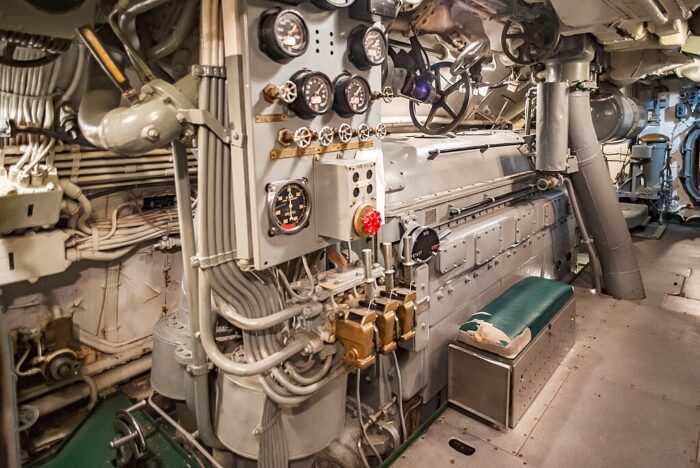
Fairbanks-Morse Model 38D8+1⁄8 diesel engine
Twelve Gato class from Electric Boat (SS-253 to SS-264) received the very last of the infamously mediocre Hooven-Owens-Rentschler (H.O.R.) double-acting diesel engine, which was not an idea of Electric Boat but of the Navy in 1937 as they promised light weight, superior performances, but proved abysmal in service. The Tambor and Gar class escape their installation due to shortages, but once these new HOR diesels were completed, they were shipped to Electric Boat to be installed as they had been already paid for before the contract was cancelled. These ten boats had a hard time to say the least, albeit some early issues had been fixed by the time amready.
For memory, the Navy was promised nearly twice the horsepower for the same size as standard diesel engines, but the Hooven-Owens-Rentschler company over-promised and under-delivered in a big way: The engune met severe design and manufacturing problems after being received, and were a maintenance nightmare. Breakdowns became so frequent, unreliability overall frustrated so much submarine captains that reports piled up. The HOR engine were the equivalent to the Mark 14 complete clusterfck. They radically reduced operation efficience for these ten boats in particular. They were all removed at the first opportunity, replaced by General Motors Cleveland Model 16-278A V-type diesels.
The other Gato-class went wit the excellent Fairbanks-Morse 38D 8-1/8 nine-cylinder opposed-piston engine, or the earlier General Motors Cleveland Model 16-248 V-type which never gave much issues, if at all. These Fairbanks Morse in particular proved hardy, rugged, well liked and had a mastrful career in the cold war as well, very late as backup diesels. Both diesels brands were of two-stroke cycle types.
As for electric engines, they were provided by Elliott Company motors (paired mostly with Fairbanks-Morse engines) whereas General Electric powered boats had of course General Motors electric engines, which were in greater supply. They gave satisfaction and never needed a change in their career.
Conning Tower/fairwater changes and evolution
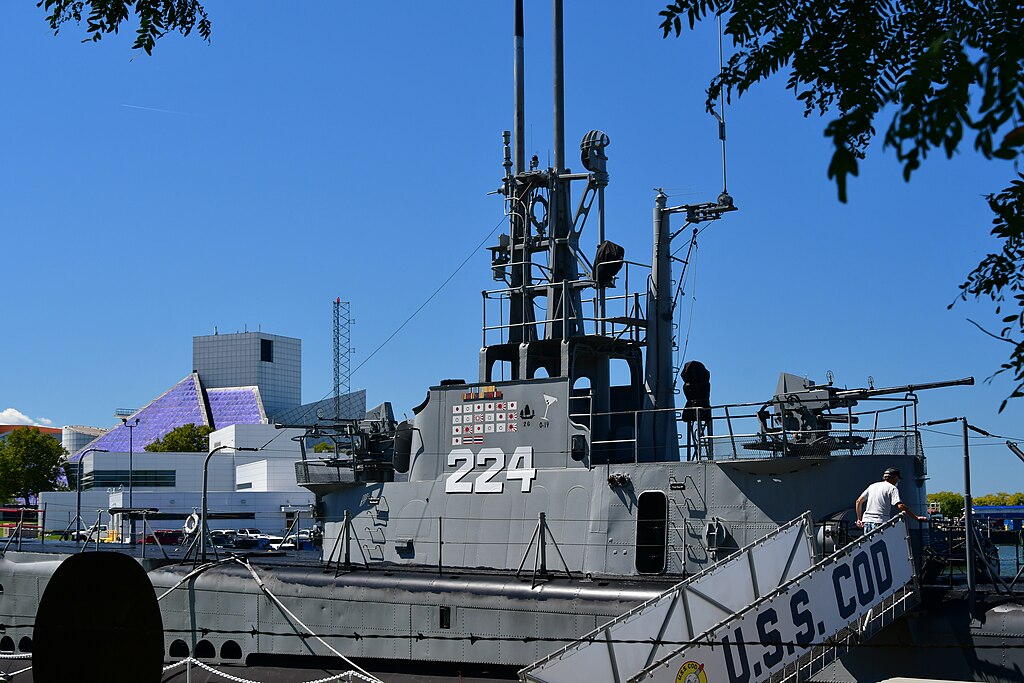
USS Cod as preserved, sporting a late CT
At the start of the war, Gato, Gar and Tambor classes shared the same fully shrouded fairwaters of visually similar appearance but war experience led to their progressive reduction at frst to reduce their visibility and radar profile when surfaced, at the expense of underwater performance and foul-weather operating comfort. But this enabled the subs to dive faster, and also enabled to create new AA platforms that were urgently needed, as well as creating structure to support larger radar masts. This led to a serie of detailed modifications that were dificult to track and ot always standardized.
As masterfully explained on a navsource document, the Gato class had their designed “frozed” just after the early batch FY41 before mass production and reassess their exterior architecture. The original fairwater was large and bulky, for better protection for the periscopes watchstanders and support as well as radio antennas and also allegedly to reduce drag, smooth the water flow, increase submerged speed. However. But there were calls to reduce it in 1939 already, null due to bureaucratic inertia. This changed in wartime, and the Gato class went on in their first war patrols with the original configuration (mod 1).
Mod 1:
Designed CT with enclosed piltohouse complete with wheelhouse and portholes, bridge behind and above, enclosed shears for pereiscopes, curved and long bulwark aft and induction valves inside the fairwater as well s a cutout to access to the CT and bridge deck from the main deck below. On the hull, there were also half-moon limber holes at the base of the outer hull. There were late conversions to lafer mods, so it was not unheard of to sea an early SD radar fitted on a mast, and a new angled bulwark. Later an SJ radar mast was sometimes anchored to the existing fairwater. On the hull, the half-moon were replaced by a double row of oval shape limber holes. Angled bulwarks were more common on Government’s boats.
Mod 1A:
Mostly a change for a smaller pilthouse, reducing the forward section of the conning tower. Applied on USS Guardfish and Peto (Maniwotoc).
Mod 2:
Fairwater partly cut down, new SJ masts and brachets added forward of it, and tall SD radar mast aft of it embedded, but with a small platform and handbars for a lookout. USS Wahoo was the first modified that way.
Mod 2A:
It consisted in removing the fairwater entirely, with unplated and thickened shears with always the SJ radar forward and SD radar aft. This left the structural “skeleton” apparent while the rest of the conning tower was shortened and the aft bulwark removed in some cases, plus a Mk 5 mount for a 20 mm AA gun replacing the Brownings. The boats so modified also sometiles had the 4-in gun swap as well, located aft or forward, if available. USS Tunny and Pogy for example were modified that way by mid-1942.
Mod 3:
This was the most recoignisable modification, by the full removal of the fairing around the pilothouse and former surface steering station. In short, not pilothouse at all (considered as redundant as the captain could communicate easily with the Command center below and submarine drivers), and instead a platform was created to support a Mark 5 20 mm AA gun mount, making two, one forward, one aft. All remaining bulwark was cut away. There was a small walkway platform around the top of the support around the periscope “lattice” for lookouts. Some boats however had had a portion of bulwrk retained and half-moon cutouts to fill the bridge’s structuren acting also as windows. There were also extra ammunition storage lockers instealled forward. USS Gato was modified that way in mid-1943. Many which still had their original 3-in/50 swa it swapped for a 4-in.40 mark 9, placed forward. Some also had their Mark 5 AA mount replaced b Mark 10 mounts.
Mod 3A:
Detailed modifications from the above, notably the watertight access door for the gun crew at the after end of the CT was a liability in combat and could be unseated in depth charge attack and cause rapid flooding. It was eliminated in the spring of 1943 from all boats and ported in construction. There was a new outward dished convex aft end for the CT. This also provisonally increased room in the conning tower but access to the deck gun proved more tricky. Also the The SD radar mast was moved aft, out of the CT, with a new mast installed on the cigarette deck, also benefiting from a better azimuth, with its mount still attached to the CT. This was mostly done from late 1944 onwards.
Also in 1944, some boats obtained a swap to the 5-in/25 deck gun. It was located forward. Some had their forward 20 mm Oerlikon mount reeplaced by a Mark 1/2 mount for a 40 mm Bofors, despite the lack of space on this forward platform. A 20 mm was kept aft, unshielded of course due to drag when diving. Further sub-mods performed in 1945 consisted in fitting the new SV radar with its larger mesh-wire antenna, additional ammo lockers (notably the 40 mm rounds were much larger), new lookout posts, spindle mounts for Browning M2 AA HMGs. There was also a swap on some boats, with the 5-in/25 main gun relocated aft, to make room for an extra 20 mm AA mount Mark 10 instead, making for one Bofors, two Oerlikons, up to four 0.5 inch HMGs, quite an impressive AA defence.
Mod 4:
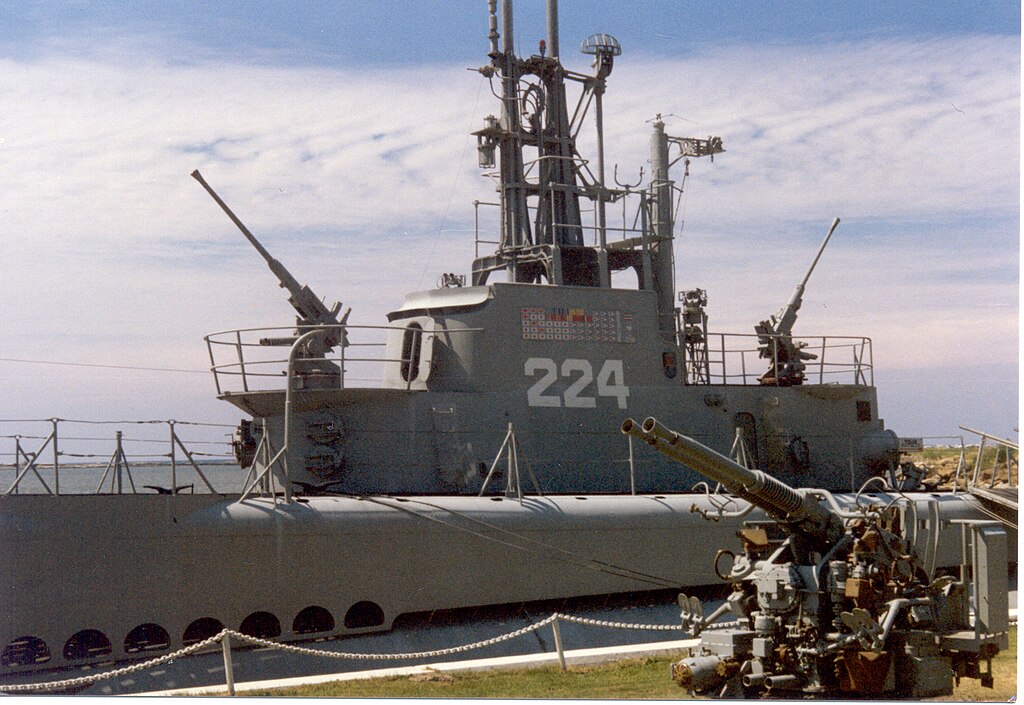
The bridge is lowered to even make the silhouette less apparent. Plating was removed, this caused to expose the I-beams of the persicope shears. This was done on some boats by early to mid-1944 onwards. On some boats, the lookput platform was made larger using the now apparent transverse I-beams as supports, Modifications done to the forward section of the lowered bridge with a new access door and ammunition scuttle, new lower ammunition storage lockers, 4-in/50 froward, 20 mm Mark 10 mount on the forward PF and same aft plus a TBT stand and rear ammunition storage locker.
Mod 4A:
Both radar masts (SJ-1 and SV) out of the shears, modified lookout platforms, wind venturi forward of the bridge (with several variants), and the hull modified with upper rows of small circular limber holes (on USS Cero, Dace, Albacore, Scamp first) to accelerate the outer hull filling. Some obtained an APR stub antenna for enemy radar detection forward of the shears. On some also an RDF loop antenna was also installed. On some boats, gun shields were installed on the Mark 10 gun mounts for and aft. There were no “mod 5” but the Tench and Balao received all these mods while in construction. There were also countless variations of the modifications above between ships.
In addition, some boats lost one of their anchors and the hawse hole plated over, some had their their bow planes modified to decrease diving times and modified stowage. The original mine cable cutters installed were retractable and stowed either side of the bow on the upper edge of the superstructure forward of the bow planes, and above the torpedo tube outer doors. They could be mounted if needed, but this was never done. This concerned only early batches, 20 boats total. This equipment was later judged “frivolous” and eliminated altogether.
Read more here (true treasure of info on these changes)
The Gato class in action
With 77 commissioned Gato class subs from November 1941 (Drum) through April 1944 (Croaker), 20 were lost, out of 52 lost in World War II, and to this is added USS Halibut, badly damaged, returned home but considered a constructive total loss and later stricken. This was of course a sizeable proportion, but lesser than other classes, and on par with the large number commissioned and seeing extensive service, like prewar and interwar boats. This is far less than the next Tench and Balao (14/120 and 1/29).
The GATO ckass served in the Pacific in majority but a smaller proportion also served in the Atlantic, with the main advantage of very long patrols acrosss the more restricted Atlantic. The Gato class is most successful submarine in US history, achieving the score of 600,000 tons of merchant shipping sunk according to some sources, other goinf down to 200,000 tons of shipping, not counting military targets. They collectively sank more warships, including aircraft carriers, than any other submarines.
Atlantic Gatos
All of the Gatos (with the exception of USS Dorado) would eventually made at least one round of operation in the Pacific Theater. However, by the summer of 1942, six brand new Gatos started their service, assigned to Submarine Squadron 50 at Rosneath, Scotland. There, they were deployed into the Bay of Biscay to try to cath German blockade runners from Bordeaux and other ports. They also assisted in Operation Torch landings in North Africa, securing the flanks of the fleet against possible Axis attacks. 27 war patrols were condicted by no verified sinkings. This was soon considered a waste since British submarines were already present in force in this theater, and recalled to the pacific in mid-1943.
Pacific Gatos
USS Cod’s gallery (cc)
By mid-to-late 1942, the Gatos were now the most numerous class in service, more frequent than the previous Tambor class. But since the latter were quite close in design and speed, they were often associated in wolfpack later in the war. Given their long service records and many patrols (up to 20 for some), USS Flasher, Rasher, and Barb were second, third, and fourth most sucessful US submarines in tonnage sunk. USS Silversides, Flasher, and Wahoo were 3rd, 4rth, and 7th in that list. That’s why they are more developed in detail in the career section. The Gato-class also sunk more Japanese subs than any other type, the I-29, I-168, I-351, and I-42, but USS Corvina lost to I-176.
They used the Mark 14 torpedo from 1942 onwards, at first with great frustration (see the part on these above) so that many subs still operated as much as the older Mark 10 as possible before issues were solved by mid-1943. From late-1943 the electric Mark 18 torpedo made its entry and proved deadly but not reliable either. With hindsight, the lack of proper testing by the Naval Torpedo Station Newport under the Bureau of Ordnance seemed unforgivable, as many sub captain took great risks and depht charge attacks to make dangerous approaches and assumed kills that were denied by their faulty torpedoes. But it shoukd reminded that work started in 1931 in a budget-restricted context thhat lasted until 1939. The lack of proper testing was a combination of resources and complacency.
Only the pressure in early 1942 of skippers returning from missions eventually made BuOrd cave in. By late 1943 there were all solved.
The Mark 18 electric torpedo however was a hastily copied German G7e, rushed into service and equally problematic, starting with the G7e own faults. Overall its biggest issue was a tendency to run in a circular pattern, come back at the launching sub. It was perfected, and became reliable later in 1944, so after a difficult start and few success, the US submarine arm started to sink an enormous amount of Japanese shipping with the peak reached in 1944-45. This also explains why the IJN was so late taking ASW seriously.
The Gatos were received a lot of modifications to improve their combat effectiveness, notably a new ballisitic computer, a rebuilt conning tower fairwater, new AA platforms, radars, and heavier guns, the 4-in/50 and later 5-in/25. They were used against sampans or all targets not worth a torpedo, by the judgment of the skipper. Skipper only had the 3-inch (76 mm)/50 caliber Mk. 17 or old Mk.6 mounts for a start, and hesistated to engage surface targets, while at the same time, having torpedo issues, explaining the weak result achieved in 1942 and up to mid-1943. War experience and deactivation of older S-class led to dismount their 4-inch (100 mm)/50 caliber Mk. 9 guns and remount them in Gato class boats.
From there, Skippers became less timid in the use of deck gun, albeit having stric instruction of not engaging vessels above a certain tonnage. 2000+ tons Cargos could be armed with 100 to 127 mm guns after all. By late 1943, almost all were refitted with a 5-inch (130 mm)/25 caliber Mk. 17 gun, with even some Gato class complementing thei deck with two of these, oe one 4-in and one 5-in, albeit most often than not, the Bofors 40 mm was preferred due to its high rate of fire, being equally devastating in a superstructure.
The Gato/Tench/Balao representing the bulk of the US submarine force in WW2, they are credited by 540,192 tons or 30% of the Japanese navy and 4,779,902 tons of shipping, or 54.6% of all Japanese shipping in the Pacific Theater.
Doctrine
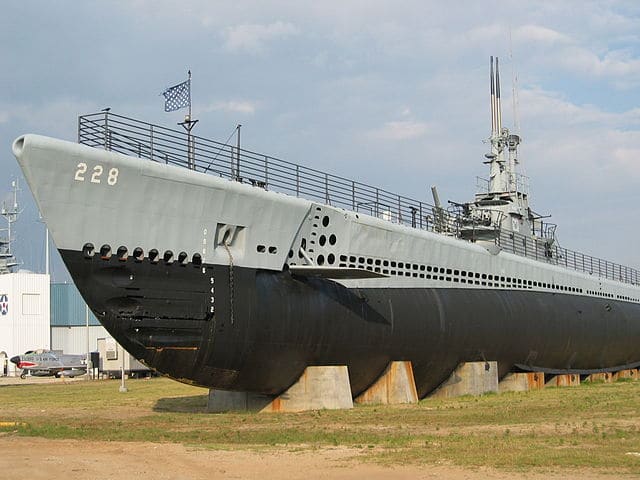
USS Drum, SS-228 preserved in Mobile, Alabama
Initially fleet submarines were to protect the US Fleet while on patrol. However, after Pearl Harbor, fleet tactics drastically changed. Without a battle fleet, they were found unable to fulfill their initial mission, but the “fleet sub faction” represented by Lockwood, argued to the naval staff that Fleet submarines were perfectly suite for a war on Japanese trade and valuable assets. Japanese merchant shipping was thus designed as their new primary target. A complete change of mission that simplified a lot of nitty-grity aspects of the perfect paper tactics developed in wargame.
Instead of tedious coordination with the fleet under strict position orders, skippers were now free to roam a designated area in “free hunt”. It was still directed and managed from higher-ups, but commanders now had a far greater margin to operate. Information sharing soon helped identifying the major Japanese liens of communication and strategic ports, and helped defining these hunting areas.
Gato Class submarines were sent on patrol, based out of Hawaii, Australia, the Philippines for a short while (mostly interwar boats). They also operated at first from the Java Sea to the Sea of Japan and everywhere in between. The greenlight came from CNO Admiral King, which on 7 December 1941 ordered the navy to “execute unrestricted air and submarine warfare against Japan”.
It was on shaky ground at first, since not approved by the Government, as the USN was still bound by the London Naval Treaty signed by the White House, dictating “prize rules” law. However it was considered that as IJN transports were all armed, they were considered auxiliary and thus excluded from the treaty.
But at many occasions, Gato class subs sank ships that were carried POWs or “Hell ships”, and the Japanese betrayed the Geneva convention by not having them clearly marked. Many small sampans, barges, trawlers, small steamers, schooner, and all kind of “naval dust” was also gunned down when surfaced, without much attention paid to them carrying any armament.
Wolfpack Tactics
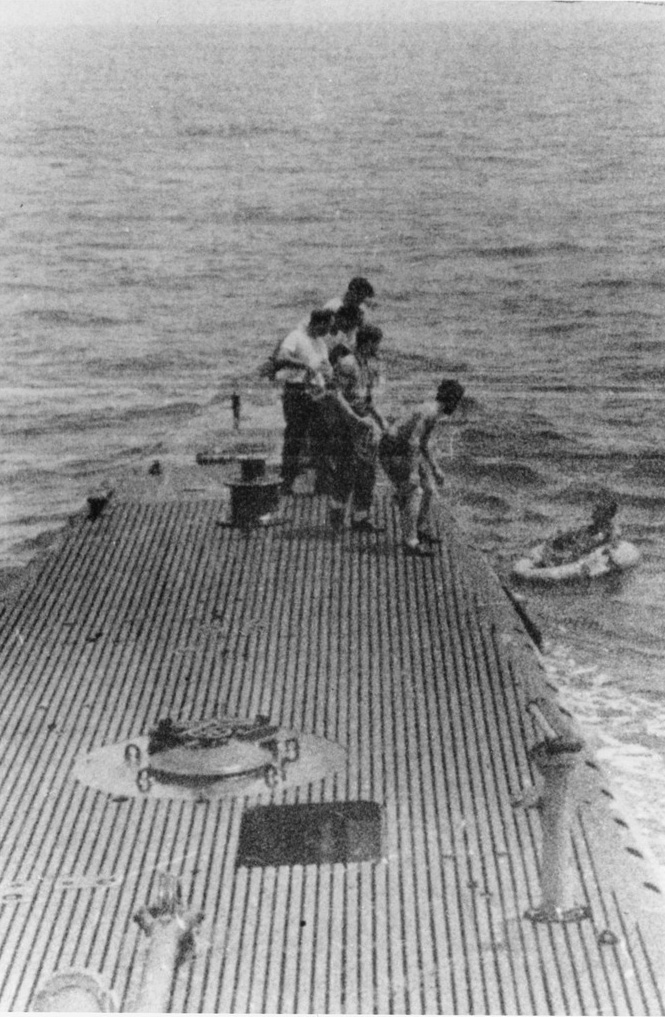
Future Pdt. Georges Bush being rescued by USS Finback after loosing his Avenger. Note the tech deck. As production went on, low grade steel was substituted due to the shortage. Plane guard was a common duty from mid-1944.
In the Pacific the United States Navy started with individual patrols, but as soon as German practices were known, and from common tactical sense, started to develop pack tactics. The South West Pacific command (SoWePac), under Rear-Admiral Ralph Christie in Brisbane and Fremantle favored individual patrol, the Central Pacific command, under Rear Admiral Charles Lockwood, Pearl Harbor (SubPac) promoted pack tactic.
In the USN parlance of the day they were called “coordinated attack groups” from a pair to three boats patrolling in close company, organized before leaving port under an overall command by the senior captain of the three. “Swede” Momsen devised early US wolfpack tactics with USS Cero, Shad and Grayback operating from Midway on 1 October 1943. These groups were able to provide a larger recon area, report positions of onvoys for the other to come and were mutually supportive. These tactics were applied on Japanese convoys with night attacks given their top speed of 21 knots, more than German submarines.
Some of the pack commander to develop an esprit de corps, gave their formation a name sometimes inspired by sport teams, but mostly based from the group commander. The one led by USS Growler under Cdr. “Ben” Oakley with USS Sealion and Pampanito became the “Ben’s Busters”. The Shark, Seadragon, and Blackfish became “Blakely’s Behemoths”. More on this topic.
Gato class Feats
-USS Albacore sank IJN Taihō, flagship of Vice-Admiral Jisaburo Ozawa’s flee at the Battle of the Philippine Sea and latest carrier.
-USS Barb, on her 12th patrol (July 1945) landed a spec ops team at Patience Bay on Karafuto which destroyed a railroad track on mainland Japan and tested rocket attacks against shore target also on Japan with 5-inch (130 mm) unguided rockets from special submerged launching racks on the main deck.
-USS Cavalla sank IJN Shōkaku.
-USS Cobia sank a troopship with crucial reinforcements to Iwo Jima.
-USS Cod rescued the crew of HNLMS O-19, and destroyed her after she ran aground.
-USS Corvina sunk I-176.
-USS Darter and Dace wolfpack before the Philippines offensice of October 1944 was very efficient as they sank Atago and Maya, severely damaged Takao.
-USS Finback recovered LTJG George H. W. Bush, future President of the United States off Chichi-jima.
-USS Flasher became the second-highest scoring U.S. ship (100,231 tons JANAC).
-USS Growler’s skipper Howard W. Gilmore, received a Medal of Honor for sacrificing his life to save his boat and his crew, ordering his crew below (while attacked by aircraft, wounded and alone in the CT) to dive and closed the hatch.
-USS Grunion’s skipper, Mannert L. Abele earned a Navy Cross, dying on a surface engagement off Kiska in July 1942.
-USS Halibut ws badly damaged and only one decommissioned after surviving an attack, declared a total constructive loss in July 1945.
-USS Harder’s skipper Samuel D. Dealey, sank five enemy destroyers, inc. four in a single patrol.
-USS Mingo, saw another career in the JMSDF postwar as Kuroshio.
-USS Rasher sank the 3rd/2nd tonnage in WW2.
-USS Silversides sank 23 ships, 3rd of all allied subms behind USS Tang and Tautog.
-USS Tunny sank I-42 after a night surface duel for over an hour. She also crippled later IJN Musashi.
-USS Wahoo under Dudley W. “Mush” Morton, destroyed an entire convoy undersea and surface for hours (4 ships) off New Guinea.
Gato class Top Scorers
The lead boat was USS Tang, a Balao class with 116,454t sunk in WW2.
The following are Gato class unless stated otherwise.
USS Flasher: 100,231, 2nd rank
USS Rasher: 99,901t, 3rd
USS Barb: 96,628t, 4th
USS Silversides: 90,080t, 5th.
(6th USS Spadefish Balao-class -88,091 t)
USS Trigger: 86,552 7th
USS Drum: 80,580t, 8th
USS Jack: 76,687t, 9th
USS Snook: 75,473t, 10th.
USS Tautog was 11th, Seahorse (Balao) 12th
USS Guardfish: 72,424t, 13th.
USS Seawolf (Sargo) was 14th
Gudgedon (Tambor) 15th, Sealion (Balao) 17th, the two Tambor.
USS Tinosa sank 64,655t (18th)
USS Pogy sank 62,633t and was 20th
USS Bonefish sank 61,345t, 21th
USS Wahoo sank 60,038t, 22th
USS Sunfish sank 59,815t, 23th.
The list is closed by USS Archerfish (Balao) at 59,800t.
The first point brought us inevitably to this list, which is still contested by modern historians, many considering JANAC record to be “shaky”.
WW2 Radar Picket Boats
With Kamikaze attacks and air raids becoming more frequent, six Gatos were increased in length by 24 feet and had their aft torpedoes removed, to make room for more radar equipment and their associated electric generator. This allowed for early warning against aircraft for American fleets.
The Gato class Postwar: Fleet Snorkel
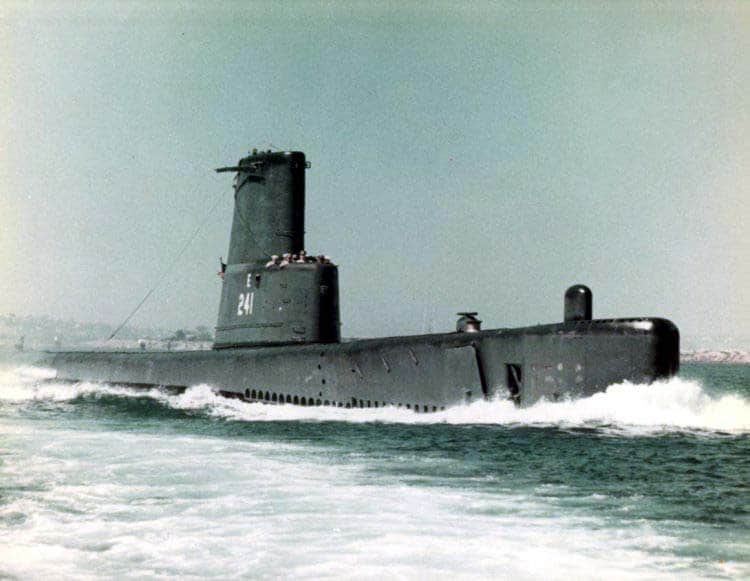
USS Bashaw as a GUPYY II in the cold war
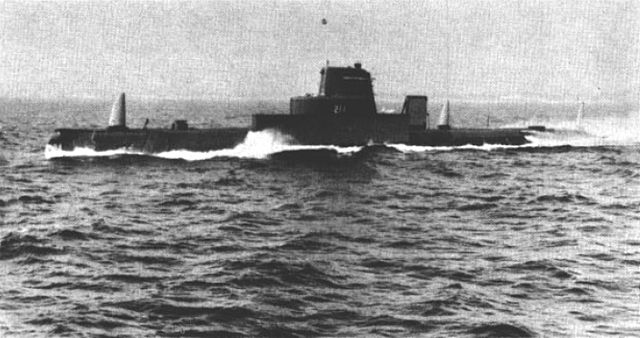
USS Grouper as AGSS-214, underway circa 1961
At the end of World War II, the 56 remaining Gato-class submarines were both now obsolete, and without adversary, depite being only a two to four years old. The Type XXI was tested and showed the way forward, and a classic diesel-electric sub only capable of 300-foot test depth and 9 knots at best underwater was now irrelevant. Balao and Tench ships had a greater diving depth leaving the Gatos unable to do front-line missions, added to the fact unlike the Tench in particular, they had been already worn out by the punishing wartime conditions. The Greater Underwater Propulsion Power Program or GUPPY modernization program was not applied to them apart USS Barb and Dace, but of the austere GUPPY IB modernization under project SCB 47A before being sold to the Italian Navy under MDAP. The Gatos were reactivated however to take bak the roles oin which the old S-class were in at the end of the interwar and WW2, first and foremost, training. The last two Gato-class actived were USS Rock and Bashaw, decommissioned on 13 September 1969.
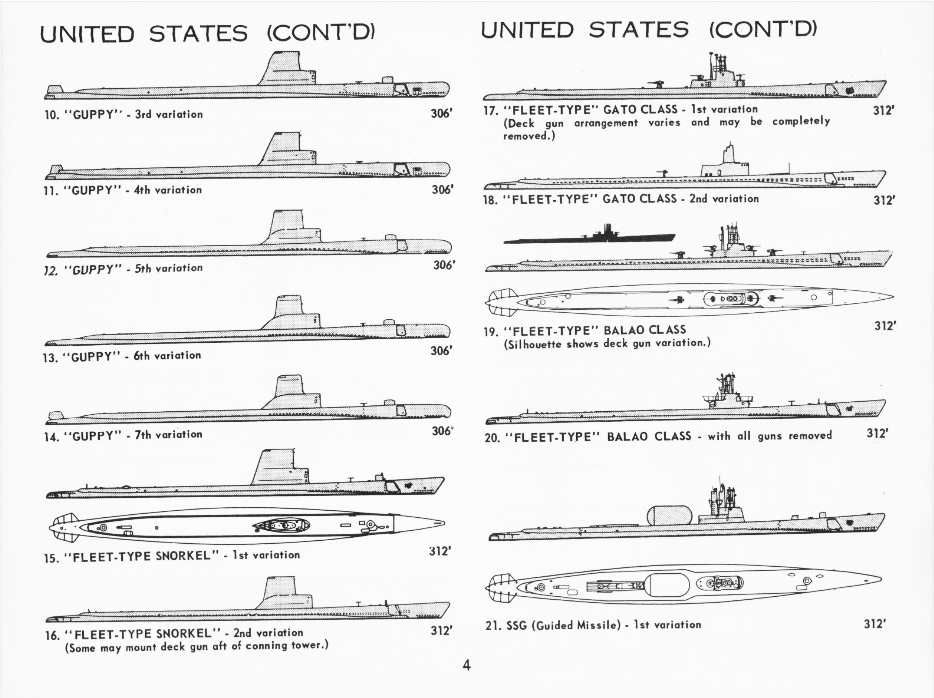
Postwar ONI recce book on Gato/Tench/Balao variants
GUPPY Ia/Ib

GUPPY Ib Enrico Tazzoli, ex USS Barb. A good example of a limited modernization for cold war service. USS dace became Leonardo Da Vinci. The GUPPY IB program of 1953-1955 was n interim conversion intended for export. They had a snorkels and were otherwise like the GUPPY IA, but with no modern sonar or fire control systems among others, truly “austere” versions. The other two went to the Netherlands as the ex USS Hawkbill (HNLMS Zeeleeuw) and USS Icefish (HNLMS Walrus).
Hunter Killer Boats
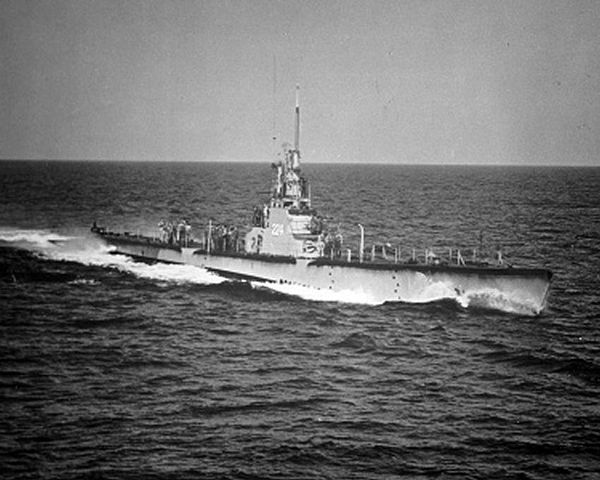
USS Cod postwar
The 215-strong Soviet Whiskey class submarines and thos following in the Atlantic led the U.S. Navy to adapt submarines for the role of hunter killer instead of preying on trade lines, since the USSR had a limited merchant fleet. This radically new role was not new as the first sub-huners were prioneered by Britain with the R class back in 1916. Modifications were aimed at given them greater speed and deep-diving capability. In all, seven Gato class were converted to SSKs (hunter-killer submarines) between 1951 and 1953. They joined the dedicated K-1-class SSKs of the 1950s. The were taken from the reserve fleet for rapid mobilization instead of the Balao/Tench retained for the GUPPY conversions.
The SSK received the following modifications:
-Streamlined GUPPY-style sail.
-Large sonar array wrapped around the bow (two torpedo tubes removed)
-Extensive silencing, removal of the two forward diesel engines, snorkel.
USS Grouper was converted under project SCB 58 as the test boat. She had her sonar array at the forward end of the sail. Next followed USS Angler, Bashaw, Bluegill, Bream, Cavalla, and Croaker. But sonar progress was considerable, with USS Tullibee commissioned in 1960 introduced a full bow-mounted sonar sphere. High cost prevented follow-ups and instead the SSNs of the Permit/Thresher class retook the missions of the SSK mission. They were decommissioned or reassigned to training from 1959. USS Croaker and Cavalla were preserved as memorials, the remainder scrapped in 1968-1969.[
SSG Conversions
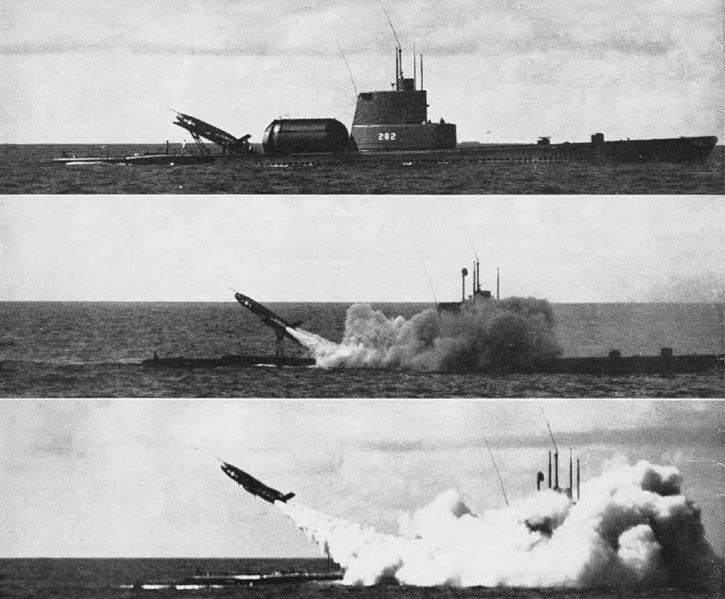
USS Tunny, SSG-282 Regulus launching sequence
Guided Missile Carrier and Transport
In 1953, the single USS Tunny was converted to fire Regulus nuclear missiles. She was the first submarine deterrence asset of the USN until 1964, as beter boats appeared, including the first of the “47 for freedom” classic SSBNs. Needless to day being diesel subs these early conversion were easy to detect. She was thus converted to transport UDT/SEAL teams.
The Regulus nuclear cruise missile program led to the conversion under under SCB 28 in 1953 adn the USN found a new designation of SSG (guided-missile submarine) which disappeared until four ex-Ohio class SSBNs were converted due to nuclear disarmament treaties. USS Tuny was modified to carry a cylindrical hangar instead of canisters on her deck, with two Regulus missile side by side, performing until the Polaris program took over.
UDT/SEAL Transport submarine
With the retirement of the Regulus in 1965, USS Tunny was converted again, keeping her hangar, converted now as a UDT (Demolition teams used before a landing) and SEAL diver transport in 1966, redesignated APSS-282, replacing USS Perch. The hangar was converted into a lockout chamber with pumps. It was also tested by Marine Force Recon teams in the Vietnam War. On 1 January 1969, she became LPSS-282 (amphibious transport submarine) until replaced by anoother Regilus program orphan, USS Grayback. After probably the longest career of any Gato class, USS Tunny was decommissioned in June 1969. She was not preserved.
Submarine oiler
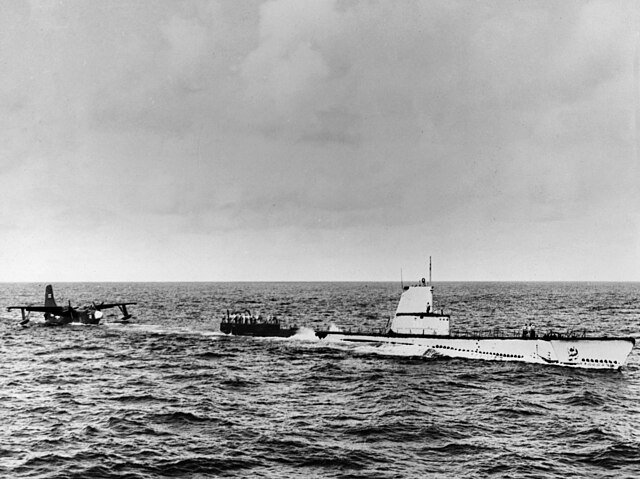
Guavina (AGSS-362), refueling a P5M Marlin flying boat in 1955
USS Guavina was converted under SCB 39 program inti an SSO in 1950, carrying fuel oil, gasoline, cargo, up to amphibious beachheads. Her additional saddle tanks on the outer hull carried extra fuel. Like a GUPPY she also had a streamlined sail. After a few tests, the program was terminated in 1951 as impractical. USS Guavina was used for other tests as AGSS-362. In 1957, she became once again an oiler/tanker as AOSS-362, this time to refuel US diesel subs at sea, like the WW2 German Type XIV did, but soon this was dropped and she was instead use to refuel seaplanes at sea, notably the new jet seaplane prototype, nuclear-capable Martin P6M Seamaster. A last hurrah of the USN for strategic strikes out at sea. She was was decommissioned as the Seamaster program was terminated.
Sonar test submarine

Grouper after conversion to a sonar test submarine
The development of advanced sonar systems in the 1950s led to take several reserve Gato class for experiments. They were outfitted with various sonar transducer arrays. USS Flying Fish and USS Grouper proved to be key players in sonar R&D. USS Grouper lost all her forward torpedo tubes and the freed spane was used for technicians as a sonar lab. USS Flying Fish was decommissioned in 1954, but Grouper soldiered on until 1968.
The other case was USS Flying Fish.
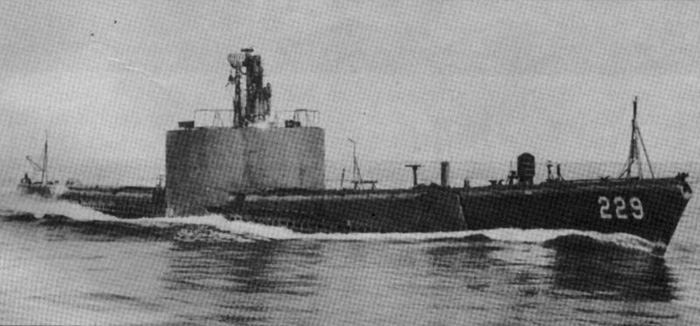
With lines reminiscent of the Civil War’s Monitor, the Flying Fish (AGSS-229) was fitted with a unique round conning tower containing experimental sonar equipment.” This is the sonar salvaged from the Prinz Eugen. (US Navy photo/ Sea Classics Magazine).
Naval Reserve trainer
In case of war, the USN like to keep a large reservists force, and assigned many ex-Gatos for this role, going from coastal and inland ports (even in the Great Lakes) as training platform in weekend drills. Twenty-eight Gato-class performed as such until 1971 for some. The ones permanently berthed had their propellers and pumps removed as pierside trainers. Their status was “in commission in reserve”.
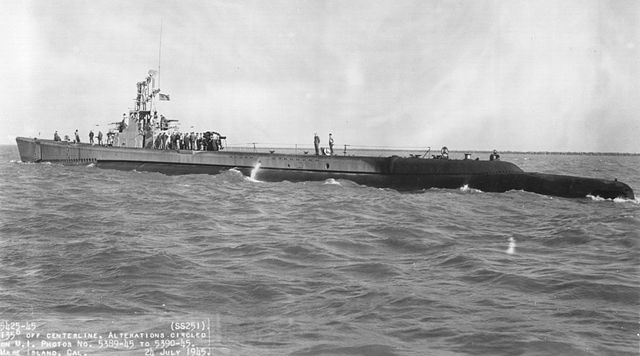
USS Flounder, SS-251, July 1945
Migraine Conversions
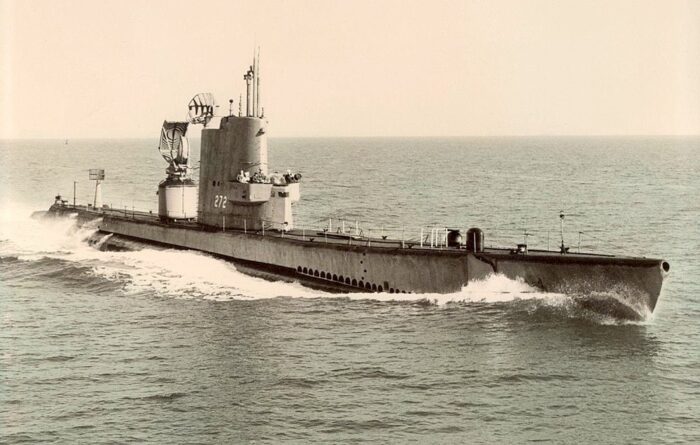
USS Redfin as a MIGRAINE III boat
The kamikaze threat in the last two years of the war in the Pacific led navy top brass to ask for a greater radar cover. A radar-carrying ships would have been an easy target, so submarines were perferred in this role, having the ability to quickly submerge. Several subs were converted (some destroyers were used as such but judged too vulnerable) to provided a long-range radar umbrella around the fleet. The Gato class converted received powerful radar suites were put into service, and the prototypes were USS Grouper and Finback. These were rudimentary conversions but they were ultimately never used in this role. After them, four Balao and Tench-class were so converted in 1945 (Projects Migraine I and II).
Six Gatos, USS Pompon, Rasher, Raton, Ray, Redfin, and Rock were converted postwar as Project Migraine III (aka SCB 12A), lengthened by 24 feet (7.3 m) for adding an additional air control center and powerful air-search/height-finding radars. The after torpedo room ended as electronics space and they also adopted the new streamlined sail of the GUPPY. Next designations were “SSRs”. But they were moderately successful due to their radars. They were returned briefly as fleet subs in 1959. Read More
Exports: The Gato class under other flags
The Gato class were essentially surplus and soon were offered on sale, loan, lease, notably under MDAP to allied foreign navies. Most of the time, Balao and Tench classes were preferred, and only a few Gatos served under other flags. For the Marina Militare, these were the USS Barb and Dace under Guppy IB). Japan received USS Mingo in “stock” conditions, and one can image the reaction of former Japanese submarine veterans on board. Brazil received USS Muskallunge and Paddle also in original conditions, Greece received USS Lapon and Jack, Turkey USS Guitarro and Hammerhead which were “fleet snorkels” with partial streamlining, on the fairwater. A very austere modernization.
Legacy: Surviving Boats
Six Gato-class submarines survived as living testimony of the other 70 which operated duiring the war. They are all open to public viewing and their general state and features depends of the revenue generated by visitors, to remained to U.S. Navy standards, with a yearly inspection and “report card”. USS Cod and Silversides were used for movies.
The following is a complete list of Gato-class museum ships:
-USS Cavalla is on display at Seawolf Park in Pelican Island, Texas. (SSK configuration).
-USS Cobia is on display the Wisconsin Maritime Museum in Manitowoc, Wisconsin.
-USS Cod is on display at Cleveland’s North Coast Harbor in Cleveland, Ohio.
-USS Croaker is on display at the Buffalo and Erie County Naval & Military Park in Buffalo, New York (SSK configuration)
-USS Drum is on display on shore at Battleship Memorial Park in Mobile, Alabama.
-USS Silversides is on display at the USS Silversides Submarine Museum in Muskegon, Michigan.
 USS Gato (SS-212)
USS Gato (SS-212)

USS Gato, the lead ship, was ordered at the ame time as the other boats from Portsmouth but laid down at Electric Boat Company a bit later on 5 Oct 1940, to be launched on 21 Aug 1941 and completed on 31 Dec 1941. She was the class lead boat only by virtue of her number, first in class. She was not a “prototype” since the design cosely matched te previous Gar class. She was also one of the most successful in the USN, gaining 13 battle stars.
After shakedown at New London in the Connecticut, she departed on 16 February 1942 via the Panama Canal for San Francisco for additional training as part of the Pacific fleet. While at periscope depth off San Francisco Bay on 23 March 1942 she was mistook by an IJN submarine by a U.S. Navy TC-class blimp TC-13 and received four 325-pound (147 kg) depth charges, the first two landed within 50 yards (46 m) but the other two at 120 feet (37 m). Damage was considerable but she had no casualties. This became the one and only “blue on blue” incident implicating a USN blimp in this war.
After repairs at Mare Island she was underway on 27 March 1942 for Pearl Harbor ad soon was ready for her first war patrol from April to June 1942. She spotted but missed a converted aircraft carrier on 3 May but had to fled destroyers off the Marshall Islands. On 24 May 1942 she was on the western approaches to Midway, being 280 nautical miles (519 km; 322 mi) westward during the 3–7 June 1942 battle.
Her second war patrol from 2 July to 29 August 1942 was off the Kurile Islands (Aleutians) with a first unconfirmed ship on 15 August 1942. She ended her patrol at Dutch Harbor in Alaska.
Her third patrol from 4 September to 23 December 1942 brought her again in the north, off Kiska. She was then ordered to Truk and on 6 December ambushed a convoy already broken off air attacks. But she had to flee due to depth charge attack by three destroyers. She ended in Brisbane, Australia on 23 December 1942.
Her fourth war patrol from 13 January to 26 February 1943 saw the first successes: She sank transport Kenkon Maru on 21 January, Nichiun Maru on 29 January, Suruya Maru on 15 February off New Georgia.
Her fifth war patrol from 19 March to 6 June 1943 saw her landing an Australian intel party at Toep in Bougainville on 29 March 1943 while evacuateing 27 children, nine mothers, three nuns on 31 March, tansferred to the submarine chaser SC-531 off Ramos (Florida Is.). When in submerged radar attack approach on 4 April 1943 between Tanga and Lihir she took three depth charges which shook her so much she had to flee to Brisbane for temporary repairs in April. Later she landed Australian commandos at Toep Harbor on 29 May and repatriated evacuees to Ramos. She gathered intel off Tarawa, Gilberts, and ended at Pearl Harbor on 6 June 1943. She was sent home to be overhauled at Mare Island (modifications decribed above). Back to Pearl Harbor 22 August 1943 she started her 6th war patrol on 6 September, until 28 October, transiting via Truk and Bougainville and the Solomons to Brisbane. On 19 October she attacked a convoy, firing on two large cargo ships, no confirmed kill.
Her seventh war patrol started on 18 November 1943 until 10 January 1944, in the Bismarck Archipelago. On 30 November now teaming with USS Ray, she sank the Columbia Maru and later rescued a Japanese soldier from a life raft on 16 December. Next she attacked a convoy in the Saipan-Massau gap and sank the Tsuneshima Maru, damaging another freighter but took depht charge attacks for two hours.
She sailed for Tingmon and whensurfacing the crew discovered a live depth charge on her deck just as two enemy escorts were sighted close. She managed to outrun them, while disposing of the depth charge on a rubber raft. She spotted later another convoy but was spotted on 2 December 1943 by a float plane, driven off by AA fire. She ended in Milne Bay, New Guinea on 10 January 1944.
After R&R and supplies, she departed on 2 February 1944 for her 8th war patrol in the Bismarck sea and New Guinea-Truk area, rescuing downed airmen on 5 February. She sank a trawler off Truk (15 February) and the transport Daigen Maru No.3 on 26 February, cargo Okinoyama Maru No.3 on 12 March and by gunfire two other trawlers. She ended in Pearl Harbor on 1 April 1944.
Her 9th patrol started on 30 May until 2 June 1944, with the tansport of the new Pacific sub fleet CiC Vice Admiral Charles A. Lockwood to Midway. She was used for photographic reconnaissance of Woleai, lifeguard station for air strikes on Truk and ended her patrol at Majuro, the USN advanced base for TF 38.
Her 10th war patrol was again in lifeguard duty on 15 July 1944 for the air attacks on Chichi Jima, rescuing two aviators. Back to Pearl Harbor on 2 September 1944 she had another overhaul at Mare Island and was back to Pearl Harbor.
Her 11th war patrol started on 28 January 1945 and ended on 13 March in the Yellow Sea as part of a “wolf pack” with USS Jallao (SS-368) and Sunfish (SS-281). She sank a coast defense ship on 14 February, the cargo ship Tairiku Maru on 21 February, and ended in Guam for R&R and supplies.
Her 12th patrol started on 12 April as lifeguard station (invasion of Okinawa). On 22-23 April she crossed path with two Japanese submarines, dodging their torpedoes but failed to respond. From 27 to 30 April she rescued 10 Army aviators off Cape Toi Misaki in Kyūshū. She was bacl at Pearl Harbor on 3 June 1945.
Her 13th and last war patrol started on 8 July, again lifeguard station duty for US carriers, striked on Wake Island, before patrolling on the eastern coast of Honshū. On 15 August she was aboit to attack a convoy when the ceasefire message was received. Respresenting her class she was present for the surrender ceremonies in Tokyo Bay on 31 August and until 2 September.
On the 3th she sailed to Pearl Harbor, crossed the Panama Canal to NYC Shipyard Brooklyn, decommissioned on 16 March 1946. She became a Reserve training vessel later transferred to Baltimore, eventually stricken on 1 March 1960, sold for BU on 25 July 1960.
 USS Greenling (SS-213)
USS Greenling (SS-213)
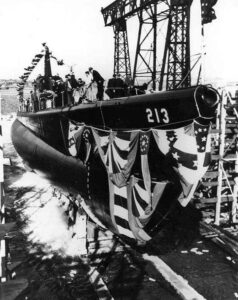 Greenling was laid down at EB on 12 Nov 1940, launched on 20 Sep 1941 and completed on 21 January 1942. She had a rocky start: After commission at Naval Submarine Base New London she was conducting shakedown training when mistook for a U-Boat and bombed on 28 February 1942 by a PBY-5A Catalina from VP-73. She left and on 7 March and arrived Pearl Harbor on 3 April, starting her first patorl on 20 April to the Marshall and Carolines. On July-August 1942 she operated in the Truk area. On her 3rd patrol on September–November 1942 she claimed Takusei Maru 14 October and narrowly escaped a circular pattern from one Mark 14. Her 4th patrol was on December 1942–January 1943, to Bougainvill/New britain, clmaiming Patrol Boat 35, Nissho Maru, hit later a tanker, and the transport Soya. She ended in brisbane for her 5 and 6th patrols, in Jan-July 1943, damaging Akebono Maru. She landed Marine Raiders at the Treasury Island on 22–23 August plus intel, and was overhauled back home, back in Dec. 1943 tp patrols 8 and 9 until May 1944 (Shōhō Maru), then 10-11th in July-Nov 1944 (Formosa wolfpack), then Tokyo water (Koto Maru, Kiri Maru, Patrol Boat 46.), 12th patrol until Jan 1945. Overhaul at Portsmouth NyD, decom. 16 October 1946 New London, 1st Naval District Portsmouth, training reservists until 18 March 1960, sold 16 June 1960 for BU. 10 battle stars.
Greenling was laid down at EB on 12 Nov 1940, launched on 20 Sep 1941 and completed on 21 January 1942. She had a rocky start: After commission at Naval Submarine Base New London she was conducting shakedown training when mistook for a U-Boat and bombed on 28 February 1942 by a PBY-5A Catalina from VP-73. She left and on 7 March and arrived Pearl Harbor on 3 April, starting her first patorl on 20 April to the Marshall and Carolines. On July-August 1942 she operated in the Truk area. On her 3rd patrol on September–November 1942 she claimed Takusei Maru 14 October and narrowly escaped a circular pattern from one Mark 14. Her 4th patrol was on December 1942–January 1943, to Bougainvill/New britain, clmaiming Patrol Boat 35, Nissho Maru, hit later a tanker, and the transport Soya. She ended in brisbane for her 5 and 6th patrols, in Jan-July 1943, damaging Akebono Maru. She landed Marine Raiders at the Treasury Island on 22–23 August plus intel, and was overhauled back home, back in Dec. 1943 tp patrols 8 and 9 until May 1944 (Shōhō Maru), then 10-11th in July-Nov 1944 (Formosa wolfpack), then Tokyo water (Koto Maru, Kiri Maru, Patrol Boat 46.), 12th patrol until Jan 1945. Overhaul at Portsmouth NyD, decom. 16 October 1946 New London, 1st Naval District Portsmouth, training reservists until 18 March 1960, sold 16 June 1960 for BU. 10 battle stars.
 USS Grouper (SS-214)
USS Grouper (SS-214)
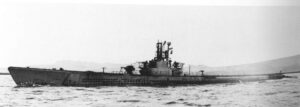 USS Grouper was laid down at EB on 28 Dec 1940, launched on 27 Oct. 1941 and completed, commissioned on 12 Feb 1942. At the time of the battle of Midway on 4 June, she sighted two burning enemy aircraft carriers but was too far away to attack. 2nd patrol: Tone Maru, Lisbon Maru. 3rd patrol from Bisbane: Bandoeng Maru. 4rd patrol (Jan March 43): Solomons, no luck. Later she landed 50 men and 3,000 lb of gear on New Britain for a raid. 30 July she wa smistook and attacked by B-25 Mitchell. October 1943 Overhaul. 9th patrol: Kumanoyama Maru. Ended her 12th and last war patrol on 26 April 1945. Reserve. 1950 became hunter-killer sub SSK-214. AGSS-214 1958-62, test boat until 1968, BU 1970. 10 battle stars.
USS Grouper was laid down at EB on 28 Dec 1940, launched on 27 Oct. 1941 and completed, commissioned on 12 Feb 1942. At the time of the battle of Midway on 4 June, she sighted two burning enemy aircraft carriers but was too far away to attack. 2nd patrol: Tone Maru, Lisbon Maru. 3rd patrol from Bisbane: Bandoeng Maru. 4rd patrol (Jan March 43): Solomons, no luck. Later she landed 50 men and 3,000 lb of gear on New Britain for a raid. 30 July she wa smistook and attacked by B-25 Mitchell. October 1943 Overhaul. 9th patrol: Kumanoyama Maru. Ended her 12th and last war patrol on 26 April 1945. Reserve. 1950 became hunter-killer sub SSK-214. AGSS-214 1958-62, test boat until 1968, BU 1970. 10 battle stars.
 USS Growler (SS-215)
USS Growler (SS-215)
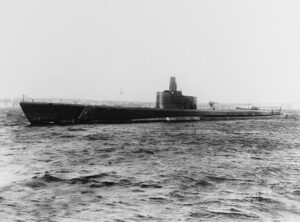 USS Growler was laid down at EB on 10 Feb. 1941, launched on 22 Nov. 1941 and commissioned on 20 March 1942. For her 1st patrol from June 1942 she was sent to Dutch Harbor, Alaska. Sank IJN DD Arare, damaged Kasumi and Shiranui. 2nd patrol Formosa (Eifuku Maru, Kashino, Taika Maru). 3rd patrol late 1942 Truk-Rabaul shipping lanes. 4th from Brisbane (Chifuku Maru, Hayasaki by ramming), repaired Bisbane, nicknamed Kangaroo Express. 5th, 6th, and 7th patrols from Brisbane, Bismarck-Solomons (Miyadono Maru). Pearl Harbor OVL. 9th patrl May-July 44 Philippines wolfpack (Katori Maru). 10th patrol in WP with Commander T.B. (“Ben”) Oakley sank the DD Shikinami, frigate Hirado. 11th patrol Oct.44 WP with USS Hake. Lost contact, lost probable circling torpedo or IJN Shigure, Chiburi, CD-19 in escort. 8 Battle stars.
USS Growler was laid down at EB on 10 Feb. 1941, launched on 22 Nov. 1941 and commissioned on 20 March 1942. For her 1st patrol from June 1942 she was sent to Dutch Harbor, Alaska. Sank IJN DD Arare, damaged Kasumi and Shiranui. 2nd patrol Formosa (Eifuku Maru, Kashino, Taika Maru). 3rd patrol late 1942 Truk-Rabaul shipping lanes. 4th from Brisbane (Chifuku Maru, Hayasaki by ramming), repaired Bisbane, nicknamed Kangaroo Express. 5th, 6th, and 7th patrols from Brisbane, Bismarck-Solomons (Miyadono Maru). Pearl Harbor OVL. 9th patrl May-July 44 Philippines wolfpack (Katori Maru). 10th patrol in WP with Commander T.B. (“Ben”) Oakley sank the DD Shikinami, frigate Hirado. 11th patrol Oct.44 WP with USS Hake. Lost contact, lost probable circling torpedo or IJN Shigure, Chiburi, CD-19 in escort. 8 Battle stars.
 USS Grunion (SS-216)
USS Grunion (SS-216)
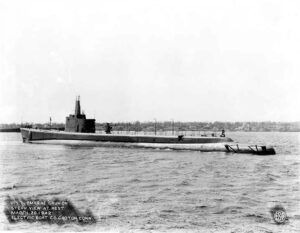 USS Grunion was laid down in 1 March 1941 at EB, launched on 22 Dec 1941 and completed on 11 April 1942. In May 42 while underway to the pacific she rescued 16 survivors from USAT Jack, torpedoed by U-558. 1st patrol Midway and Aleutians. Sank CH-25 and CH-27. On 30 July she was ordered back to Dutch Harbor but never heard from again, last seen off Kiska. 5 October reported overdue, assumed lost with all hands. Stricken 2 November 1942. Wreck rediscovered in August 2007.
USS Grunion was laid down in 1 March 1941 at EB, launched on 22 Dec 1941 and completed on 11 April 1942. In May 42 while underway to the pacific she rescued 16 survivors from USAT Jack, torpedoed by U-558. 1st patrol Midway and Aleutians. Sank CH-25 and CH-27. On 30 July she was ordered back to Dutch Harbor but never heard from again, last seen off Kiska. 5 October reported overdue, assumed lost with all hands. Stricken 2 November 1942. Wreck rediscovered in August 2007.
 USS Guardfish (SS-217)
USS Guardfish (SS-217)
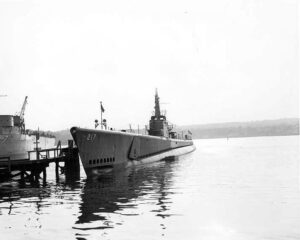 USS Guardfish was laid down on 1st April 1941, launched on 20 January 1942 and commissioned on 8 May 1942. 1st Patrol July 42 in Japanese waters (Seikai Maru, Kaimei Maru, Tenyu Maru, Chita Maru). 2nd patrol East China Sea: Nichiho Maru. Pdt Unit citation. 3-5th patrols Jan Aug 43: Sank OB No.1 (former Shimakaze) and U cargo ship and later DD IJN Hakaze. Base brisbane, Bismarcks, Solomons, and New Guinea, sank Suzuya Maru (hell ship). 6-7 patrols Bougainville (Kasha Maru), Jan Feb 44 Truk-Guadalcanal, claimed DD IJN Umikaze. 8-9 patorls June-Oct 44: Formosa Mantai Maru, Hizan Marun Jinsan Maru, Teiryu Maru. 2dn Pdt Citation. Sea of japan: Miyakawa Maru #2. 10-12th patrols Nov 44-June 45. Mistook, sank Extractor (ARS-15). Plane guard. 11 Battle stars after V-Day. Naval reserve, sunk as target ship for new torpedo off New London, 10 October 1961. Ranked 13th on 250 for highest tonnage.
USS Guardfish was laid down on 1st April 1941, launched on 20 January 1942 and commissioned on 8 May 1942. 1st Patrol July 42 in Japanese waters (Seikai Maru, Kaimei Maru, Tenyu Maru, Chita Maru). 2nd patrol East China Sea: Nichiho Maru. Pdt Unit citation. 3-5th patrols Jan Aug 43: Sank OB No.1 (former Shimakaze) and U cargo ship and later DD IJN Hakaze. Base brisbane, Bismarcks, Solomons, and New Guinea, sank Suzuya Maru (hell ship). 6-7 patrols Bougainville (Kasha Maru), Jan Feb 44 Truk-Guadalcanal, claimed DD IJN Umikaze. 8-9 patorls June-Oct 44: Formosa Mantai Maru, Hizan Marun Jinsan Maru, Teiryu Maru. 2dn Pdt Citation. Sea of japan: Miyakawa Maru #2. 10-12th patrols Nov 44-June 45. Mistook, sank Extractor (ARS-15). Plane guard. 11 Battle stars after V-Day. Naval reserve, sunk as target ship for new torpedo off New London, 10 October 1961. Ranked 13th on 250 for highest tonnage.
 USS Albacore (SS-218)
USS Albacore (SS-218)
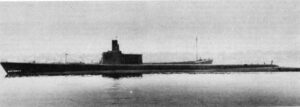 She was laid down on 21 April 1941 at EB, launched on 17 February 1942, commissioned on 1st June 1942. Presidential Unit Citation, 9 battle stars (9 patrols). Sank 13 ships (including the destroyers , light cruiser Tenryū, aircraft carrier Taihō) damaging 5. Top scorer, highest warship tonnage by any U.S. submarine. Lost in 1944 (probabe mine) November 7th, near the Tsugaru Strait.
She was laid down on 21 April 1941 at EB, launched on 17 February 1942, commissioned on 1st June 1942. Presidential Unit Citation, 9 battle stars (9 patrols). Sank 13 ships (including the destroyers , light cruiser Tenryū, aircraft carrier Taihō) damaging 5. Top scorer, highest warship tonnage by any U.S. submarine. Lost in 1944 (probabe mine) November 7th, near the Tsugaru Strait.
 USS Amberjack (SS-219)
USS Amberjack (SS-219)
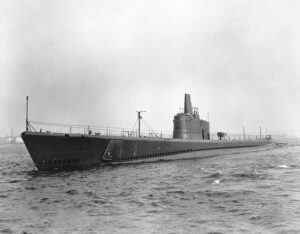 USS Amberjack was laid down on 15 May 1941, launched on 6 Mar 1942, commissioned on 19 June 1942. 1st patrol from Pearl Harbor in September, New Ireland, Bougainville, Solomons, Kiaveng, sank Shirogane Maru and later Senkai Maru. Refit Brisbane, Operations at Treasury Island. 4 February, reported sunk by gunfire a 5,000-ton freighter. Ordered Rabaul-Buka-Shortland Sea, last report, overdue, declared lost 22 March 1943 (probably sank by Hiyodori and SC Number 18). 3 Battle stars.
USS Amberjack was laid down on 15 May 1941, launched on 6 Mar 1942, commissioned on 19 June 1942. 1st patrol from Pearl Harbor in September, New Ireland, Bougainville, Solomons, Kiaveng, sank Shirogane Maru and later Senkai Maru. Refit Brisbane, Operations at Treasury Island. 4 February, reported sunk by gunfire a 5,000-ton freighter. Ordered Rabaul-Buka-Shortland Sea, last report, overdue, declared lost 22 March 1943 (probably sank by Hiyodori and SC Number 18). 3 Battle stars.
 USS Barb (SS-220)
USS Barb (SS-220)
USS Barb was laid down on 7 Jun 1941, launched on 2 Apr 1942 and commissioned in 8 July 1942. She became famous for pioneering sub-based spec ops. She compiled one an outstanding record with 12 war patrols, 17 enemy vessels for 96,628 tons (4th sub ace rank), including the carrier IJN Un’yō. One presidential Unit Citation, 7 battle stars. On her 12th and final patrol she landed a party who blew up a train, only ground combat operation on Japan proper. Postwar she was converted as a GUPPY in 1954 and in December she was sold to Italy under MDAP as Enrico Tazzoli, in service until 1972.
 USS Blackfish (SS-221)
USS Blackfish (SS-221)
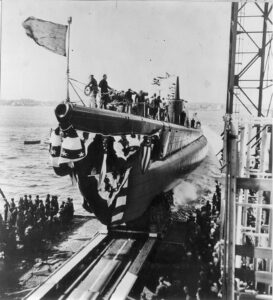 USS Blackfish was maid down on 1st July 1941, launched on 18 April 1942 and commissioned on 22 July 1942. She was one of the rare boats deployed in the Atlantic. She completed 5 war patrols in the Atlantic from October 1942 to July 1943, from Dakar to Iceland. She supported Operation Torch and sank the German V 408 Haltenbank off northern Spain in February 1943. Next in the Southwest Pacific from 19 October 1943 to 14 August 1945, she made 7n war patrols: Solomons, New Guinea, South China Sea, East China Sea, Yellow Sea. Sank a 2,087 GRT cargo. 1 battle star, decom. 1946, TS 1949-1955, sold 1959.
USS Blackfish was maid down on 1st July 1941, launched on 18 April 1942 and commissioned on 22 July 1942. She was one of the rare boats deployed in the Atlantic. She completed 5 war patrols in the Atlantic from October 1942 to July 1943, from Dakar to Iceland. She supported Operation Torch and sank the German V 408 Haltenbank off northern Spain in February 1943. Next in the Southwest Pacific from 19 October 1943 to 14 August 1945, she made 7n war patrols: Solomons, New Guinea, South China Sea, East China Sea, Yellow Sea. Sank a 2,087 GRT cargo. 1 battle star, decom. 1946, TS 1949-1955, sold 1959.
 USS Bluefish (SS-222)
USS Bluefish (SS-222)
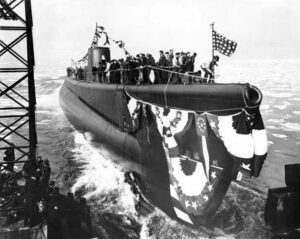 USS Bluefish was laid down on 5 June 1942 at EB, launched on 21 Feb. 1943 and commissioned on 24 May 1943. From 9 September 1943 to 29 July 1945 she completed nine war patrols from Netherlands East Indies to Honshū and according to JANAC she sank 12 ships totaling 50,839 tons. 10 battle stars. Recomm. 7 January 1952 at New London, SubDiv 82 Atlantic Fleet then subdiv 41 at Key West until May 1953. Sold for BU 1954.
USS Bluefish was laid down on 5 June 1942 at EB, launched on 21 Feb. 1943 and commissioned on 24 May 1943. From 9 September 1943 to 29 July 1945 she completed nine war patrols from Netherlands East Indies to Honshū and according to JANAC she sank 12 ships totaling 50,839 tons. 10 battle stars. Recomm. 7 January 1952 at New London, SubDiv 82 Atlantic Fleet then subdiv 41 at Key West until May 1953. Sold for BU 1954.
 USS Bonefish (SS-223)
USS Bonefish (SS-223)
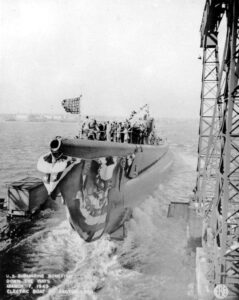 USS Bonefish was laid down on 25 June 1942, launched on 7 March 1943 and commmissioned on 31 May 1943. She started service from Brisbane in August 1943. 1st patrol: Kashima Maru, Chihaya Maru, Isuzugawa, Teibi Maru. 2nd patorl also South China Sea: Suez Maru (hell ship). Damaged at Celebes Nichiryo Maru, sank off Borneo Toyohime Maru. 3rd patorl Makassar st. sank Tonan Maru No. 2. 4th patrol Celebes, Davao, sank DD Inazuma. 5th patrol: schooner, sampan, damaged Kokuyo Maru. 6th patrol in WP sank Anjo Maru, Fushimi Maru. 7th patrol RAS. 8th patrol until June 1945 home waters, sank Oshikayama Maru, Konzan Maru, then reported missing, lost 18 June by ASW. 7 battle stars, 5 Navy unit commendations. She was an ace sub with 21st rank on 250, for 61345t according to JANAC.
USS Bonefish was laid down on 25 June 1942, launched on 7 March 1943 and commmissioned on 31 May 1943. She started service from Brisbane in August 1943. 1st patrol: Kashima Maru, Chihaya Maru, Isuzugawa, Teibi Maru. 2nd patorl also South China Sea: Suez Maru (hell ship). Damaged at Celebes Nichiryo Maru, sank off Borneo Toyohime Maru. 3rd patorl Makassar st. sank Tonan Maru No. 2. 4th patrol Celebes, Davao, sank DD Inazuma. 5th patrol: schooner, sampan, damaged Kokuyo Maru. 6th patrol in WP sank Anjo Maru, Fushimi Maru. 7th patrol RAS. 8th patrol until June 1945 home waters, sank Oshikayama Maru, Konzan Maru, then reported missing, lost 18 June by ASW. 7 battle stars, 5 Navy unit commendations. She was an ace sub with 21st rank on 250, for 61345t according to JANAC.
 USS Cod (SS-224)
USS Cod (SS-224)
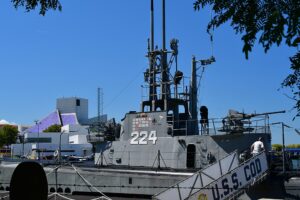 USS Cod, now preserved, was laid down on 21 Jul 1942, launched on 21 Mar 1943 and completed on 21 Jun 1943 under Commander James C. Dempsey, already famous for having sunk the first Japanese destroye on the old USS S-37 (SS-142). On 30 August 1943 she was mistook and fire upon by a Type C1-B cargo ship, SS Alcoa Patriot while under shakedown in the Caribbean off Barranquilla. She dived and escaped. three hours later, she was sighted and fired upon again off the northern entrance to the Panama Canal and escaped again.
USS Cod, now preserved, was laid down on 21 Jul 1942, launched on 21 Mar 1943 and completed on 21 Jun 1943 under Commander James C. Dempsey, already famous for having sunk the first Japanese destroye on the old USS S-37 (SS-142). On 30 August 1943 she was mistook and fire upon by a Type C1-B cargo ship, SS Alcoa Patriot while under shakedown in the Caribbean off Barranquilla. She dived and escaped. three hours later, she was sighted and fired upon again off the northern entrance to the Panama Canal and escaped again.
Her First patrol was between October 1943 and January 1944 from Brisbane, Australia, in the South China Sea, one attack, not hits on 29 November. After a short refit from 16 December 1943 to 11 January 1944 she started her Second patrol in February-March 1944 in the South China Sea, Java, and Halmahera. On the 16th she surfaced and sank a sampan by gunfire. On 23 February she sank an unidentified Japanese merchantman and another on 27 February later awared as Taisoku Maru (2,473 tons), later a third but had to escape depth charging. Her 3rd patrol was from March to June and on 6 April 1944 she was in Sulu Sea and South China Sea as well as off Luzon. On 10 May, she attacked a 32 ships convoy, sank the destroyer Karukaya and Shohei Maru (7,256 tons). She was back at Fremantle on 1 June 1944. Her 4th patrol was in the summer 1944, from the coast of Luzon to Java. She sank the converted net tender Seiko Maru on 3 August, the landing craft LSV-129 on 14 August and back on 25 August. Her 5th patrol was in September-November in Philippine waters, in support of the invasion. On 5 October she sank Tatsushiro Maru (6,886 tons) and later damaged a tanker. On 25 October she spotted a large convoy, launched, no hit. She resumed her patorl expecting to surface for next kills. She reported another convoy, then was in lifeguard station off Luzon during the strikes prior to the Battle of Leyte.
This time she headed for Pearl Harbor on 20 November and then Mare Island for an overhaul, back to Pearl Harbor on 7 March 1945.
Her 6th patrol from March to May 1945 was in the East China Sea in lifeguard duty but she sank a tugboat and its tow on 17 April, then a convoy, missed but escaped after a long and gruelling depht charging attack. Next she sank the IJN minesweeper W-41 and on 26 April she had a fire in the aft torpedo room, quickly mastered. By safety a torpedo in the tube was manually launched to avoid cookoff but lost QM2c Andrew G. Johnson (washed overboard).
Her 7th patrol was between May and June 1945 after a refitting at Guam between 29 May and 26 June, heading for the Gulf of Siam and Indo-China. On 9-10 July she rescued the crew of a grounded Dutch submarine O-19 from a reef, a first in history. She was back at Subic Bay with Dutch sailors and between 21 July and 1 August made 23 gunfire sinking of junks, sampans, barges in and out of Singapore. but applie the “prize rule” and rescued their crews each time. On 1 August, she was strafed by an IJN planed and had to dive, leaving a boarding party behind, rescued two days later by USS Blenny (SS-324).
She was back to Fremantle on 13 August 1945, greeted by the crew of O-19, throwing a party prolongated by the Japanese surrender. Cod’s battle flag displayed from then “O-19′ under a martini glass.
She head for the USA on 31 August, at Submarine Base New London on 3 November via Miami and Philadelphia NyD for overhaul, and back to New London to be decommissioned, reserve from 22 June 1946. Mothballed, she was recommissioned in 1951 for NATO ASW training exercises and made cruises to St. John in Newfoundland, Cuba and South America, then decommissioned again in 1954, reserve. In 1959 she was towed to the great lakes via the St. Lawrence Seaway to be used there as TS for reservists’ weekend drills, reclassified AGSS-224 from December 1962, then IXSS-224 from 30 June 1971 and “in commission in reserve” until stricken on 15 December 1971. USS Cos was not the most successful Gato class but she survived long enough to be preserved, having sank 12 enemy vessels for 37,000 tons, damaging 36,000 tons in seven war patrols and battle stars. Today her battleflag and conning tower carries these awards for all to see. In 1976 she was transformed as a memorial and later runed into a museum in Cleveland. Visit her. She even possess a dedicated YT channel.
 USS Cero (SS-225)
USS Cero (SS-225)
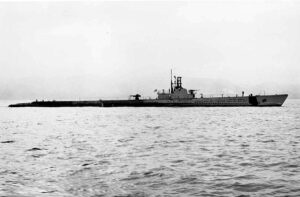 USS Cero was laid down on 24 August 1942, launched on 4 April 1943 and commissioned on 4 July 1943. She left New London 17 August for the Pacific, from 26 September left Pearl Harbor for the East China-Yellow Seas (1st patrol) in the first US wolfpack (WP) with USS Shad and Grayback. Cero was the flagship, Captain “Swede” Momsen being a senior commander. On 12 October, Cero attacked a convoy of three freighters +2 destroyers, samaged three and finished off a patroller surfaced.
USS Cero was laid down on 24 August 1942, launched on 4 April 1943 and commissioned on 4 July 1943. She left New London 17 August for the Pacific, from 26 September left Pearl Harbor for the East China-Yellow Seas (1st patrol) in the first US wolfpack (WP) with USS Shad and Grayback. Cero was the flagship, Captain “Swede” Momsen being a senior commander. On 12 October, Cero attacked a convoy of three freighters +2 destroyers, samaged three and finished off a patroller surfaced.
Refit Midway then 2nd patrol from 16 November to 13 December 1943 under Cdr Edward Dissette on Truk-New Ireland, and Milne Bay from 12 January to 4 February 1944, then Truk-New Ireland, damaged 2 freighters. Refit Brisbane then 3 April 1944, 4th war patrol (Palau Is.) but mistook by a B24 and atacked on 11 April off Biak. On 23 May 1944, she sank a cargo and damaged a tanker. After a refit at Seeadler Harbor in Manus until 26 June 1944 she sailed for Mindanao, sank a tanker on 5 August, 15 days later she was in Brisbane. On 19 September she departed for Mindanao-Sulu via Mios Woendi to piclup supplies and 16 soldiers for spec ops in Luzon. She sank surfaced two small craft on 27 October. On 3 November off Manila she landed soldiers and took four evacuees. Jim “Red Dog” saw a torpedo coming at them from an IJ sub, she escaped. Necxt in November she was overhauled at Pearl. Under Cdr. Raymond Berthrong she left on 31 March 1945 of her 7th patrol off Honshū and Hokkaidō, sank 2 picket boats, was in lifeguard services and then sank three freighters and a large trawler.
After a refit at Guam and Saipan until 27 June she was again in lifeguard and picket duty off Honshū in her 8th patrol and on 15 July, rescued 3 survivors of a downed bomber. She shelled a Japanese lighthouse and radio station at Shiriya Saki. On 18 July off the Kurile she was attacked by aviation, near missed, but badly damaged. She sailed for, arrived 30 July for repairs and the war ended. She sailed to New Orleans and Baton Rouge in November 1945 and was decommissioned at New London, reserve from 8 June 1946 to 4 February 1952, Key West, Fleet Sonar School, and inactivation, reserve at New London on 23 December 1953, reserve pierside TS at the Detroit Naval Armory 1960-1967, sold 1970. She earned 7 battle stars.
 USS Corvina (SS-226)
USS Corvina (SS-226)
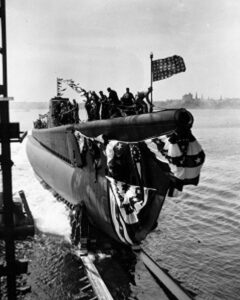 USS Corvina was laid down on 21 September 1942, launched on 9 May 1943, commissioned on 6 August 1943. She left New London on 18 September under Cdr Roderick S. Rooney for Pearl Harbor and made her first patrol from 4 November, at Johnston Island but was never heard from again. Her mission was to close on Truk and intercept Japanese sorties in direction of the Gilbert Islands. I-176 launched three torpedoes at an enemy submarine south of Truk on 16 November, likely to be Corvina. She was reported lost on 14 March, only USN sub-on-sub loss of the war.
USS Corvina was laid down on 21 September 1942, launched on 9 May 1943, commissioned on 6 August 1943. She left New London on 18 September under Cdr Roderick S. Rooney for Pearl Harbor and made her first patrol from 4 November, at Johnston Island but was never heard from again. Her mission was to close on Truk and intercept Japanese sorties in direction of the Gilbert Islands. I-176 launched three torpedoes at an enemy submarine south of Truk on 16 November, likely to be Corvina. She was reported lost on 14 March, only USN sub-on-sub loss of the war.
 USS Darter (SS-227)
USS Darter (SS-227)
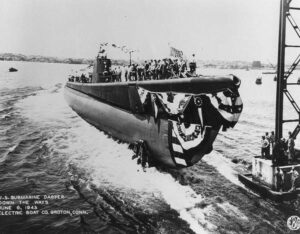 USS Darter was laid down on 20 Oct 1942, launched on 6 Jun 1943 and commissioned on 7 Sep 1943. She left New London on 31 October for Pearl Harbor and started her 1st patrol on 21 December 1943 for Truk. Later, Tulagi and Milne Bay (30 January–8 February 1944) and recce off Eniwetok on 12 January, hitting a “large ship”. She was on plane guard duty during the air strikes on Truk (16–17 February), resuplied at Milne Bay and Brisbane in March. Motor Machinist’s Mate Robert Richard Gould, Jr. was electrocuted in maintenance and died. Her 2nd patrol was north of Western New Guinea, south of Davao, claiming a kill, patrolling off New Guinea during landings, resupplied at Darwin and sailed to Manus Island.
USS Darter was laid down on 20 Oct 1942, launched on 6 Jun 1943 and commissioned on 7 Sep 1943. She left New London on 31 October for Pearl Harbor and started her 1st patrol on 21 December 1943 for Truk. Later, Tulagi and Milne Bay (30 January–8 February 1944) and recce off Eniwetok on 12 January, hitting a “large ship”. She was on plane guard duty during the air strikes on Truk (16–17 February), resuplied at Milne Bay and Brisbane in March. Motor Machinist’s Mate Robert Richard Gould, Jr. was electrocuted in maintenance and died. Her 2nd patrol was north of Western New Guinea, south of Davao, claiming a kill, patrolling off New Guinea during landings, resupplied at Darwin and sailed to Manus Island.
3rd patrol started on 21 June off Halmahera and Mindanao, sinking IJN minelayer Tsugaru off Morotai on 29 June 1944, and took a depth charge barrage.
Her 4h patrol started from Brisbane in August in the Celebes Sea and South China Sea, then back to Darwin and from 10 September, to the Celebes Sea and Mios Woendi to resupply and joined USS Dace in the South China Sea for the invasion of Leyte. She attacked a tanker convoy on 12 October. On 21 October she sailed in ambush at Balabac Strait. They soon made contact with the Japanese Center Force approaching the Palawan Passage, on 23 October. A superb prize. They attacked the cruisers in the Palawan Passage, first action of the Battle for Leyte Gulf. Darter sank IJN Atago and badly damaged Takao, they were tracking her after midnight of 24–25 October when Darter grounded on Bombay Shoal. IJN Naganami spotted them and closed, tried to tow her off the reef but failed and sailed off, to the amazement of the crew. The tide was not in their favour, helped by Dace crew they tried but failed to get free. All confidential papers and equipment were destroyed and the crew evacuated on Dace, with demolition charges planted. They failed, torpedoes launched exploded on the reef so she trie to scuttle her with 21 shells from her puny 3 in (76 mm) gun but failed. USS Rock was called, fired 10 torpedoes but only scratched the reef. USS Nautilus arrived on 31 October, scored fifty five 6-in (150 mm) hits and blasted her. The hull remained remarkably intact as late as 1962. Dace was back at Fremantle on 6 November. The crew was was trabnsferred to the new Balao class USS Menhaden (SS-377). 4 battle stars and a Navy Unit Commendation for 4 war patrols, 19,429 tons sunk.
 USS Drum (SS-228)
USS Drum (SS-228)

USS Drum was the first laid down at Portsmouth Naval Shipyard in Kittery, Maine, laid down on 11 Sep 1940, launched on 12 May 1941 and commissioned on 1 Nov 1941, so before the Pearl harbour attack. Technically she was the first Gato class in service. Drum arrived at Naval Station Pearl Harbor at Pearl Harbor, Hawaii, on 1 April 1942. She departed Pearl Harbor on 14 April 1942 for Midway and her 1st war patrol off the coast of Japan, sinking the Japanese seaplane tender Mizuho on 2 May but had to escape a 16-hour depth charge attack (31 drops). Later she sank three cargo ships (inc. Shonan Maru, Kitakata Maru) and was back to Pearl on 12 June for repairs and refit. Her 2nd patrol was between Truk and Kavieng (10 July–2 September) but reported the Mk.14 as “useless”. She damaged a freighter and ended in to Midway. She departed on 23 September for a 3rd patrol off Kyūshū. On 8 October, she spotted a convoy of four freighters, sank IJA Hague Maru but was attacked by air. On the 9th she was hunted down and depth chargd but managed to sink the 2461 ton cargo ship Hachimanzan Maru. On 20 October, she sank Ryunan Maru and ended in Pearl Harbor on 8 November. Her 4th patrol started on 29 November until 24 January 1943, planting mines in the Bungo Suido.
On 12 December, she spotted IJN Ryūhō loaded with reinforcement planes launched torpedoes, two hits, and saw her listing but she was chased off by a destroyer, lost depth control and port shaft. After emergency repairs, she was depth charged and surfaced hours later. The carrier escaped.
After an overhaul at Pearl Harbor, she started her 5th war patrol from 24 March until 13 May 1943 south of Truk and taking intel at Nauru. She sank Yuzan (Oyama) Maru on 9 April, on the 18th, Nisshun Maru, and ended at Brisbane. Her 6th patorl started on 7 June until 26 July, in the Bismarck Archipelago, and on 17 June sank the 5086 ton cargo-passenger ship Myoko Maru. Back to Brisbane she left on 16 August for her 7th war patrol, damaged Yamagiri Maru on 28 August and later the Hakutetsu Maru 13 on 8 September. She was off New Georgia during the landings then Tulagi and remained for refit between 29 September and 2 October, then Brisbane for R&R.
She started her 8th patrol on 2 November, with landings at Cape Torokina. She patrolled between the Carolines and New Ireland, sank Hie Maru (11,621 tons) on 17 November, and a convoy on 22 November, DCs, escaped, sailed to Pearl Harbor on 5 December, had her CT cut out and replaced on the West Coast.
Back at Pearl Harbor on 29 March 1944 she started her 9th war patrol to Iwo Jima and the Bonin Islands, plus a recon of Chichi Jima.
After a refit at Majuro from 31 May to 24 June she was in lifeguard service (raids on Yap and Palau) and sank a sampan on 29 July. Sehe was in the Surigao Strait on 9 September (11th patrol) and headed for the South China Sea and on 24 October sank the Shikisan Maru. On 26 October she reported a 13 ship convoy and sank the Taihaku Maru (6886 tons), Taisho Maru (6886 tons), and Tatsura Maru, (6420 tons), damaging Aoki Maru (3710 tons) with reinforcements. Refitted in Majuro she was in plane guard at the Luzon Strait.
On 7 December she sailed for Nansei Shoto on her 12th patrol and ended in Guam on 17 January 1945. Her 13th patrol was between 11 February and 2 April, off Iwo Jima and Okinawa in lifeguard service. She transited to the West Coast for overhaul via Pearl Harbor and was back at Midway, starting her 14th and last patrol on 9 August, and after V day sailed to Saipan, Pearl Harbor, Panama Canal, Portsmouth, decommissioned on 16 February 1946. From 18 March 1947 she trained the Naval Reserve (Potomac River Naval Command) until 1967 and inactive Fleet at Norfolk until 1969. She earned 12 battle stars, sinking 15 ships for 80,580 tons, 8th highest. Donated to the USS Alabama Battleship Commission on 14 April 1969 she was opened to the public on 4 July. National Historic Landmark in 1986. Visit her.
 USS Flying Fish (SS-229)
USS Flying Fish (SS-229)
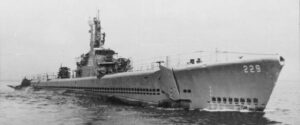 USS Flying Fish was laid down on 6 Dec 1940 at Portsmouth, launched on 9 Jul 1941, sponsored by Mrs. Dorothy K. Kimmel, wife of Admiral Husband E. Kimmel, CiC Pacific Fleet, and commissioned on 10 Dec 1941 with Lt. Cdr. Glynn “Donc” Donaho in command. After shakedown, Panama Canal, Balboa she sailed in April 1942 for Pearl Harbor, mistook underway by an aircraft and depth charged.
USS Flying Fish was laid down on 6 Dec 1940 at Portsmouth, launched on 9 Jul 1941, sponsored by Mrs. Dorothy K. Kimmel, wife of Admiral Husband E. Kimmel, CiC Pacific Fleet, and commissioned on 10 Dec 1941 with Lt. Cdr. Glynn “Donc” Donaho in command. After shakedown, Panama Canal, Balboa she sailed in April 1942 for Pearl Harbor, mistook underway by an aircraft and depth charged.
Her 1st patrol started on 17 May 1942, off Midway. During the Battle she scout and screen the atoll. Later she scoured the Japanese home waters, hittting a Japanese destroyer off Formosa (3 July 1942). Her 2nd patrol between August and September 1942 started north of Truk. On 28 August she spotted a Japanese battleship (Yamato) but too well guarded plus with air cover. She launched four, detected two hits by sonar and went deep for cover, with a barrage of depth charges. 2 hours later the two destroyers were still searching. She send torpedoes again and went deep (she missed). After surfacing excessive smoke forced her down. On 29 August she cleared the area. She was in Truk on 2 September, attacked and missed a 400t patrol vessel. After a counter-attack she evaded the area, returned later to sink a single patrol vessel after midnight. More patorllers and DDs joined in the seach for five hours. She managed to get back to Pearl Harbor on 15 September. She left Pearl Harbor on 27 October to south of the Marshall Islands. Three attacks marred by poor torpedo performance. She ended in Brisbane on 16 December.
On 6 January 1943 she started her 4th patrol to the Marianas. She obtained intel and damaged the Tokai Maru in Apra harbor on 26 January and the Nagizan Maru in Tinian’s Roadstead on 6 February as well as Hyuga Maru on 16 February, back to to Pearl Harbor on 28 February.
On 9 March 1943 she lost three crew member to poisining (wood alcohol) at the Royal Hawaiian Hotel in Waikiki in R&R. Her 5th patrol started on March 1943 to the coast of Honshū, and on 12 April, she sank Sapporo Maru No.12. Next north to Hokkaidō she damaged a large freighterand later torpedoed Seiryu Maru. On 19 April she sank Amaho Maru. In the Tsugaru Strait on 24 April she sank Kasuga Marum. On 1 May she sank a small inter-island freighter. She escaped an attack and sailed back to Midway on 11 May.
6th patrol started in June she had a new skipper, Frank T. Watkins. Dhe patorlled the Volcano Islands and Formosa (damaged a ship) and sank later the Canton Maru and on 11 July the sailing vessel Takatori Maru No.8 with gunfire. Her 7th patrol from October started after an overhaul at Pearl Harbor, headed for the Palaus. On 18 October she hit IJN Chūyō. Later she sank the troop transport Nanman Maru and on 27 October damaging two merchantmen and was back at Midway on 6 November. Her 8th patrol was under Lt.Cdr R.D. Risser between Formosa and the China coast until 28 January 1944, cliaming the Ginyo Maru and tanker Kyuei Maru from convoy Hi-27 on 27 December. She was refitted again at Pearl Harbor.
She started her 9th patrol on 22 February off Iwo Jima and on 12 March, sank Taijin Maru. Next at Okinawa she attacked a convoy on 16 March. She damaged Anzan Maru and the tanker Teikon Maru. On 31 March she was attacked by a Japanese submarine, evaded torpedoes. She headed for Majuro and underway sank Minami Maru at Kitadaitōjima. She was refitted at Majuro 11 April, departed on 4 May for a 10th patrol between Ulithi, Yap, and Palau, missed a four-ship convoy and was depht-charged. She sank the Taito Maru and Osaka Maru.
Next she was between the Palaus and San Bernardino Strait to scout for the enemy fleet from Tawi, just as the Marines landed on Saipan. On 15 June she spotted and reported a carrier force from San Bernardino Strait. Nearby Cavalla was vectored in to sink Shōkaku. Flying Fish left on 23 Jun for Manus and Brisbane. Her netx patrol started on October to Davao Gulf, Celebes, and Halmahera wuth USS Flounder (SS-251). On 8 August she was in the Admiralty Islands to supply at the tender USS Euryale (AS-22) but was later mistook by USS Cogswell (DD-651) and depth-charged. Later she failed to answer her sonar recognition signals, was depht-charged until she did. She sailed to Manado, Celebes on 14 August, refuelled at Mios Woendi and on 7 September detected and vectored bombers on an airfield 11 days later. She remained in lifeguard duty and ended in Midway on 18 October.
Her next patrol would last until May 1945. In between, she had an overhaul at San Francisco and received a naval mine detection and clearance equipment and proceeded to the sea of Japan after a halt at Guam on 18 May 1945. She joined a task group for her 12th patrol from 29 May and entered the heavily mined Tsushima Strait on 7 June. Next she was sent to the north for the coast of Korea and on 10–11 June sank Taga Maru and Meisei Maru. 5 days later she sank ten small craft with gunfire. She was back at Pearl Harbor on 4 July 1945, her crew being in R&R on 15 August. Back in New London on 21 September she became flagship, COMSUBLANT and for eight trained the Naval Reserve in Long Island Sound and Block Island Sound. She was reclassified as AGSS-229 on 29 November 1950 and later worked for the Underwater Sound Laboratory, testing the GHG sonar frop the war prize Prinz Eugen. On 29 February 1952 she broke the record of 5,000 dives, hosting a party headed by the Secretary of the Navy Dan A. Kimball. She was in reserve on 31 December 1953, decommissioned at New London on 28 May 1954, sold for scrap on 1 May 1959.
She was classed 11th with 58,306 tons, 12 battle stars.
 USS Finback (SS-230)
USS Finback (SS-230)
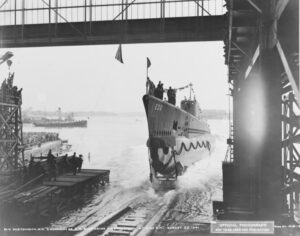 USS Finback was laid down on 5 Feb 1941, launched on 25 Aug 1941, commissioned on 31 Jan 1942. USS Finback was in Pearl Harbor on 29 May and on patrol during the Battle of Midway, back at Pearl Harbor on 9 June for a full 1st war patrol to the Aleutian Islands on 25 June. On 5 July she attacked but missed two destroyers, stayed down, and was almost out of oxygen. She reconed Vega Bay in Kiska on 11 July, and Tanaga Bay on 11 August and via Dutch Harbor she was back at Pearl Harbor on the 23th. Her second war patrol was off Formosa/Taiwan and on 14 October, she sighted a convoy, launched two torpedoes sinking the ex-French merchantman Ville De Verdun, now Teison Maru. Next she headed for the China coast and on 18 October damaged a large freighter. On 20 October she sank the Africa Maru and Teibo Maru, then Yamafuji Maru, endine out of torpedoes wuth a gunfire engagement on 3 November and back to Pearl Harbor.
USS Finback was laid down on 5 Feb 1941, launched on 25 Aug 1941, commissioned on 31 Jan 1942. USS Finback was in Pearl Harbor on 29 May and on patrol during the Battle of Midway, back at Pearl Harbor on 9 June for a full 1st war patrol to the Aleutian Islands on 25 June. On 5 July she attacked but missed two destroyers, stayed down, and was almost out of oxygen. She reconed Vega Bay in Kiska on 11 July, and Tanaga Bay on 11 August and via Dutch Harbor she was back at Pearl Harbor on the 23th. Her second war patrol was off Formosa/Taiwan and on 14 October, she sighted a convoy, launched two torpedoes sinking the ex-French merchantman Ville De Verdun, now Teison Maru. Next she headed for the China coast and on 18 October damaged a large freighter. On 20 October she sank the Africa Maru and Teibo Maru, then Yamafuji Maru, endine out of torpedoes wuth a gunfire engagement on 3 November and back to Pearl Harbor.
Her 3rd war patrol started on 16 December 1942, as escort for a carrier task force but she sank while surfaced the coaster Yachiyo Maru on 17 January.
She started her 4th patrol from Midway from 27 February between Rabaul and the Japanese home islands. On 21 March she damaged Sanuki Maru.
On 5 April she spotted and finished off the Suwa Maru, already torpedoed and beached.
USS Finback started her 5th patrol from Pearl Harbor on 13 April, sailed off Taiwan and to the Marshalls. On 27 May she sank the Kochi Maru and on 8 June, the Kahoku Maru, then another merchant vessel (unknown).
She was refitted at Fremantle on 26 June and started her 6th patrol along the Java coast. On 30 July she sank Ryuzan Maru and another vessel on 3 August. On 11 August she damaged Tatsumiya Maru, spotted two small minelayers, tug and steamer on 19 August by gunfire, damaging a submarine chaser and sinking Cha 109.
After a major overhaul at Pearl Harbor (12 September-15 December 1943) she sailed for the South China Sea for her 7th patrol and sank the tanker Isshin Maru in a surface attack but had to fold back to port after a rudder malfunction.
After refit at Pearl Harbor she departed on 11 February for her 8th patrol off Truk (Carolines). She was on lifeguard for air strikes in the Carolines and tried to attack a six-ship convoy on 12 April. On the 16th off Oroluk Atoll, she fired on a steamer, then sampans, and was refitted at Pearl Harbor.
Her 9th war patrol was off the Palaus and Marianas in lifeguard duty. She was back to Majuro on 21 July and on 16 August started her 10th patrol under Lt Cdr Robert Russell Williams, Jr., in lifeguard duty, Bonins, rescuing among others George H. W. Bush. On 10–11 September she tracked a convoy and sank Hassho Maru, Hakuun Maru No.2. After refit she started her 11th war patrol in lifeguard duty, Bonins, sinking Jusan Maru on 16 December and back to Midway on 24 December.
Her 12th war patrol between 20 January and 25 March 1945 was in the East China Sea. She was back on Pearl Harbor and then sailed for New London on 29 August 1945 for 5 years training student submariners. She was decommissioned on 21 April 1950, was stricken on 1 September 1958, sold 15 July 1959. 13 battle stars, 69,383 tons sank.
 USS Haddock (SS-231)
USS Haddock (SS-231)
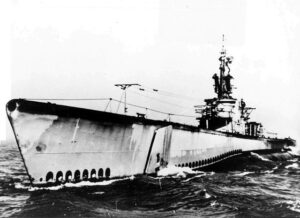 USS Haddock was laid down on 31 Mar 1941, launched on 20 Oct 1941 and commissioned on 14 Mar 1942 under Lt. Cdr Arthur H. Taylor in command. Her 1st war patrol started on 28 July from Pearl Harbor, fitted with a SJ radar. In the Bonin Islands and up the East China Sea she attacked a freighter on 22 August, sank Tatsuho Maru. Later in the Formosa Straits on 26 August she sank Teishun Maru. Next she patrolled off Okinawa and was back to Midway on 19 September. Her 2nd war patrol started on 11 October from Midway in the Yellow Sea. Two failed attacks but she sank Tekkai Maru on 3 November, attcked and missed on 6 November and damaged French Maru. On 11–12 November she damaged Venice Maru east of Honshū. Dhe damaged Nichinan Maru on 16 November, finished off by gunfire. She was back on Pearl Harbor on 4 December. On 28 December she satrted her 3rd war patrol south of Japan. She escaped an heavy attack.
USS Haddock was laid down on 31 Mar 1941, launched on 20 Oct 1941 and commissioned on 14 Mar 1942 under Lt. Cdr Arthur H. Taylor in command. Her 1st war patrol started on 28 July from Pearl Harbor, fitted with a SJ radar. In the Bonin Islands and up the East China Sea she attacked a freighter on 22 August, sank Tatsuho Maru. Later in the Formosa Straits on 26 August she sank Teishun Maru. Next she patrolled off Okinawa and was back to Midway on 19 September. Her 2nd war patrol started on 11 October from Midway in the Yellow Sea. Two failed attacks but she sank Tekkai Maru on 3 November, attcked and missed on 6 November and damaged French Maru. On 11–12 November she damaged Venice Maru east of Honshū. Dhe damaged Nichinan Maru on 16 November, finished off by gunfire. She was back on Pearl Harbor on 4 December. On 28 December she satrted her 3rd war patrol south of Japan. She escaped an heavy attack.
On 17 January 1943, she sank an unidentified/uncredited freighter. On 19 January she spotted six cargo, scored two hits and sank the last. She was back in Midway on 17 February. On 11 March she was underway for her 4th patrol and on 3 April patrolling off Palau, sank the fleet oiler Arima Maru and the escorting corvette (Yūzuki), a dud. The tanker needed three more torpedoes. She was depht charged and forced to dive at 415 ft, having her CT and radar system damaged. She was back to Pearl Harbor on 19 April 1943.
She sailed out from 30 June for the Caroline Islands on her 5th war patrol, spotted 4 escorted transports north of Palau on 21 July and sank Saipan Maru. She failed another attack and was back to Midway on 6 August, then Pearl Harbor. Her 6th patrol off Truk, Carolines started on 2 September, and she damaged Samsei Maru on 15 September and later the auxiliary tanker Notoro on 20 September and sailed back to Truk. She sank the collier Shinyubari Maru, escaped attacks and she was back to Midway on 28 September.
Her 7th war patrol started on 20 October 1943 off Truk and on 1 November she attacked two ships without success, and escaped later a hunter-killer group. On 6 November she damaged the Hoyo Maru and was back to Pearl Harbor on 15 November. Her 8th patrol started with USS Tullibee and Halibut from Pearl Harbor on 14 December, spooting a force on 19 January, damaging IJN Un’yō and was back to Pearl Harbor on 5 February 1944.
Her 9th patrol started on 10 March. She sank the auxiliary minesweeper Noshiro Maru No.2 on 17 April and was back at Pearl Harbor on 10 May.
Her 10th patrol under Commander Roach was uneventful despite joining USS Halibut and Tuna. On 8 October she supported the invasion of the Philippines and at the battle off Cape Engaño on 25 October she pursued retiring Japanese units but had a malfunctioning periscope. She was back on 10 December.
Gor her 11th patrol she sailed with USS Sennet and Lagarto east of Japan in a diversionary sweep for the strikes against Tokyo. She attacked picket boats with gunfire and was back in Guam on 14 March 1945. Her 12th and 13th patrols were spent in lifeguard station near Tokyo. She was back at Pearl Harbor on 22 August.
USS Haddock returned to the East Coast on 7 September. Based in New London from March 1946. She was in reserve and commission on 20 April, decommissioned on 12 February 1947. In August 1948 she was reserve training ship, 6th Naval District, until May 1952. Then TS at Portsmouth by June 1956 until stricken on 23 August 1960. 11 battle stars, Presidential Unit Citation for 4 patrols.
 USS Halibut (SS-232)
USS Halibut (SS-232)
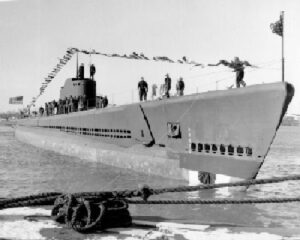 USS Halibut was laid down on 16 May 1941, launched on 3 Dec 1941 and commissioned on 10 Apr 1942 under Cdr. Philip H. Ross. She ended her shakedown cruise on 23 June for Pearl Harbor and departed on 9 August for the Aleutian Islands, Kiska and started a gunnery duel with a freighter on 23 August. She terminated her patrol at Dutch Harbor on 23 September.
USS Halibut was laid down on 16 May 1941, launched on 3 Dec 1941 and commissioned on 10 Apr 1942 under Cdr. Philip H. Ross. She ended her shakedown cruise on 23 June for Pearl Harbor and departed on 9 August for the Aleutian Islands, Kiska and started a gunnery duel with a freighter on 23 August. She terminated her patrol at Dutch Harbor on 23 September.
Her 2nd patrol in the Aleutians started on 2 October 1942 and attacked a large freighter on 11 October, but she was one of the rare Japanese Q-ship ewith concealed guns and torpedo tubes. Pummelled, Halibut made a crash dive. She was back at Dutch Harbor on 23 October, Pearl Harbor on 31 October.
She sailed out on 22 November for the northeast coast of Japan, stalking a convoy on 9 December and damaged Uyo Maru, then Gyokusan Maru then on 16 December she claimed Shingo Maru and wrecked Genzan Maru, back at Pearl Harbor on 15 January 1943.
She sailed from 8 February to Japan-Kwajalein, tracked and sank on 20 February the Shinkoku Maru. Northeast of Truk on 3 March she attacked, surfaced, Nichiyu Maru but was driven off (later she was declared a total constructive loss). She was back at Pearl Harbor on 30 March.
Her 5th war patrol started on 10 June for Truk, failed her attack on 23 June. Then the trailed a convoy for Truk from Kisarazu damaging the troop transport Aikoku Maru. She also attacked IJN Un’yō on 10 July and was back to Midway Island on 28 July.
Under Ignatius J. “Pete” Galantin from 11 August she started her 6th patrol on 20 August with Searaven and Pompano off Honshū and Hokkaido and on 29 August, spotted a freighter, failed, ran deep for eight hours. Next she was in Iburi Wan, sank Taibun Maru.
In the Tsugaru Strait she missed a freighter found by radar. Between Erimo Saki and Muroran on 6 September she sank Shogen Maru. Later by radar she spotted the light cruiser Nachi and damaged her. She was back at Midway on 7 September after sinking a small sampan. She had a refit at Pearl Harbor from 16 September.
he took part in tests with the modified Mark 14. She collided with a destroyer and was repaired.
She left Pearl Harbor for a 7th patrol on 10 October to the Bungo Suido and reached Midway for repairs. She lost her SJ radar, reached Okinoshima on 25 October and on the 29th detected, tracked, and attacked a freighter. On 1 November she spotted a convoy of seven freighters, atacked, no hits.
On 2 November she attacked two straggling freighters, sank Ehime Maru. In Van Diemen Strait she learned about a large force near the Bungo Suido. On 5 Novembe she attacked Shōkaku (properly later identified as Jun’yō) and hit her rudders. Back via to Midway to Pearl Harbor she ended her 7th patrol.
On her 8th patrol from Pearl Harbor on 14 December she joined a wolf pack with Haddock and Tullibee.
She was in the Mariana Islands, was attacked on 26 December. She spotted Yamato on 11 January and attacked but missed an Asashio-class destroyer. She was back at Midway to refuel. She patrolled Port Apra and Tanapag Harbor, spotted a Katori class on 23 January and spotted IJN Unyō in Garapan Anchorage but was driven off. She was back on 1 February 1944.
Her 9th patrol started on 21 March off Okinawa and between Amami O Shima and Tokuno Shima on 12 April. She sank Taichu Maru adn ended her patrol on the East China Sea. On 26 April she was between Iheya Retto and Okinawa Jima when spotting thre freighters, fired six torpedoes, two hit and later she sank Genbu Maru with two torpedoes. Next she sank the coastal minelayer Kanome. She was off Kume Shima on 29 April and bombarded two warehouses and other buildings.
On 1 May she spotted 18 sampans east of Okinawa, surfaced and engaged them from 1,000 yards (910 m). She sank two sampans. Underway to Midway she met USS Perch on 11 May to transfer an injured man. At Pearl Harbor on 15 May 1944, she departed for a major overhaul at Bethlehem Steel in San Francisco. For her 10th war patrol she teamed with USS Haddock and Tuna under John P. Roach loaded with Mark 18 torpedoes. They departed from Pearl on 8 October to Saipan, and patorlled an area between Formosa and Luzon. She was in Luzon Strait on 25 October trying to ambush vessels out of the Battle off Cape Engaño. She spotted parts of Ozawa’s force (Yamashiro but later identified as Ise). At 18:43 she fired six torpedoes, one hitting a defending destroyer (Akizuki or Hatsuzuki).
She sailed to Luzon Strait, Bashi Channel, Balintang Channel and on 28 October was attacked by an anti-submarine aircraft. She spotted and did not attacked the hospital ship Hikawa Maru. On 14 November she entered the Bashi Channel, launched but missed. She was chased off by jikitanchiki-equipped Mitsubishi G3M aircraft (equipped with Magnetic anomaly detector and depht charges) and went down to 325 feet after detecting sonars from two escorts. CD-6 blasted her CT and she was rocked by others. She had her equipment, battery compartment, torpedo room, forward battery room, main air bank batterred and she went to 420 feet so mych so entire sections were sealed off. She waited and went up to 300 feet (91 m) under repairs, completed by night when resurfacing. She lost her depth gauges, main compasses, gyros, radio but had her radar repaired but the hull leaked severely. At 21:30 she met USS Pintado, transferred a message to COMSUBPAC and she was escorted over 1,500 miles (2,400 km) to Saipan, arriving on 19 November in Tanapag Harbor for more repairs. The crew received a Navy Unit Commendation. She sailed to Pearl Harbor on 1 December but there she was decalred a constructive total loss. Transferred to New London she became a pierside school ship under Guy Gugliotta. In February 1945 she was in Portsmouth, to be decommissioned on 18 July, sold for scrap on 10 January 1947. Seven battle stars, 12 ships sunk, 9 damaged. Her battle flag is now at the USS Bowfin Submarine Museum and park (close to USS Arizona Memorial) in Pearl harbor.
 USS Herring (SS-233)
USS Herring (SS-233)
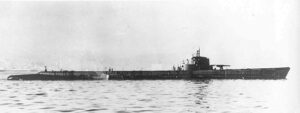 USS Herring was laid down on 14 July 1941, launched on 5 January 1942 and commissioned on 4 May 1942. One of the rare boats seeing action in the Atlantic-Med theaters. She was sent in the Mediterranean, North African coast to protect the flanks of the Operation Torch invasion fleet, prevent possible sorties from the Vichy French fleet and axis attacks, off Casablanca on 5 November. On 8 November she spotted and sank the cargo Ville du Havre. She resuplied at Rosneath (Scotland) on 25 November, departed on 16 December for two more patrols, not targets. Her 4th patrol was an antisubmarine sweep off Iceland. Her 5th was back to the US coast, in the summer 1943.
USS Herring was laid down on 14 July 1941, launched on 5 January 1942 and commissioned on 4 May 1942. One of the rare boats seeing action in the Atlantic-Med theaters. She was sent in the Mediterranean, North African coast to protect the flanks of the Operation Torch invasion fleet, prevent possible sorties from the Vichy French fleet and axis attacks, off Casablanca on 5 November. On 8 November she spotted and sank the cargo Ville du Havre. She resuplied at Rosneath (Scotland) on 25 November, departed on 16 December for two more patrols, not targets. Her 4th patrol was an antisubmarine sweep off Iceland. Her 5th was back to the US coast, in the summer 1943.
She received a refit and was sent for the Pacific from New London, on 9 August 1943. She trained at Pearl Harbor, sailed on 15 November for her 6th patrol, scored the Hakozaki Maru on 14 December, Nagoya Maru on New Year’s Day 1944. On 24 March 1944 she stalked a large aircraft carrier but had to flee under attack. After Lt Cdr Johnson (except for an inteim with John Corbus) she was under Lt.Cdr David Zabriskie, Jr for her last patrols of the war. Her 8th patrol started from Midway on 21 May 1944 to the Kurile Islands, meeting with USS Barb, but she was never heard for again. It seemed she was sunk by Ishigaki while trying to attack Hokuyo Maru on 30–31 May. Of she trield to surface attack by gunfire the Hiburi Maru and Iwaki Maru at anchor when blasted by coastal batteries on 1 June 1944. She won 5 battle stars between the two theaters.
 USS Kingfish (SS-234)
USS Kingfish (SS-234)
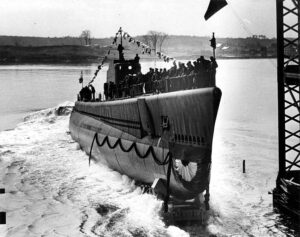 USS KingFish was laid down on 29 Aug 1941, launched on 2 Mar 1942, commissioned on 20 May 1942 under command of Vernon L. “Rebel” Lowrance. Her first patrol was between September and November 1942 from Pearl Harbor hit a freighter, 18 hours DC attack. Yomei Maru sank 1 October. Unverified kill off Muroto Zaki. 23 October sank Seiko Maru. Ended at Midway 3 November. 2nd patrol 25 November to Chichi-jima, South China Sea 5 December, sank Hino Maru No. 3, Choyo Maru 28 December. Two trawlers were attacked by gunfire in January. Back to Pearl Harbor on 23 January. 3rd patrol 16 February to Formosa, sank a trawler off the Bonins, damaged a freighter. 17 March, damaged another freighter then sank a troop transport. On 23 March under DC attack, heavy damage, preparation for abandoning ship. However the main induction piping burted, huge bubble escaped to the surface confirmed she was sunk, the attacker left. She was back at Pearl Harbor on 9 April then Mare Island to have entire sections rebuilt. From Pearl Harbor in June 1943 she started her 4th war patrol to the Babuyan Channel, north of the Philippines, southern Formosa, Manila. No kills, ended in Fremantle. 5th patrol in the South China Sea from 24 September with planting mines in shipping lanes and landing a party NW off Borneo. She sank a gunboat by gunfire, damaged a tanker on 9 October, Sibutu Islands. She sank Sana Maru off Cape Varella, 20 October and was back at Fremantle on 14 November. Left of 16 December under Lt Cdr H. L. Jukes to the South China Sea, 3 January sank the tankers Ryuei Maru and Bokuei Maru and the tanker Fushimi Maru No. 3 on 7 January. Back to Pearl Harbor 26 January 1944.
USS KingFish was laid down on 29 Aug 1941, launched on 2 Mar 1942, commissioned on 20 May 1942 under command of Vernon L. “Rebel” Lowrance. Her first patrol was between September and November 1942 from Pearl Harbor hit a freighter, 18 hours DC attack. Yomei Maru sank 1 October. Unverified kill off Muroto Zaki. 23 October sank Seiko Maru. Ended at Midway 3 November. 2nd patrol 25 November to Chichi-jima, South China Sea 5 December, sank Hino Maru No. 3, Choyo Maru 28 December. Two trawlers were attacked by gunfire in January. Back to Pearl Harbor on 23 January. 3rd patrol 16 February to Formosa, sank a trawler off the Bonins, damaged a freighter. 17 March, damaged another freighter then sank a troop transport. On 23 March under DC attack, heavy damage, preparation for abandoning ship. However the main induction piping burted, huge bubble escaped to the surface confirmed she was sunk, the attacker left. She was back at Pearl Harbor on 9 April then Mare Island to have entire sections rebuilt. From Pearl Harbor in June 1943 she started her 4th war patrol to the Babuyan Channel, north of the Philippines, southern Formosa, Manila. No kills, ended in Fremantle. 5th patrol in the South China Sea from 24 September with planting mines in shipping lanes and landing a party NW off Borneo. She sank a gunboat by gunfire, damaged a tanker on 9 October, Sibutu Islands. She sank Sana Maru off Cape Varella, 20 October and was back at Fremantle on 14 November. Left of 16 December under Lt Cdr H. L. Jukes to the South China Sea, 3 January sank the tankers Ryuei Maru and Bokuei Maru and the tanker Fushimi Maru No. 3 on 7 January. Back to Pearl Harbor 26 January 1944.
7th patrol was in the Marianas 19 February–9 April. No attacks. Ended in Majuro 9 April. 8th war patrol in the Bonins. No kill, sent to Midway, and to to Mare Island, for overhaul. Under T. E. Harper she started her new patrol from Pearl Harbor on 12 October. 24th: sank Ikutagawa Maru off Chichi Jima Retto. 27th: Sank Tokai Maru No. 4 and a landing craft off Kita. Okinawa, reported a convoy. Ended in Guam on 28 November.
23 December 1944 11th patrol to the home islands, spotted convoy 2 January 1945 in heavy weather. Sank Yaei Maru and Shibozono Maru later followed by lifeguard duties and back to Guam on 1 February. She sailed on 6 March with USS Icefish and Sawfish. No luck. Ended in Pearl Harbor 25 April.
12th patrol from 17 Juneunder Lt Cdr T. D. Keegan, via Guam to Honshū. Claimed two sampan picket boats 5 August. Arrived at Midway 2 hours before the war ended. Postwar New London 5 November, decommissioned, reserve 9 March 1946, struck 1 March 1960, sold 6 October 1960. 9 battle stars, 14 ships (48,866 tons).
 USS Shad (SS-235)
USS Shad (SS-235)
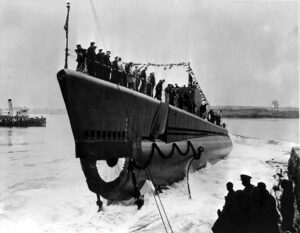 USS Shad was laid down on 24 October 1941, launched on 15 Apr 1942 and commissioned on 12 June 1942 under Lt Cdr Edgar J. MacGregor III. She was in “special patrol” SubRon 50 off Mehdiya, French Morocco for Operation Torch. She was in resupply at Roseneath. 2nd patrol in the Bay of Biscay under British command. Sank a trawler, a barge, and damaged a destroyer escort. Refitted in Scotland on 12 February 1943. 3rd patrol on 7 March, Bay of Biscay. Damaged the Italian blockade runner Pietro Orseolo, back 12 April.
USS Shad was laid down on 24 October 1941, launched on 15 Apr 1942 and commissioned on 12 June 1942 under Lt Cdr Edgar J. MacGregor III. She was in “special patrol” SubRon 50 off Mehdiya, French Morocco for Operation Torch. She was in resupply at Roseneath. 2nd patrol in the Bay of Biscay under British command. Sank a trawler, a barge, and damaged a destroyer escort. Refitted in Scotland on 12 February 1943. 3rd patrol on 7 March, Bay of Biscay. Damaged the Italian blockade runner Pietro Orseolo, back 12 April.
4th patrol in Norwegian waters. 5th patrol underway back home.
Refit in New London, Pacific at Pearl Harbor (7 September), departed the 28th, for her 6th patrol in the first US wolfpack (Shad, Cero, Grayback) under Captain Charles Momsen. On 22 October she attacked a convoy of two cruisers and three escorts, no confirmed kill but oil slick. 27 October, sighted another convoy, damaged three transports and a freighter. Via Midway she went back to Pearl Harbor, overhaul at San Francisco.
12 August, 7th war patrol in the home islands. Honshū, 30 August, allegedly damaged a freighter. 16 September, damaged a large transport. 19 September sank the escort ship Ioshima. 22 September, dodged torpdoes from an enemy submarine. Ended in Midway on 1 October.
8th patrol coordinating a WP with Redfish and Thresher, NE coast of Formosa, East China Sea, uneventful. Ended at Pearl Harbor on 5 January 1945.
9th patrol started on 31 January via Saipan on 12 February with Peto and Thresher, Luzon Strait. Three thwarted attacks. She was torpedoed but dodged an enemy sub on 5 March. Ended at Apra Harbor, Guam, 30 March.
10th war patrol August–October 1944 with Balao, Dragonet, Spikefish, Yellow and East China Seas. 17 May she sank Chosan Maru. On 7 June, she gunned down a small junk and later sank Azusa Maru and was bac to Midway. By 11 July she left Midway for her 11th patrol in lifeguird duties off Marcus Island. Back to Mare Island on 22 August for refit, then New Orleans 20 September. Decommissioned “in service, in reserve”, Naval Reserve Training Center, Salem Maritime National Historic Site, 1st Naval District until stricken 1 April 1960, sold. 6 battle stars.
 USS Silversides (SS-236)
USS Silversides (SS-236)
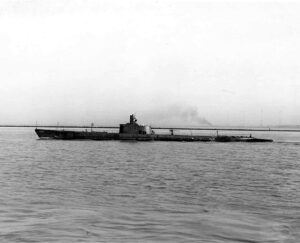 USS Silversides was the first of the gato class laid down at Mare Island Naval Shipyard in Vallejo, California, on 4 Nov 1940, launched on 26 Aug 1941 and completed on 15 Dec 1941 under command of Creed C. Burlingame. After a shakedown off California she sailed for Hawaii, Pearl Harbor on 4 April and left for her 1st patrol on 30 April to the home islands, Kii Suido. On 10 May she sank surfaced the guard boat Ebisu Maru No.5. after a 75-minute action. Torpedoman’s Mate 3rd Class Mike Harbin of Oklahoma was KiA. On 13 May she spotted and fired at an enemy submarine, no confirmed kill. On 17 May her periscope became entangled in a fishnet, fired three at a 4,000-ton cargo ship, sank. Second cargo hit, but not confirmed. Later she damaged a freighter and tanker and ended in Pearl Harbor on 21 June.
USS Silversides was the first of the gato class laid down at Mare Island Naval Shipyard in Vallejo, California, on 4 Nov 1940, launched on 26 Aug 1941 and completed on 15 Dec 1941 under command of Creed C. Burlingame. After a shakedown off California she sailed for Hawaii, Pearl Harbor on 4 April and left for her 1st patrol on 30 April to the home islands, Kii Suido. On 10 May she sank surfaced the guard boat Ebisu Maru No.5. after a 75-minute action. Torpedoman’s Mate 3rd Class Mike Harbin of Oklahoma was KiA. On 13 May she spotted and fired at an enemy submarine, no confirmed kill. On 17 May her periscope became entangled in a fishnet, fired three at a 4,000-ton cargo ship, sank. Second cargo hit, but not confirmed. Later she damaged a freighter and tanker and ended in Pearl Harbor on 21 June.
Her 2nd patrol was too in Kii Suido from 15 July. On the 28th she sank a 4,000-ton transporta and on the 8 August, Nikkei Maru. 14th, damaged a tanker. 31 August, sank two trawlers. Back to Pearl Harbor. 3rd patrol in the Carolines, damaged a large cargo and light minelayer. Ebded in Brisbane 25 November.
4rth patrol from December 1942 to New Ireland. 22 December she performed the first on board emergency appendectomy. She surfaced only t be attacked by an IJN destroyer, still here after she surfaced again, plus an airplane, severely damaging her bow planes, locked on full dive. She levelled off short of crush depth and later surfaced again. Off Truk on 18 January 1943 she sank the 10,022 ton oil tanker Toei Maru. On the 20th she damaged the Surabaya Maru, Somedono Maru, and Meiu Maru but had a torpedo stuck in tube, later refired while reversed at top speed. But she had a serious oil leak and returned to Pearl Harbor on 31 January.
5th patrol from 17 May in the Solomons, underway on 28 May, she reported a “firgate bird attack” on her periscope. She laid a minefield in Steffan Strait between New Hanover and New Ireland. On 10–11 June, she sank Hide Maru and was back to Brisbane for refit on 16 July.
6th patrol wa sunder LtCDr John S. “Jack” Coye, Jr. from 21 July between the Solomons and Carolines. No kills. 5 October, 7th patrol, between the Solomons and New Guinea. 18 October: Tairin Maru. 24 October: Tennan Maru and Kazan Maru, Johore Maru. Back to Pearl Harbor on 8 November.
8th patrol off the Palau Islands. 29 December 1943 she sank Tenposan Maru, Shichisei Maru, and Ryuto Maru. Back to Pearl on 15 January 1944.
9th patrol to the Marianas. 16 March: Sank Kofuku Maru. Ended in Fremantle 8 April.
10th patrol in the Marianas, sank 6. 10 May: Okinawa Maru, Mikage Maru, Choan Maru. 20 May: Shosei Maru. 29 May: Shoken Maru and Horaizan Maru. Back to Pearl on 11 June, then Mare Island for overhaul, and to Pearl again on 12 September.
24 September, 11th patrol off Kyūshū. No kills but she assisted USS Salmon (SS-182), badly damaged after a severe depth charging and a gun battle where she joined in. USS Trigger and Sterlet joined in helping Silversides and managed to escort her back to Saipan on 3 November. Silversides ended in Midway on 23 November.
12th patrol from 22 December, East China Sea. 25 January 1945 she sank the Malay Maru. Back to Midway on 12 February. 13th war patrol in WP with USS Hackleback and Threadfin off Kyūshū. Damaged a freighter, sank a trawler. Back on 29 April. 14th (final) patrol from 30 May on lifeguard station off Honshu. 22 July, rescued a one pilot from USS Independence (CVL-22), and later an USAAF one. Back to Apra, Guam, 30 July and in refit on 15 August.
She was greeted in New York City on 21 September, and was decomm. at New London 17 April 1946, reserve until 15 October 1947, then TS for Naval Reservists at Chicago. November 1962, reclassified AGSS-236. 30 June 1969 stricken. Pusrchased as memorial by the Chicago Chamber of Commerce. Long story dhort she was turned into a museum. Visit her at new Great Lakes Naval Memorial & Museum.
 USS Trigger (SS-237)
USS Trigger (SS-237)
 USS Trigger was laid down on 1 Feb 1941, launched on 22 Oct 1941, commissioned on 31 Jan 1942. She sailed to Pearl Harbor and Midway Island with TG 7.2 on 29 May and was to the NE during the Battle but ran aground, freed later and was back to Pearl on 9 June. Her 1st patrol started on 26 June for the Aleutian Islands, Cape Wrangell, Attu, spotting a convoy of six destroyers, three freighters. She was recalled to Dutch Harbor and Hawaii.
USS Trigger was laid down on 1 Feb 1941, launched on 22 Oct 1941, commissioned on 31 Jan 1942. She sailed to Pearl Harbor and Midway Island with TG 7.2 on 29 May and was to the NE during the Battle but ran aground, freed later and was back to Pearl on 9 June. Her 1st patrol started on 26 June for the Aleutian Islands, Cape Wrangell, Attu, spotting a convoy of six destroyers, three freighters. She was recalled to Dutch Harbor and Hawaii.
Under Roy S. Benson she started her 2nd patrol on 23 September in Japanese waters, on 5 October spotted and surfaced to attack a 4,000 ton ship which tried to ram her. She submerged, launched two, heard one hit. No kill. On 17 October, she sank Holland Maru off the Bungo Suido.Later when attacked by a DD she managed three hit “down the throat” but the latter was intact (premature detonatons). 20 October she allegedly sank a 10,000-ton tanker. 4 days later, same, 3 hits, just damagd. Her 3rd patrol started on 3 December 1942 in a combined minelaying and combat patrol in the home islands. Start minelaying on 20 December off Inubo Saki in Honshū. Claimed a freighter and damaged an escort.
On 22 December she attacked a freighter from Uraga, sank Teifuku Maru. On 31 December she sank a cargo loaded with planes, but not confirmed by JANAC.
On 10 January 1943 she spotted and attacked an incoming Japanese destroyer from 1,600 yards (1,500 m), claiming the Minekaze-class destroyer IJN Okikaze, with a persicope photo to prove it.
Fourth patrol was between February and April 1943. She left Midway on 13 February for the Palau Islands, missed a freighter, and another also missed in a rain squall. On 15 March she sighted a convoy, approached between the two columns and launched three at each leading ships, hit the lead freighter on teh left but missed on the right as she changed course. Three more fired, two hits but she dove due to the escorts. She was attributed later the Momoha Maru. She fire 6 at a smaller freighter, 5 missed, one made a circular run and narrowly missed her back. On 20 March she lost three at the lead ship in a convoy of 4 cargo, one hit, but only damaged. She was back at Pearl Harbor on 6 April with a furious skipper.
Her 5th patrol started on 30 April from Ultra intel from Pearl Harbor in interception of Admiral Koga’s task force from Truk. Spotted on 22 May but out of range. On 28 May she attacked two freighters off Iro Saki, one hit, seen sinking, not confirmed. Three later on a small cargo ship, 2 missed, one exploded prematurely, 4th hit, but dud. On 1 June she was off Sagami Nada, sighting two columns of smoke, fired three at each target. She sank Noborikawa Maru, missed the rest. From Ultra on 10 June she was vectored to an aircraft carrier, closed and fired six from 1,200 yards (1,100 m) with 4 explosions, and baldy damaged IJN Hiyō (out of action for a year). Given the accounts at her return, Admiral Lockwood from COMSUBPAC was furious and pushed to solve issues with the Mark 14.
At Trigger’s return at Pearl Harbor he was ordered to replaced all Mark 14 torpedo’s defective Mark 6 exploders by conventional ones and load Mark 10s.
6th patrol started on 1 September after an overhaul under Cdr Robert “Dusty” Dornin to the East China Sea, China coast and north of Formosa. On 17 September, two hits on a freighter, duds. On the 18th, same, launched four, sank Yowa Maru. On the 21th, 30 miles (48 km) north of the Hoka Sho light she spotted a convoy of three tankers, three freighters protected by aviation. She sank the firs two, missed the third tanker. But hit her afterwards, and fired two bow torpedoes at the third freighter, scored two hits, sank. Two more attacks on the remaining freighters missed or were duds. This lasted for 3h30 min. total. Shiriya and Shoyo Maru, Argun Maru were later confirmed for 20,660 tons. She was back on 30 September.
7th patrol started in October 1943 in the East China Sea and Yellow Sea from Midway. On 1 November she sighted a convoy in two columns, launched three, two hits. Next morning she launched three, one hit. Later three more, two hits, claimed Yawata Maru. 2 hours 25 minutes later, she launched three torpedoes at a late transport, sank Delagoa Maru. On 5 November, other convoy of three cargo ships, missed. On 13 November, another convoy of nine merchantmen, four escorts. Entered between the two columns, emptied her last remaining bow torpedoes and stern tubes at pointblank range. Unconfirmed. On 21 November she fired her four last torpedoes on a cargo, two hits on Eizan Maru, which sank. She was back at Pearl Harbor on 8 December.
Her 8th patrol was in the Truk-Guam shipping lanes. On 27 January she spotted and fired on a Ro-class submarine, the latter attacked in turn, but eventually they disengaged. On the 30th she spotted a convoy of three ships with two Fubuki-class destroyers. Two hits on the minelayer Nasami and later the submarine tender Yasukuni Maru. She was back at Pearl Harbor on 23 February.
9th patrol started on 23 March inder LtCdr Frederick J. “Fritz” Harlfinger II and “Ned” Beach as XO. They sailed for the Palau Islands. On 8 April they spotted a large convoy of 20 ships and c25 escorts. She was nearly ramed by a DD at periscope depth. She launched and heard four explosions but ran at 300 feet for a DC attack over 17 hours. When she surface later she was badly damaged, repaired for 4 days. She met USS Tang on 14 April, exchanged intel and the XO went on her board on a rubber boat, to borrow an air compressor part and plan futher attacks. On 26 April she spotted a convoy of six ships, eastern Palaus. She fired 6 from 2,400 yards (2,200 m), 4 hits heard. Later she launched three at another group, one explosion. At 01:57 she finished off a damaged cargo ship, then attacked three escorts, sank one. Her biggest kill was the 11,739-ton Miike Maru and she badly damaged the DD IJN Kasado, Hawaii Maru, Asosan Maru. Back t Pearl on 20 May she headed for an overhaul at Marse Island. She was back on 11 September 1944.
10th patrol started on 24 September east of Formosa in life guard. Later she reported a convoy of several cruisers and destroyers. On 30 October she missed a tanker but damaged her from her stern tubes, Takane Maru, later sank by USS Salmon-Sterlet. She escorted back to safety the damaged USS Salmon to Saipan. She headed for the Marianas and by 17 November to Guam.
Her 11th patrol started on 28 December in the Bungo Suido-Kii Suido. On 3 January 1945, radar contact, was nearrowly missed by an IJN sub.
On 29 January radar contact, large convoy and another astern but she went deep. She was back to Guam on 3 February.
Her 12th patrol in March 1945 was under LtCdr David R. Connole to the Nansei Shoto area. On 18 March she claimed Tsukushi Maru No.3 and damaging another. On 24 March, she passed the mined areas and on 26 March, joined WP “Earl’s Eliminators” and sent a weather report, her last transmission. On 1 May she was reported as presumed lost. Postwar records: She sank the repair ship Odate on 27 March. Japanese records conformed an aircraft attack on submarine on 28 March 1945 and intrense DC attack from Kaibokan Mikura, CD-33, and CD-59 and large oil slick after 2h. She was stricken on 11 July 1945, credited with 11 battle stars, 3 Presidential Unit Citations, 18 ships, 7th on the list with 86,552 tons.
 USS Wahoo (SS-238)
USS Wahoo (SS-238)
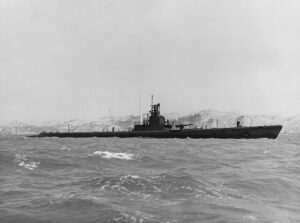 USS Wahoo was laid down on 28 Jun 1941, launched on 14 Feb 1942, commissioned 15 May 1942 under LCDR Marvin G. “Pinky” Kennedy. Lt. Richard O’Kane joined as XO (MoH in USS Tang) for five war patrols and then Morton. After training shakedown off San Diego and prepared at Mare Island on 12 August she sailed for Pearl Harbor for an exercise until 21 August. On 23 August 1942 she was on patrol west of Truk (Hall Islands and Namonuito Atoll). On 6 September she missed a lone freighter, which tried to ram her. From 20 September she sailed to the Namonuito Atoll, missed a freighter, with the frist 3, marked with the 4th (unconfirmed). On 1 October 1942 off Ulul Island she saw several trawlers. A few days later she missed IJN Chiyoda on 5 October, believed to be Ryūjō. On 17 October she was in Pearl Harbor. She was refitted at the tender Sperry and overhauled at Pearl Harbor and departed for her 2nd patorl on 8 November 1942 with Dudley Walker “Mush” Morton as PCO, in the Solomons. On 30 November she missed a small freighter. Next she was in Cape Hanpan, Buka-Kilinailau Channel and Truk-Shortland and back to Buka-Kilinailau. On 10 December she spotted and sank Kamoi Maru with three torpedoes.
USS Wahoo was laid down on 28 Jun 1941, launched on 14 Feb 1942, commissioned 15 May 1942 under LCDR Marvin G. “Pinky” Kennedy. Lt. Richard O’Kane joined as XO (MoH in USS Tang) for five war patrols and then Morton. After training shakedown off San Diego and prepared at Mare Island on 12 August she sailed for Pearl Harbor for an exercise until 21 August. On 23 August 1942 she was on patrol west of Truk (Hall Islands and Namonuito Atoll). On 6 September she missed a lone freighter, which tried to ram her. From 20 September she sailed to the Namonuito Atoll, missed a freighter, with the frist 3, marked with the 4th (unconfirmed). On 1 October 1942 off Ulul Island she saw several trawlers. A few days later she missed IJN Chiyoda on 5 October, believed to be Ryūjō. On 17 October she was in Pearl Harbor. She was refitted at the tender Sperry and overhauled at Pearl Harbor and departed for her 2nd patorl on 8 November 1942 with Dudley Walker “Mush” Morton as PCO, in the Solomons. On 30 November she missed a small freighter. Next she was in Cape Hanpan, Buka-Kilinailau Channel and Truk-Shortland and back to Buka-Kilinailau. On 10 December she spotted and sank Kamoi Maru with three torpedoes.
4 days later off the Shortland Islands she claimed to have sunk I-15. On 15 Decembe she was at Kieta Harbor and headed for Brisbane.
Her 3rd patrol from January 1943 under Cdr. Dudley W. Morton. Her gave a legendary address to the crew. From 16 January after sonar tests in Moreton Bay she sailed into Vitiaz Strait and between Kairiru Island and Mushu Island. On 24 January 1943 north of Kairiru and Victoria Bay she sighted IJN Harusame and several RO-class subs moored alongside. She launched three from 1,200 yd (1,100 m), missed. The DD dodge more. Morton fired his last last bow torpedo which hit Harusame amidships but she was beached and later repaired. Next she headed for Palau and on 26 January sighted two ships, sank Fukuei Maru, hit Buyo Maru and a tanker. They managed to flee, but Morton arose controversy as he surfaced and gunned down the Japanese rescapees at sea. VADM Charles A. Lockwood asserted these were army troops in boats startting firing at Wahoo will small arms. It seems some had been misidentified and were Indian POWs of 2nd Battalion, 16th Punjab Regiment. 1,126 men aboard Buyo Maru inc. 195 Indians and 87 Japanese died and it seems Morton fired only on the boats. On the CT was painted a brush with “swept clean” and the pennant “Shoot the sunza bitches”. Later USS Wahoo caught and sank the tanker and headed for Fais Island.
On 27 January 1943 she spotted a convoy and planned to scatter it and separate the sloer tanker, deal with it by gunfire. However charged by a destroyer and without torpedoes her had to dive. Later he plan to bombard a phosphorite refinery but spotted an inter-island steamer. Her was back at Pearl Harbor on 7 February.
Hr 4th patrol started on 23 February 1943 for Midway and headed for the northern Yellow Sea, Yalu River and Dairen in shallow waters. On 11 March he was on the Nagasaki-Formosa and Shimonoseki-Formosa routes. On 19 March 1943 she sank Zogen Maru. Next, Kowa Maru, was hit by two, one hit, one dud, 2 more missed. She escaped. Next off Chinnampo on 21 March she believed seeing Hozen Maru, launched three, one hit and she sank and hours later, Nittsu Maru. Three launches, two hit, she sank as well. Again he surfaced and finished the swimmers off by AA gunfire. On 22 March she headed close to Port Arthur, patrolled Laotiehshan Channel, sank the collier Katyosan Maru. Next at Round Island, southeast of Dairen he sighted smoke, torpedoed Takaosan Maru, but she needed six torpedoes.
The next day she spotted Satsuki Maru, launched two (exploded prematurely), and surfaced and close to engage her with her deck guns. She sank.
Later she spotted and attacked a small diesel-driven freighter still surfaced (fired her 20 mm and 4-inch deck gun), doging her ramming attempt. Then she spotted the trawler Bonshu Maru 95, blasted her with deck guns bou both 20 mm guns jammed. Undeterred, Morton distributed small arms from the locker and sent a party which went alongside to hurl homemade Molotov cocktails. On 28 March, she destroyed two motor sampans then a day later, attacked the Yamabato Maru, she sank. She concluded a record-shattering war patrol back in Pearl Harbor.
Next she was prepared to intercept Koga and the invasion of Attu to the Kuril Islands after a refit, at sea on 25 April. She reconnoitered Matsuwa and remaining island chain. On 4 May she was north of Etorofu, then southeast and caught seaplane tender Kimikawa Maru, fired three (two miss). She escaped.
3 days later she proceeded to Benten Saki, attacked. Sank Tamon Maru #5. Off Kobe Zaki she sighted a convoy, fired, had two exploding prematurely, one dud.
On 9 May 1943 approaching Kone Saki by Radar she picked up two targets, large tanker and freighter, fired three, two hits and kills, Takao Maru and Jinmu Maru.
In Tokyo-Paramushiro on 12 May, she sighted two freighters launched four, one hit. No kill, probable miss and dud, last torpedoes.Morton filled a vindicative report to Lockwood over the Mark 14, adding to the tall pile.
Her 5th war patrol started un unsurpassed record with 93,281 t sunk, 30,880 t damaged in 25 days. She was back at Pearl Harbor on 21 May 1943 and was greeted by Admiral Chester W. Nimitz to present awards. She was then overhauled at Mare Island from 29 May. On 20 July she received more awards from commander Captain John B. Griggs, Jr. She left Pearl Harbor on 2 August for Midway Island, to the sea of Okhotsk via Etorofu Strait and in the Sea of Japan, attacking three freighters, missed. On 15 August she attacked a large freighter, launched, but a dud. Two more missed, then from the stern, also missed. She evaded an Otori-class TB and headed for the Hokkaidō-Korea route. On 16 August she spotted and attacked a freighter, missed. Same ion the 17th. Agains, spotted another, missed. Next with two ships. One Mark 14 broached and exploded. Furious, Morton headed for another spot and after 4 days, he spotted 12 ships, made nine attacks for naight all missed or broach, had erratic runs and duds. Its Lockwood from ComSubPac which ordered Morton back to base for yet another report.
On 19 August he spotted a vessel he could soon see was flagged Soviet. In the La Perouse Strait he gunned down a sampan but made POWs, then two more. Her was back at Midway on 25 August, then Pearl Harbor on 29 August.
Being a top scorer, Morton was provileged to recaive a full load of Mark 18 electric torpedo. Via Midway on 13 September she sailed for La Perouse Strait and the Sea of Japan followed by USS Sawfish. On 21 October, he passed passed through the Kurils but USS Wahoo was never ever heard again.
On 25 September 1943 she reported sinking Taiko Maru, then probably Konron Maru on 5 October, west of Honshū and later she allegedly sank three other ships. It seems the Maizuru Naval District ordered an all ships present in a search and destroy operation. On 11 October Wahoo bombarded from Cape Sōya. Spotted by an Aichi E13A floatplane) a combined air and sea attack holed Wahoo, and she sank with all hands, declared overdue on 2 December 1943, stricken on 6 December 1943. She earned six battle stars. The search and discovery of her wreck is a long story in itself. She was found on 31 October 2006. A Russian plaque was deposed on May 2024.
 USS Whale (SS-239)
USS Whale (SS-239)
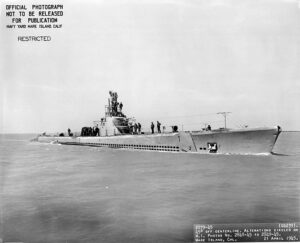 USS Whale was laid down on 28 Jun 1941, launched on 14 Mar 1942 and commissioned on 1 Jun 1942 under Lt. Cmdr. John B. Azer. After shakedown training and escorted by USS Kilty (DD-137) she left San Francisco on 4 August for San Diego to train until 9 September, and was later in Pearl Harbor, leaving on 9 October via Midway for the Japanese home islands, Kii Suido on 25 October. She made a recce for a future naval minefield. XO Frederick “Fritz” Harlfinger II (future USS Trigger skipper) convinced Azer to plant mines as close in as possible. This was a first, and five unexpected ships were blown up. Next at Seto Saki she sighted a large freighter, two hits, sank. Sighted a second, launched three, then stern shot on a third freighter, assumed sunk.
USS Whale was laid down on 28 Jun 1941, launched on 14 Mar 1942 and commissioned on 1 Jun 1942 under Lt. Cmdr. John B. Azer. After shakedown training and escorted by USS Kilty (DD-137) she left San Francisco on 4 August for San Diego to train until 9 September, and was later in Pearl Harbor, leaving on 9 October via Midway for the Japanese home islands, Kii Suido on 25 October. She made a recce for a future naval minefield. XO Frederick “Fritz” Harlfinger II (future USS Trigger skipper) convinced Azer to plant mines as close in as possible. This was a first, and five unexpected ships were blown up. Next at Seto Saki she sighted a large freighter, two hits, sank. Sighted a second, launched three, then stern shot on a third freighter, assumed sunk.
From 27 to 29 October she was at Bungo Suido. On 30 October off Ichie Saki, she saw two freighters and a torpedo boat, launched two, one hit, followed by a 17-hour chase. USS Whale was back to Pearl Harbor for repairs from 10 November to 2 January 1943. Her headed for the Marshalls, Wotje and Kwajalein on 10 January. On 13 January this was Kwajalein-Truk. She sank Iwashiro Maru. On 17 January he sank the troopship Heiyo Maru NE of Truk. Next in the Caroline Islands, 25 January her damaged the tanker Syoyo Maru but fled due to a chase. On the 26th, she launched and missed (dud). same scenation on the 27th but eventually managed to “sink” Shoan Maru, but she survived, towed to Saipan, grounded. Her head for Midway, arrived on 2 February.
Lt. Cmdr. Albert C. Burrows took command and USS Whale headed for the Mariana Islands, Tanapag, Saipan on 10 March. On 19 March, hit tow freighters, sank Mogamigawa Maru, and an Arizona Maru-like, wrecked. Whale was nearly sank by the escorts. Next, she patrolled between Kobe and Tokyo. On 22 March, spotted ships, lost contact, but regained it on two freighters, two spreads of three, two hits. Kenyo Maru blew up. The second was badly damaged but USS Whale narrowlt was hit by a circling torpedo. She was on Kobe-Saipan and Empire-Truk shipping routes on 25 March, fired 7 at a small freighter, all misses. On 28 March she spotted another small freighter heading for Truk, fired three, missed. Lack of fuel forced her homeward, arriving at Midway on 6 April, then Hawaii on 11 April, refitted and back at Midway on 5 May, started her 4th patrol on 10 May. She was ordered east of Wake on 16 May, to assist guiding B-24 Liberator bombers and as plane guard. Next she sailed for Saipan and patrolled here 20–24 May, then Guam. She trailed the auxiliary gunboat Shoei Maru, attacked on 26 May, one shot, obliterated in light, warmth and sound NNW of Rota Island. On 5 June she spotted a seaplane tender, closed, launched four, three hits. Unconfirmed.
On 8 June she went to Truk through the Marianas and a day after spotted two large freighters, launched three, two hits. Then three more. Two kills assumed.
Her 5th war patrol from July to September 1943 started from Midway on Tokyo–Truk shipping lanes marred by stormy weather, heavy seas, poor visibility. Waves washed her deck and she lost 23 battery cells. On 7 August 1943 she spotted and aircraft ferry and escort but saw her forward gyro regulator failing. All calculations were done manually. With one hit she stopped the Naruto Maru, second hit making her sank NW of the Marianas but dove to escaped IJN Asanagi. She later patrolled the Bonin, East China Sea weathered a typhoon. On 24 August she ws in ambush off Kusakaki Shima. She launched four at a convoy, four hits. But her battery was too low for safety. Underway to Midway she sighted twofrighters, launched three bow, 4th stern, all missed. She arrived on 2 September, and Pearl Harbor on 7 September for major overhaul until 7 December.
Back at at Midway on 25 December she started her 6th war patrol on the same Tokyo–Truk lanes, Minami Shima, Ryukyu, Bonin Island. On 14 Januaryshe was signalled by USS Seawolf a convoy coming her way. Seawolf attacked and sank a tanker but had no torpedoes left. Seawolf retored contect by radar on 16 January. Whale launched three, sank Denmark Maru SW of Okinawan verified by Seawolf. The latter attacked another by gunfire, fleeing in Whale’s direction. She fired four, one hit, then stern shot and sank Tarushima Maru, albeit she was not credited postwar.
She patrolled the Marianas and Bonins from 18 to 23 January and on the 24th she made contact with an enemy submarine, maneuvered but abandoned after a fire in the trim pump, and surfaced. Low on fuel she arrived at Midway on 3 February. Lt. Cmdr. James B. Grady took command on 9 February. Refitted at Pearl Harbor she headed to Midway on 13 March for her 7th patrol.
She joined USS Pollack (SS-180) on 23 March for Tori Shima and Bonins. Next she was in the East China Sea, western Kyūshū, Quelpart Island, Iki Shima. On 8 April, she sank Honan Maru. She patorlled off Nagasaki until 23 April and returned to the Bonin Islands to meet DE-35 on 2 May and having a refit at Majuro.
Escorted by USS Cassin (DD-372) as escort she left Majuro on 28 May for her 8th patrol to the home islands, spotted a convoy on 7 June, sank Shinroku Maru and damaged Sugiyama Maru off the Bonin Islands.
From 12 June to 4 July 1944 she remained on the southern coast of Japan, sighted aircraft and an hospital ship and headed back for Midway, then Hawaii for a refit until 12 August.
She left on 24 August for her 9th patrol, ordered by Admiral William “Bull” Halsey to be posted in ambish on the line between the western Caroline Islands and Philippines for Operation “Stalemate” (invasion of Palau). The “Zoo” of three wolfpacks was commanded by Charles W. (“Weary”) Wilkins, USS Seahorse (SS-304). Whale and Segundo (SS-398) where in his own pack, the “Bears.” She met Barbero (SS-317) on 8 September off Samar and remained eight days there.
On 17 September, they were sent southeast of Formosa on 20 September. Next she was sent to the South China Sea and Bashi Channel, Y’Ami Island (Batan Islands), south of Garan Bi (Formosa). Next she met USS Seahorse, and was posted southwest of Formosa, Cape Borjeador, Luzon, Calayan, Dalupiri. Next she patrolled the the Luzon Strait on 6 October, spotted a convoy, fired six at a tanker and submerged, sinking the Akane Maru off the Balintang Channel, verified by Seahorse.
Next she was ordered to meet USS Aspro (SS-309) and Cabrilla (SS-288) northwest of Luzon on 9-10 October. She was posted at Ryukyu Shoto and ordered back to Midway, arriving on 29 October.
On 21 November she started her 10th war patrol to the the Ryukyus (4 December). On 22 December she missed trawlers. On the 23th off Nakano Jima she surfaced to attack four trawlers with her 4-in and .50-cal. HMG and dealt with them in 80 minutes. By 4-5 January 1945 wuth Kingfish she searched near Sufu Gan for the 11 survivors of a downed B-29 in heavy seas, poor visibility. She was back to Hawaii on 15 January, overhauled at the west coast in Mare Island from 26 January 1945.
Back to Pearl Harbor she signalled issues with her hydraulic plant. Her enw captain was Lt. Cmdr. Freeland H. Carde, Jr. and she departed on 15 June for her 11th patrol via the Marianas, Saipan on 21 June and patrolling the Japan–Wake supply lines until 30 June, then Guam on 6 July in lifeguard duty. From 8–23 July she was in this role at the Nanpō Islands, Marianas, Bungo Suido. She spotted US bombers overhead, encountered a few freighters, rescued 15 downed aviators, some in the middle of floating naval mines. At her return, the skipper made many noteworthy recommendations to improve SAR.
Off Okino Shima on 30 July in heavy seas she was forced to dive. On 4 August she was in Bungo Suido and met with USS Dragonet (SS-293) to take a rescued pilot. On 9 August, she received 16 aviators from USS Blackfish (SS-221). On 11 August she ws ordered to Saipan and Midway, learning underway about the capitulation. She sailed with USS Scabbardfish for Hawaii, to the Panama Canal, New York City, Tompkinsville on 23 September then Rhode Island, Boston for Navy Day celebration, then New London on 30 October for inactivation, decommissioned in January 1947. In Portsmouth on 8 April 1948, then New London on 11 September 1948 she was partially activated (14 November-14 December 1956) replacing Tarpon (SS-175) as TS. Decommissioned last in September 1957, stricken 1 March 1960, she was sold on 29 September. She eaned 11 battle stars for 57,716 tons sunk.
 USS Angler (SS-240)
USS Angler (SS-240)
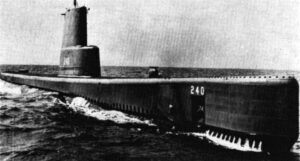 USS Angler was part of the second batch as lead ship, of the Electric Boat Company in Groton on 9 Nov 1942, launched on 4 Jul 1943 and commissioned on 1 Oct 1943. After shakedown in New London, Newport, Rhode Island, she sailed to Key West on 21 November at the Fleet Sound School, and for Pearl Harbor on the 27th, transferred from Pearl Harbor for her first war patrol on 10 January 1944. 29 January, sank Shuko Maru, damaged two others but she went for repairs, hearing “structural noises” prevented silent running and transited to Midway for repairs on 4 February. 2nd patrol started on 15 February for the east coast of the Philippines, Mindanao and Sulu Seas. She was sent to evacuate civilians by Dough MacArthur at Panay. She saved 58 men, women, and children from a Japanese massacre. She ended in Fremantle on 9 April started her 3rd patrol on 3 May as one of eight subs for Operation Transom and sailed for Surabaya between ambushes, lifeguard and blocking Sunda Strait and Lombok Strait to the Indian Ocean. On 20 May she sank Otori Maru. Before going back to Fremantle, the crew had nausea and it was clear her freshwater supply was contaminated. Back underway she was assisted by Flasher, Childs, Crevalle and arrived in Austrlia on 29 May. An investigation found improper clieaning by an electrician with carbon tetrachloride. Her 4th patrol started on 21 June via Exmouth Gulf but hit an uncharted obstruction and needed repairs in Fremantle, departing again on 29 June with a new starboard propeller. She met Flasher and Crevalle to the South China Sea, Indochinese coast, then west coast of Luzon. 25 July, she sank none but the WP claimed six ships. She was back on 23 August.
USS Angler was part of the second batch as lead ship, of the Electric Boat Company in Groton on 9 Nov 1942, launched on 4 Jul 1943 and commissioned on 1 Oct 1943. After shakedown in New London, Newport, Rhode Island, she sailed to Key West on 21 November at the Fleet Sound School, and for Pearl Harbor on the 27th, transferred from Pearl Harbor for her first war patrol on 10 January 1944. 29 January, sank Shuko Maru, damaged two others but she went for repairs, hearing “structural noises” prevented silent running and transited to Midway for repairs on 4 February. 2nd patrol started on 15 February for the east coast of the Philippines, Mindanao and Sulu Seas. She was sent to evacuate civilians by Dough MacArthur at Panay. She saved 58 men, women, and children from a Japanese massacre. She ended in Fremantle on 9 April started her 3rd patrol on 3 May as one of eight subs for Operation Transom and sailed for Surabaya between ambushes, lifeguard and blocking Sunda Strait and Lombok Strait to the Indian Ocean. On 20 May she sank Otori Maru. Before going back to Fremantle, the crew had nausea and it was clear her freshwater supply was contaminated. Back underway she was assisted by Flasher, Childs, Crevalle and arrived in Austrlia on 29 May. An investigation found improper clieaning by an electrician with carbon tetrachloride. Her 4th patrol started on 21 June via Exmouth Gulf but hit an uncharted obstruction and needed repairs in Fremantle, departing again on 29 June with a new starboard propeller. She met Flasher and Crevalle to the South China Sea, Indochinese coast, then west coast of Luzon. 25 July, she sank none but the WP claimed six ships. She was back on 23 August.
She departed again on 18 September. On 14 October with Bluegill in the Sulu Sea she sank Nanrei Maru.
On 22 October, she rescued 26 japanese stranded at sea, soldiers and naval ratings.
The folowing day she spotted a main Japanese force underway to attack the Allied invasion of Leyte. She later met Hardhead to receive onboard down Commander Fred E. Bakutis from VF-20 and was back to Fremantle on 9 November.
On 4 December she started her 6th patrol in lifeguard duty. On 13 December she was signalled to help Bergall badly damaged by a Japanese destroyer, found on 15 December and apart the Cdr and skeleton crew she took everyone o, board and escorted her over 2,000 nmi (3,700 km) into Exmouth Gulf on 20 December.
She was in Saipan on 6 February 1945, then Pearl Harbor, West Coast on the 24th for overhaul at Bethlehem Steel, until 18 May. She started her last patrol on 12 June via Saipan on the 27th then arrived east of Honshū. Few targets. Missed one on 25 July. Three shore bombardment missions on Kinkasan Island, Tomakomai, (Hokkaidō) and join joined Sea Poacher and Thornback firing torpedoes at boat sheds and boats plus all their guns.
She was back at Midway on 9 August, cessation of hostilities came when the crew was on R&R. She sailed for Pearl Harbor and then home. Panama on 14 September, New Orleans, 20 September, Jacksonville, Newport unloading her torpedoes on 2 November, New London on the 6th, Portsmouth, by February 1946 and back to New Londonn decommissioned on 12 February. Recommissioned on 2 April 1951, she had little service, was decom. on October 1952, adn overhaul, transformed as a SSK at General Dynamics Groton, completed by February 1953, recom. September, Atlantic Fleet. She served in the Med and among others was in 1958 Operation Springboard. In 1960 she was reverted as SS-240, served with the 6th Fleet and the submarine school in 1963 as AGSS-240 for the Naval Reserve, until decommissioned on 1 April 1968, Naval Reserve, from 30 June 1971, IXSS-240, struck 15 December 1971, Sold for BU 1 February 1974. She won six battle stars.
 USS Bashaw (SS-241)
USS Bashaw (SS-241)
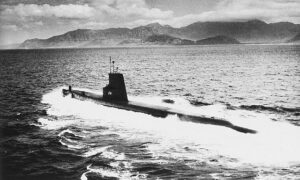 USS Bashaw was laid down at EB on 4 Dec 1942, launched in 25 Jul 1943 and commissioned on 25 Oct 1943 with LtCdr Richard E. Nichols in command. After shakedown in Long Island Sound, Fleet Sound School training at Key West, she departed on 9 January 1944 via Panama with USS Flounder and USS Golet to New Guinea at TF 72 at Milne Bay on 3 March. 1st patrol was with USS Blackfish from 10 March off the Palau. On 21 March she fired at a submarine tender six torpedoes (Urakami Maru), towed to safety by Yūzuki. On 13 April 1944 she was mistook and bombed by a PB4Y-1 Liberator 415 nm WSW of Truk. On 27 April she damaged three trawlers with gunfire. On 10 May she was in Brisbane. 2nd patrol started on 27 May to Mindanao. She attacked a convoy on 25 June, sank Yamamiya Maru. On 16 July she was resupplied at the tender USS Euryale (AS-22) in Seeadler Harbor, Manus. Her 3rd patrol started on 7 August for Mindanao and the Moro Gulf. On 8 September she sank Yanagigawa Maru. She ended in lifeguard for air strikes and on 9 September assisted airplanes sinking a small interisland supply ship and rescued a pilot on 19 September. She was in Brisbane on 4 October.
USS Bashaw was laid down at EB on 4 Dec 1942, launched in 25 Jul 1943 and commissioned on 25 Oct 1943 with LtCdr Richard E. Nichols in command. After shakedown in Long Island Sound, Fleet Sound School training at Key West, she departed on 9 January 1944 via Panama with USS Flounder and USS Golet to New Guinea at TF 72 at Milne Bay on 3 March. 1st patrol was with USS Blackfish from 10 March off the Palau. On 21 March she fired at a submarine tender six torpedoes (Urakami Maru), towed to safety by Yūzuki. On 13 April 1944 she was mistook and bombed by a PB4Y-1 Liberator 415 nm WSW of Truk. On 27 April she damaged three trawlers with gunfire. On 10 May she was in Brisbane. 2nd patrol started on 27 May to Mindanao. She attacked a convoy on 25 June, sank Yamamiya Maru. On 16 July she was resupplied at the tender USS Euryale (AS-22) in Seeadler Harbor, Manus. Her 3rd patrol started on 7 August for Mindanao and the Moro Gulf. On 8 September she sank Yanagigawa Maru. She ended in lifeguard for air strikes and on 9 September assisted airplanes sinking a small interisland supply ship and rescued a pilot on 19 September. She was in Brisbane on 4 October.
4th patrol started on 27 October with USS Flounder and Guavina to French Indochina and the South China Sea. On 21 November 1944 she damaged a tanker. On 14 December she reported a convoy and on Xmas day, was in the Lombok Strait, back at Fremantle on new years day. 5th patrol started on 26 January 1945 for Hainan Island, Gulf of Tonkin northeastern French Indochina. She sank a small coastal freighter on 10 February and joined USS Flasher sinking another. On the 25th she missed a small cargo ship, finished off by Flasher. On the 27th February she sank two “sea trucks”, damaging two more. On 5 March in fosh she had a radar contact, approached surfaced, fired six torpedoes, sank Ryoei Maru. On 6 March she sank a “sea truck” and resupplied at Sbic Bay to the tender USS Griffin (AS-13) on 12 March.
6th patrol started on 27 March off French Indochina-Hainan Island, no targets, back on 29 April. She was ordered for an overhaul at Mare Island and was back in Hawaii on 13 August, learning underway about V-Day. For WW2 she won 5 battle stars. Postwar she was very active as well but it’s off-topic. She eaned 3 bronze stars for Korea, and 3 service stars for Vietnam as SSK-241 and used as target off Hawaii on July 1972, sold 4 August.
 USS Bluegill (SS-242)
USS Bluegill (SS-242)
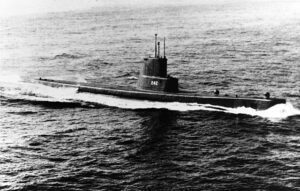 USS Bluegill was laid down 7 Dec 1942, launched on 8 Aug 1943, commissioned on 11 Nov 1943 under Lieutenant Commander Eric L. Barr Jr. After shakedown training she crossed the Panama Canal to departed Balboa and sailed to Milne Bay (New Guinea) on 22 March 1944. Her 1st patrl started on 1 April 1944 between northern Halmahera in the Maluku Islands, Sonsorol Island (Palau). On 10 April 1944 she spotted 3 ships but failed to take position. On 27 April 1944 she spotted a destroyer off Sonsorol but as she approached, IJN Yubari crossed her path. She launched six at Yubari, two hits, and she sank. Samidare charged and she launched four but missed, and she escaped. On 28 April she met a DD escorting a large landing barge, took position, fired, four missed. 1 May 1944, she spotted a convoy of 3, 2 escorts west of Palau, fire four, claimed Asosan Maru. She was later finished off by deck gun. On 10 May she resupplied in Manus (Admiralty) from USS Cero, they left for Halmahera-Morotai (Maluku) and on the 19th she missed a destroyer by miscalculation. On 20 May she spotted a merchant with two escorts, launched fou (stern tubes) claiming Miyaura Maru. On 22 May she spotted another convoy already attacked by USS Ray but she was detected by the submarine chasers. Later this was a Japanese plane and she lost contact. She ended in Brisbane via Manus on 7 June. She departed for her 2nd patrol on late June via Manus (5-6 July) and headed for Davao, Mindanao. On 20 July she missed a Nagara-class light cruiser. On 22 July she missed a merchant. In Sarangani Bay on 1 August she abandoned an attack on a cargo ship with three escorts, dept-charged.
USS Bluegill was laid down 7 Dec 1942, launched on 8 Aug 1943, commissioned on 11 Nov 1943 under Lieutenant Commander Eric L. Barr Jr. After shakedown training she crossed the Panama Canal to departed Balboa and sailed to Milne Bay (New Guinea) on 22 March 1944. Her 1st patrl started on 1 April 1944 between northern Halmahera in the Maluku Islands, Sonsorol Island (Palau). On 10 April 1944 she spotted 3 ships but failed to take position. On 27 April 1944 she spotted a destroyer off Sonsorol but as she approached, IJN Yubari crossed her path. She launched six at Yubari, two hits, and she sank. Samidare charged and she launched four but missed, and she escaped. On 28 April she met a DD escorting a large landing barge, took position, fired, four missed. 1 May 1944, she spotted a convoy of 3, 2 escorts west of Palau, fire four, claimed Asosan Maru. She was later finished off by deck gun. On 10 May she resupplied in Manus (Admiralty) from USS Cero, they left for Halmahera-Morotai (Maluku) and on the 19th she missed a destroyer by miscalculation. On 20 May she spotted a merchant with two escorts, launched fou (stern tubes) claiming Miyaura Maru. On 22 May she spotted another convoy already attacked by USS Ray but she was detected by the submarine chasers. Later this was a Japanese plane and she lost contact. She ended in Brisbane via Manus on 7 June. She departed for her 2nd patrol on late June via Manus (5-6 July) and headed for Davao, Mindanao. On 20 July she missed a Nagara-class light cruiser. On 22 July she missed a merchant. In Sarangani Bay on 1 August she abandoned an attack on a cargo ship with three escorts, dept-charged.
Off Maculi Point (Mindanao) on 7 August she spotted a cargo with two escorts, a decoy vessel and three aircraft overhead, launched four, to hits, Sanju Maru sank. On 13 August same scenario, one cargo with two TBs, two su chasers and a decoy vessel. She launched four torpedoes, sank the Sub Chaser No. 12 and Kojun Maru. She was back to Darwin and Fremantle on 24 August.
3rd patrol started on 18 September to the Sulu-Sibuyan Seas and South China Sea. On 6 October she surfaced and sank an interisland steamer off Bondoc and finished her off with a torpedo. On 12 October she surfaced in the middle of three small Japanese cargo ships (“sea trucks”) off Tumao Point but it turned awry when her 20-mm gun jammed as these were given 13 mm machine-guns, wounding several of her sailors. She submerged. On 18 October she crossed a 14-ship convoy off Manila but was unable to attack, reported these. Later she was ready and bagged the Arabia Maru, Chinzei Maru, Hakushika Maru. On 20 October she spent her last torpedoes on two Japanese tankers, damaged. She took extra torpedoes at Mios Woendi from 27 October and returned in the Sulu Sea. Off Borneo on 17 November she spotted a small Japanese transport but was chased off by three destroyer escorts. She was bac in Austrlian on 25 November.
She neded repair for battle damage and departed on 19 December for her 4th patrol. On Xmas night in Lombok Strait she was fired upon by a shore batter. Later she joined a wolfpack with USS Bream and Barbel. In January 1945 she did recon missions for the Philippine Islands full invasion. On 2 February she took onboard two Japanese POWs and was back to Fremantle on 7 Februar.
Her 5th patrol from 12 March via Lombok Strait saw her crossing a “sea truck”, attacking but missing on 19 March. After no kills off Borneo, she patrolled off French Indochina from 27 March, and met at Hon Doi USS Blackfin, Blueback to make a picket line. On 28 March she came to help for the attack of convoy HI-88J and nearly sank the tanker Honan Maru (formerly War Sirdar) she ground herself. On 29 March, hit Honan Maru. On 5-6 April she made a commando raid to blow up bridges and trains in French Indochina (Australian commandos, but this ended in failure). She finished off Honan Maru on 5 April and ended in Subic Bay on 18 April.
6th patrol from Subic Bay was in the South China Sea and Formosa. On 28 May she bombarded Pratas Island, sent a landing party to find the Japanese evacuated. They were back in Hawaii, on 21 June. She was sent to San Francisco on 2 July for overhaul and the war ended in between. Her cold war career was long and intensive.
After reserve at Mare Island until 1951 she became a TS for the Pacific Fleet then modified as a SSK at Hunters Point (SSK-242) recommissioned in May 1953, western Pacific and Korea. In 1959 she was reverted to SS-242 overhaul at Mare Island in 1964, and seein action in Vietnam, Gulf of Tonkin, North Vietnam 1965 then AGSS-242 in 1966, decommissioned at San Diego June 1969, stricken, scuttled as artificial reef in 1970 off Lahaina, Maui, then sunk in higher waters by 1983. Navy Unit Commendation (Yubari) 4 ww2 battle stars, 4 battle stars for Vietnam.
 USS Bream (SS-243)
USS Bream (SS-243)
USS Bream was laid down on 5 Feb 1943, launched on 17 Oct 1943, commissioned on 24 Jan 1944. To be completed at a later date.
 USS Cavalla (SS-244)
USS Cavalla (SS-244)
USS Cavalla was laid down on 4 March 1943, launched on 14 Nov 1943, commissioned 29 Feb 1944. To be completed at a later date.
 USS Cobia (SS-245)
USS Cobia (SS-245)
USS Cobia was laid down on 17 Mar 1943, launched on 28 Nov 1943 and commissioned on 29 Mar 1944. To be completed at a later date.
 USS Croaker (SS-246)
USS Croaker (SS-246)
USS Croaker was laid down on 1 Apr 1943, launched on 19 Dec 1943 and commissioned on 21 Apr 1944. To be completed at a later date.
 USS Dace (SS-247)
USS Dace (SS-247)
USS Dace was laid down on 22 July 1942, launched on 25 April 1943 and commissioned on 23 July 1943. To be completed at a later date.
 USS Dorado (SS-248)
USS Dorado (SS-248)
USS Dorado was laid down on 27 August 1942, launched on 23 May 1943 and commissioned on 28 Aug 1943. To be completed at a later date.
 USS Flasher (SS-249)
USS Flasher (SS-249)
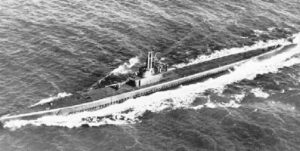 USS Flasher was laid down on 30 September 1942, launched on 20 Jun 1943, commissioned on 25 September 1943 under LtCdr Reuben T. Whitaker. She started her first patrols from Pearh Harbor on January–May 1944 from New London (departed 15 December 1943), and un 6 January she was underway to Mindoro, sinking on the 18th the Yoshida Maru and later Taishin Maru off Manila on 5 February, and sank two more (Minryo Maru, Hokuan Maru) of the same convoy on 14 February. She was back at Fremantle on the 29th.
USS Flasher was laid down on 30 September 1942, launched on 20 Jun 1943, commissioned on 25 September 1943 under LtCdr Reuben T. Whitaker. She started her first patrols from Pearh Harbor on January–May 1944 from New London (departed 15 December 1943), and un 6 January she was underway to Mindoro, sinking on the 18th the Yoshida Maru and later Taishin Maru off Manila on 5 February, and sank two more (Minryo Maru, Hokuan Maru) of the same convoy on 14 February. She was back at Fremantle on the 29th.
She departed on 4 April for French Indochina. On the 29th she spoted and sank the Vichy French aviso Tahure guarding Song Giang Maru off the Hon Doi Islands, sinking both. Next in the Sulu Sea on 9 May she sank Teisen Maru and was back at Fremantle on 28 May.
3rd war patrol was in the South China Sea. On 28 June she spotted and attacked a convoy of 13 ships and on the 29th sank Nippo Maru and badly damage da passenger cargo ship. Next on 7 July, Koto Maru. Next she spotted and attacked the cruiser IJN Ōi (Kuma class) escorted by a destroyer and in two attacks she sank her. Next she torpedoed and sank the merchant tanker Otoriyama Maru and damaged Tosan Maru (later sunk by another Gato). She was back at Fremantle 7-30 August and was vectored to the Philippines for her 4th war patrol with USS Hawkbill and Becuna. She was on lifeguard station but afterwards she sank the Saigon Maru (18 September) the Ural Maru (27) and Taibin Maru (4 October) and back on 20 October.
Under now LtCdr George W. Grider from 31 October she started her 5th patrol on 15 November for Cam Ranh Bay. On 4 December she changed course after a convoy was signalled, and in a heavy downpour, was surprised by the destroyer Kishinami but managed to send her ad patres with two hits. Next she launched at a tanker in rainsqualls (attack, dive, surfaced agaon) launched four, two hits on the DD IJN Iwanami and sinking Hakko Maru (later finished off by a torpedo). This was record. On 21 Decembe another convoy, she attacked and sank three large tankers, Omurosan Maru, Otowasan Maru, Arita Maru.
In Fremantle (2-29 January 1945) she started her 6th patrol off Indochina. On the 21th she sank a “sea truck” by surface gunfire, then the Koho Maru. She ended at Pearl Harbor 3 April, and sailed for her West Coast overhaul, back at for Guam for a shorttened 7th war patrol, which ended on the 15th August. She was redirected to New London, decommissioned, reserve 16 March 1946. On 1 June 1959 she was struck; sold for scrap on 1 June 1963, her conning tower perserved at the entrance to Nautilus Park in Groton, Conn. and then Thames Street-Bridge Street, transferred to U. S. Submarine Veterans, Inc. She won a Presidential Unit Citation for 3 patorls, six battle stars. ACE SUB, she won the 2nd rank in WW2.
 USS Flier (SS-250)
USS Flier (SS-250)
USS Flier was laid down on 30 Oct 1942, launched on 11 Jun 1943, commissioned on 18 October 1943. To be completed at a later date.
 USS Flounder (SS-251)
USS Flounder (SS-251)
USS Flounder was laid down on 5 December 1942, launched on 22 August 1943 and commissioned on 29 November 1943. To be completed at a later date.
 USS Gabilan (SS-252)
USS Gabilan (SS-252)
USS Gabilan was laid down on 5 January 1943, launched on 19 Sep 1943 and completed on 28 December 1943. To be completed at a later date.
 USS Gunnel (SS-253)
USS Gunnel (SS-253)
USS Gunnel was laid down on 27 July 1941, launched on 17 May 1942 and completed on 20 August 1942. To be completed at a later date.
 USS Gurnard (SS-254)
USS Gurnard (SS-254)
USS Gurnard was down on 2 September 1941, launched on 1 June 1942 and commissioned on 18 September 1942. To be completed at a later date.
 USS Haddo (SS-255)
USS Haddo (SS-255)
USS Haddo was laid down on 1 Oct. 1941, launched on 21 Jun 1942 and commissioned on 9 Oct 1942. To be completed at a later date.
 USS Hake (SS-256)
USS Hake (SS-256)
USS Hake laid down on 1 November 1941, launched on 17 July 1942 and commissioned on 30 Oct. 1942. To be completed at a later date.
 USS Harder (SS-257)
USS Harder (SS-257)
USS Harder was laid down on 1 Dec. 1941, launched on 19 Aug. 1942, commissioned on 2 Dec 1942. To be completed at a later date.
 USS Hoe (SS-258)
USS Hoe (SS-258)
USS Hoe was laid down on 2 Jan. 1942, launched on 17 Sep 1942, commissioned on 16 Dec 1942. To be completed at a later date.
 USS Jack (SS-259)
USS Jack (SS-259)
USS Jack was laid down on 2 Feb. 1942, launched on 16 Oct 1942, commissioned 6 Jan. 1943.
SUB ACE, 9th rank
 USS Lapon (SS-260)
USS Lapon (SS-260)
USS Lapon was laod down on 21 Feb. 1942, launched on 27 Oct. 1942, commissioned on 23 Jan 1943. To be completed at a later date.
 USS Mingo (SS-261)
USS Mingo (SS-261)
USS Mingo was laid down on 21 March 1942, launched on 30 Nov. 1942, commissioned on 12 Feb. 1943. To be completed at a later date.
 USS Muskallunge (SS-262)
USS Muskallunge (SS-262)
USS muskallunge was laid down on 7 Apr 1942, launched on 13 Dec. 1942 commissioned on 15 Mar. 1943. To be completed at a later date.
 USS Paddle (SS-263)
USS Paddle (SS-263)
USS Paddle was laid down on 1 May 1942, launched on 30 Dec. 1942 and commissioned on 29 Mar 1943. To be completed at a later date.
 USS Pargo (SS-264)
USS Pargo (SS-264)
USS Pargo was laid down on 21 May 1942, launched on 24 Jan 1943 and commissioned on 26 Apr. 1943. To be completed at a later date.
 USS Peto (SS-265)
USS Peto (SS-265)
USS Peto was laid down on Manitowoc Shipbuilding Company, on 15 June 1941 and launched on 30 Apr 1942, commissioned on 21 Nov 1942. To be completed at a later date.
 USS Pogy (SS-266)
USS Pogy (SS-266)
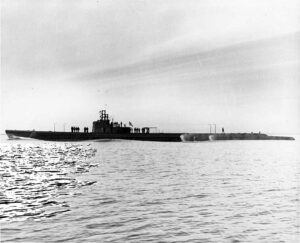 USS Pogy was laid down on 15 Sep 1941, launched on 23 June 1942 and commissioned on 10 January 1943. After fitting out and initial training she made her shakedown underway to Pearl Harbor, arriving on 5 April 1943. On the 15th April, shee proceeded to eastern Honshū, makingn made an attack on 1 May (convoy of five) and sank the ex-gunboat Keishin Maru, and later a destroyer with three torpedoes. Next day she gunned down a large sampan. On 9 May aborted attack (air strike). On 11 May, she sank a sampan. On 26 May she snak a small cargo ship. On 5 June Pogy she was back to Midway.
USS Pogy was laid down on 15 Sep 1941, launched on 23 June 1942 and commissioned on 10 January 1943. After fitting out and initial training she made her shakedown underway to Pearl Harbor, arriving on 5 April 1943. On the 15th April, shee proceeded to eastern Honshū, makingn made an attack on 1 May (convoy of five) and sank the ex-gunboat Keishin Maru, and later a destroyer with three torpedoes. Next day she gunned down a large sampan. On 9 May aborted attack (air strike). On 11 May, she sank a sampan. On 26 May she snak a small cargo ship. On 5 June Pogy she was back to Midway.
Her second patrol started on 26 June on the Home Idland-Truk communication line. Off Pulap Islands on 5 July, she sank two cargo ships with torpedoes, damaged a third. She spotted and sank the aircraft ferry Mongamigawa Maru on 1 August. Via Johnston Island she was back at Pearl Harbor and underway again on 9 Sept. 1943 in the Palau area. On 28 September, five ships spotted, two-day chase, sank Maebashi Maru. 6 October missed Nichiei Maru. 26 October back to Pearl Harbor. She was underway to the Palau Islands on 25 November. 7 December she sank a submarine tender and damaged a cargo ship, finished off later by night.
On 13 December she sank Fukkai Maru leaving Palau. Back to Midway 22 December.
5th patrol, 5 February 1944 from Midway in the Formosa area. 10 February, spotted a convoy in Bashi Channel and sank the Minekaze and Malta Maru, damaged another. East of Formosa(Taiwan) on 20 February she sank the Taizin Maru and Nanyo Maru. Off Ryukyu she sank another and was back at Pearl Harbor on 8 March 1944.
Her 6th war patrol commenced on 7 April southeast of Japan. 28–29 April she surprised and sank the surfaced sub I-183. Later on 5 May she sank a cargo and on the 13th a medium cargo ship, 16th a sampan by gunfire, 20 May small trawler. She was back in Pearl Harbor on 29 May, departed 1 June for her West Coast overhaul and returned in September. By 13 October 1944 she started her 7th patrol, in the Ryukyu and Nansei islands. No spot, back to Midway 2 December.
On 27 December, 8th patrol, Bonin-Volcano Islands. 14 January 1945, missed three cargo ships. Back to Midway 11 February.
9th patrol, 12 March 1945, Tokyo Bay. 19 April, lifeguard duty, southeast of Honshu. Mistook by a B-24 Liberator. Extensive damage, no casualties. 29 April she rescued ten Army aviator (B29 Queen Bee) and headed for Saipan . On 6 May she sailed to Pearl Harbor for refit and departed for her last patrol on 2 July in the Sea of Japan, ran under minefields in the Emperor’s private ocean” until V-J Day. 27 July: Sank a large cargo ship, damaged a tanker on 2 August, and claimed on 5 August the Kotohirasan Maru. Back to Midway on 21 mission accomplished.
She left Midway on 5 September for Panama, East Coast, New York 3 October, decommissioned, US Atlantic Reserve Fleet on 20 July 1946 in New London, struck 1 September 1958, sold 1 May 1959. ACE SUB: 20th rank, 8 battle stars.
 USS Pompon (SS-267)
USS Pompon (SS-267)
USS Pompon was laid down 26 Nov 1941, launched on 15 Aug 1942 and commissioned on 17 Mar 1943. To be completed at a later date.
 USS Puffer (SS-268)
USS Puffer (SS-268)
USS Puffer was laid down on 16 Feb 1942, launched on 22 Nov 1942, commissioned 27 Apr 1943. To be completed at a later date.
 USS Rasher (SS-269)
USS Rasher (SS-269)
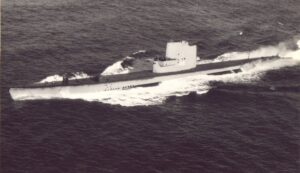 USS Rasher was laid down 4 May 1942, launched on 20 Dec 1942 and commissioned on 8 Jun 1943 under Commander E. S. Hutchinson, previously relieved by Admiral Charles A. Lockwood from USS Grampus (SS-207) for “lacking aggressiveness”. So he was sure to redeem himself and his boat, indeed the boat won four Presidential unit citation and seven battle stars. But USS Rasher had a long career postwar as well. After builder’s trials in Lake Michigan, towed down the Mississippi, fitted out in New Orleans, she trained in the Bay of Panama and left Balboa on 8 August 1943 for Brisbane on 11 September and departed for her 1st patorl on 24 September in the Makassar Strait and Celebes Sea, siking Kogane Maru on 9 October. Off Ambon later she sank Kenkoku Maru. On 31 October off the Borneo coast she trailed and sank by night the tanker Koryo Maru. Next she sank the tanker Tango Maru on 8 November. Off Mangkalihat Peninsula she damaged another tanker but sank her later by night due to counterattacks. While in the Indian Ocean off Exmouth Gulf, Western Australia on 20 November she was mistook and and bombed, no damage. She was bacl at Fremantle on 24 November and Hutchinson was promoted to command a submarine division, leaving the boat to Willard Ross Laughon, previously on R-1 in the Atlantic. She started her 2nd patrol on 19 December in the South China Sea, off Borneo. She attacked a three-tanker convoy on 4 January and sank Kiyo Maru. She laid mines mines off Saigon but had premature detonation of several Mark 14s torpedoes that late in the war, failed on 11 and 17 January and was back to Fremantle.
USS Rasher was laid down 4 May 1942, launched on 20 Dec 1942 and commissioned on 8 Jun 1943 under Commander E. S. Hutchinson, previously relieved by Admiral Charles A. Lockwood from USS Grampus (SS-207) for “lacking aggressiveness”. So he was sure to redeem himself and his boat, indeed the boat won four Presidential unit citation and seven battle stars. But USS Rasher had a long career postwar as well. After builder’s trials in Lake Michigan, towed down the Mississippi, fitted out in New Orleans, she trained in the Bay of Panama and left Balboa on 8 August 1943 for Brisbane on 11 September and departed for her 1st patorl on 24 September in the Makassar Strait and Celebes Sea, siking Kogane Maru on 9 October. Off Ambon later she sank Kenkoku Maru. On 31 October off the Borneo coast she trailed and sank by night the tanker Koryo Maru. Next she sank the tanker Tango Maru on 8 November. Off Mangkalihat Peninsula she damaged another tanker but sank her later by night due to counterattacks. While in the Indian Ocean off Exmouth Gulf, Western Australia on 20 November she was mistook and and bombed, no damage. She was bacl at Fremantle on 24 November and Hutchinson was promoted to command a submarine division, leaving the boat to Willard Ross Laughon, previously on R-1 in the Atlantic. She started her 2nd patrol on 19 December in the South China Sea, off Borneo. She attacked a three-tanker convoy on 4 January and sank Kiyo Maru. She laid mines mines off Saigon but had premature detonation of several Mark 14s torpedoes that late in the war, failed on 11 and 17 January and was back to Fremantle.
3rd war started on 19 February in the Java Sea–Celebes area. On 25 February she attacked a convoy off Bali, sank Tango Maru and later Ryusei Maru (both were troopships witith force labourers and POWs). In the Celebes Sea she sank Nattai Maru on 3 March. On 19 March she spotted the subs Ro-112 in the Java Sea, north of Bali (Cape Bungkulan), fired four Mark 14 Mod 3 but she evaded them. On the 27th she sank Nichinan Maru.
Back in the Makassar Strait her 4th patrol started on 30 April. On 11 May she sank Choi Maru and on the 29th, Anshu Maru and the tanker Shioya Maru on 8 June off Manado. On 14 June, Koan Maru. She was back home late June.
Her 5th patrol started on 22 under Henry G. Munson with USS Bluefish in the South China Sea and west of Luzon. Off Scarborough Shoal at 22:55, 5 August she launched six torpedoes on a convoy heard five hits, was attributed postwar the Shiroganesan Maru. On 18 August she detected a convoy of 13 ships and sank Teiyo Maru and later the large troopship (17k tons) Teia Maru (2,665 Japanese soldiers went down). But the same night at 22:14 she spotted a large CV, launched three torpedoes which sank the 20,000 ton carrier IJN Taiyō escorting the convoy, fourth claimed another ship. The convoy splitted, later Bluefish sank two tankers. Rasher claimed on her side the Eishin Maru (ammunition detonation) and later the Noshiro Maru before beiong back with the wolfpack and hitting the surviving transports on 18 August (6 launched, 5 detonations on 5 August) and headed back to Midway. Rasher in this patrol alone sunk the highest tonnage of any US sub ever, beaten by USS Archerfish (SS-311) “cheating” by sinking Shinano three months later. She had an overhaul at San Francisco from 11 September and started her new campaign under Benjamin Ernest Adams Jr. for her 6th patrol via Peral from Midway in early January 1945 in wolfpack (Pilotfish, Finback) and on 29 January was south of the East China Sea, missed two ships on 15 February, later was unable to attack a convoy, then another convoy, missed. She spared an hospital ships and was back to Guam on 16 March. Charles Derick Nace replaced Adams, starting her 7th patrol on 17 April, in lifeguard station off Honshū, only claiming two small craft and back to Midway on 29 May. On 23 June she sortied in lifeguard station off southern Formosa and hunted in the Gulf of Siam but the the war ended and she headed to resupply at Subic Bay, undrway on 31 August for New York on 6 October, via Pearl Harbor and Panama, deactivated, decommissioned 22 June 1946, Atlantic Reserve Fleet at New London.
Postwar career, briefly: Service as radar picket submarine, 1953–1960 as SSR-269, 7th Fleet and SEATO, exercise “Blue Star”.
Vietnam War service as AGSS 269. WestPac exercises, support of 7th Fleet operations, training for ROKN, Thailand. She was decommissioned on 27 May 1967, IXSS-269 in Portland, TS for reservists, stricken 20 December 1971.
 USS Raton (SS-270)
USS Raton (SS-270)
USS Raton was laid down on 29 May 1942, launched on 24 Jan 1943, commissioned on 13 Jul 1943. To be completed at a later date.
 USS Ray (SS-271)
USS Ray (SS-271)
USS Ray was laid down on 20 Jul 1942, launched on 28 Feb 1943, commissioned on 27 Jul 1943. To be completed at a later date.
 USS Redfin (SS-272)
USS Redfin (SS-272)
USS Redfin was laid down on 3 Sep 1942, launched on 4 Apr 1943, commissioned on 31 Aug 1943. To be completed at a later date.
 USS Robalo (SS-273)
USS Robalo (SS-273)
USS Robalo was laid down on 24 Oct 1942, laucnhed on 9 May 1943, commissioned 28 Sep 1943. To be completed at a later date.
 USS Rock (SS-274)
USS Rock (SS-274)
USS Rock was laid down on 23 Dec 1942, launched on 20 Jun 1943, commissioned on 26 Oct 1943. To be completed at a later date.
 USS Runner (SS-275)
USS Runner (SS-275)
USS Runner was the first ofthe second batch from state-sponsored yard Portsmouth Naval Shipyard in Kittery, Maine. She was laid down on 8 Dec 1941, launched on 30 May 1942 and commissioned on 30 July 1942. To be completed at a later date.
 USS Sawfish (SS-276)
USS Sawfish (SS-276)
USS Sawfish was laid down on 20 Jan 1942, launched on 23 Jun 1942, commissioned on 26 Aug 1942. To be completed at a later date.
 USS Scamp (SS-277)
USS Scamp (SS-277)
USS Scamp was laid down on 6 Mar 1942, launched on 20 Jul 1942 and commissioned 18 Sep 1942. To be completed at a later date.
 USS Scorpion (SS-278)
USS Scorpion (SS-278)
USS Scorpion was laid down on 20 Mar 1942, launched on 20 Jul 1942, commissioned on 1 Oct 1942. To be completed at a later date.
 USS Snook (SS-279)
USS Snook (SS-279)
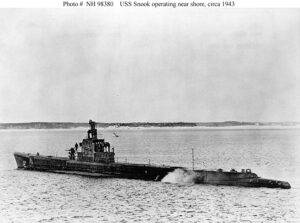 USS Snook was laid down on 17 Apr 1942, launched on 15 Aug 1942 and commissioned 24 Oct 1942. After shakedown training off New England coast she departed New London on 3 March 1943 for the Pacific, stopped ay Pearl Harbor, underway on 11 April for the Yellow Sea-East China Sea, minelaying in in the Shanghai area. On 5 May she spotted two freighters off Dairen and later sank Kinko Maru. The second dodge two torpedoe and opened fire, forcing Snook to withdraw buy came bacl later, launched three, claimed Daifuku Maru. On 7 May she trailed a convoy, overtakook them, launched four torpedoes, then three, claiming the Hosei Maru, damaged the others. On 13 and 16 May she sank surfaced armed trawlerts and went back to Midway on the 23th.
USS Snook was laid down on 17 Apr 1942, launched on 15 Aug 1942 and commissioned 24 Oct 1942. After shakedown training off New England coast she departed New London on 3 March 1943 for the Pacific, stopped ay Pearl Harbor, underway on 11 April for the Yellow Sea-East China Sea, minelaying in in the Shanghai area. On 5 May she spotted two freighters off Dairen and later sank Kinko Maru. The second dodge two torpedoe and opened fire, forcing Snook to withdraw buy came bacl later, launched three, claimed Daifuku Maru. On 7 May she trailed a convoy, overtakook them, launched four torpedoes, then three, claiming the Hosei Maru, damaged the others. On 13 and 16 May she sank surfaced armed trawlerts and went back to Midway on the 23th.
She departed on 9 June for the Ryukyu Islands. On the 24th she trailed a 6-ship convoy, launched two and damaged a tanker (survived), kept afar by destroyers. On 3 July she made radar contact, trailed the convoy, launched all six later and claimed Koki Maru and Liverpool Maru, badly damaging Atlantic Maru. She was in Pearl Harbor on 18 July.
For her 3rd war from 18 August she was at Marcus Island on the 30th for recce, then lifeguard duty from 1 September and resumed patrol in the East China Sea. On 13 September, she sank the large transport Yamato Maru. On 22 September she sank the Katsurahama Maru off Dairen. On 29 September she surfaced and downed a 500 ton vessel but her return fire had four injured. She was at Pearl Harbor on 8 October. Her 4th patrol was a coordinated attack group with USS Pargo and Harder in the Marianas. On 29 November she sank Yamafuku Maru, Shiganoura Maru, damaging the escort and back to Midway Island on 7 December, the Pearl Harbor, western coast of Kyūshū in January 1944 for her 5th patorl. Off the Bonin Islands on 23 January she sank the Magane Maru. On 8 February she entered a 13-ship convoy, sank the troopship Lima Maru and later badly damaged the Shiranesan Maru. On 14 February she sank the Nittoku Maru, and later the Hoshi Maru 2. On 23 February underway to Midway Island, she crossed an enemy convoy 8 miles away, fire five, sank the passenger-cargo Koyo Maru. She ended on 6 March and sailed for home, Hunters Point NyD for her major OVL. Her 6th patrol saw her msising two freighters on 12 July, and no targets. She ended in Midway on 14 August.
Her 7th patrol was in Luzon Strait-South China Sea via Saipan for repair. She attacked a convoy on 23 October, sank Shinsei Maru 1, evaded escorts and later sank the tanker Kikusui Maru and later claimed a “hell ship”, Arisan Maru (1,773 American POWs went down). Underway back she rescued a downed airman and was back to Pearl Harbor on 18 November.
8th patrol was in the Kuril Islands from 25 December 1944 to 17 February 1945. Sje only spotted Soviet vessels.
In her 9th patrol in the South China Sea-Luzon Strait on 8 April, she reported her position to USS Tigrone nearby, but no news were received since. On 12 April, she was ordered to take lifeguard station off Sakishima Gunto in support for the commander of the British carrier task force bu got no answer. USS Bang searched for her and found nothing, later she was reported “presumed lost due to unknown causes”. She sank 17 ships for 7 battle stars, 10th rank of ace submarines. She was perhaps rediscovered in 1995 under 1,148 feet (350 m) off Iriomote Island, Okinawa chain. Conditions were rough and divers never returned to the site.
 USS Steelhead (SS-280)
USS Steelhead (SS-280)
USS Steelhead was laid down on 1 Jun 1942, launched on 11 Sep 1942 and commissioned on 7 Dec 1942. To be completed at a later date.
 USS Sunfish (SS-281)
USS Sunfish (SS-281)
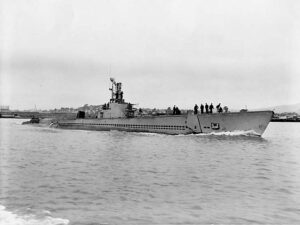 USS Sunfish was laid down as the lead bot of the second bacth from Mare Island Naval Shipyard, in Vallejo. She was laid down on 25 Sep 1941, launched on 2 May 1942 and commissioned on 15 Jul 1942 with LtCdr. Richard W. Peterson in command. After her shakedown in the San Diego Bay area she sailed to San Francisco for post-shakedown repairs and from 26 October departed for the Pacific, arrived at Pearl Harbor on 1 November, 1st war patrol from the 23th off Honshū and Hokkaidō. She laid a minefield at the entrance of Iseno Imi (16 December) and two days later, torpedo damaged Kyowa Maru. She was back on 14 January 1943 at Midway. She was underway on 4 February in the East China Sea. She torpedoed and damaged a ship on 4 March, later fired four, scored three at a transport but was repelled by a DD. On 13 March she sank Kosei Maru off Takarajima and was back to Pearl Harbor on 3 April.
USS Sunfish was laid down as the lead bot of the second bacth from Mare Island Naval Shipyard, in Vallejo. She was laid down on 25 Sep 1941, launched on 2 May 1942 and commissioned on 15 Jul 1942 with LtCdr. Richard W. Peterson in command. After her shakedown in the San Diego Bay area she sailed to San Francisco for post-shakedown repairs and from 26 October departed for the Pacific, arrived at Pearl Harbor on 1 November, 1st war patrol from the 23th off Honshū and Hokkaidō. She laid a minefield at the entrance of Iseno Imi (16 December) and two days later, torpedo damaged Kyowa Maru. She was back on 14 January 1943 at Midway. She was underway on 4 February in the East China Sea. She torpedoed and damaged a ship on 4 March, later fired four, scored three at a transport but was repelled by a DD. On 13 March she sank Kosei Maru off Takarajima and was back to Pearl Harbor on 3 April.
3rd patrol: 4 May to 24 June, off Truk Atoll. She made a recce of Anguar Island on 23 May, shelled a refinery on Fais Island. Until 25 September she patrolled off Formosa. On 13 August, she sank a tanker and the converted gunboat Edo Maru. On 4 September she attacked a 10-ship convoy, sank Kozon Maru and was back at Pearl Harbor, then underway from 16 October northeast of Formosa, no luck, back at Pearl Harbor on 14 December.
On 14 January 1944 under LtCdr Edward E. Shelby she patorlled between the Caroline and Marianas, made a recce of Kusaie (21-30 January). On 23 February she attacked a convoy, sinking Kunishima Maru and Shinyubari Maru and was back to Pearl Harbor on 7 March, then San Francisco for an overhaul until June 1944.
In Pearl Harbor she sailed for her 7th war patrol on 22 June to the Kuril Islands, sank on5 July Shanmai Maru and destroyed 14 sampans and trawlers, but she also mistakenly sank the Soviet merchant ship Ob on 6 July and later the Taihei Maru on 9 July. She was back to Midway on 1-19 August and departed for her 8th patrol on 20 August into the Yellow Sea. On 10 September she attacked a convoy, sank Chihaya Maru and damaged other ships. On 13 September she sank Etashima Maru and claimed damage on other ships, one assumed sank. She was back to Pearl Harbor on 27 September.
For her 9th patrol she sailed for the Yellow Sea on 23 October in wolf pack with USS Peto (SS-265) and Spadefish (SS-411). On 17 November, she reported a convoy of eight ships led the carrier IJN Shinyo. She was out of range but was trailed by others in the wolfpack. She sank the troopships Edogawa Maru and Seisho Maru and later torpedoed and sank Shinyo while USS Peto sank Aisakasan Maru and Chinkai Maru. On 29 November she sank Daiboshi Maru and a day later, Dairen Maru. She ended in Majuro, Marshalls, on 19 December. Between them, they sank 60,000 tons of shipping. She left Majuro on 15 January in the East China-Yellow Sea and on 20 February 1945, she collided with an ice floe, ending her patrol due to the damage. She was repaired at Guam. Her 11th was also her last patrol from 31 March 1945 under LtCdr. John W. Reed, off Honshū and Hokkaidō and then Ominato in April. On the 9th she damaged a ship running for harbor cover. On the 13th she missed a merchantman but made a daylight attack on 16 April; claiming the transport Manryu Maru and Coast Defense Vessel No. 73. Her last torpedoes were fired in night-radar attacks with Kaiho Maru and Taisei Maru. Back to Pearl Harbor on 28 April she departed for home and an overhaul in Mare Island until 31 July. In Pearl Harbor on 9 August she was underway for a 12th patorl when learning about V-day. Back to Mare Island on 5 September she was inactivated, decommissioned on 26 December, first of the Gato class decommissioned. She became a stationary classroom for naval reserve units and was stricken on 1 May 1960. ACE SUB: She sank 59,800t, nine battle stars, 23th on 250.
 USS Tunny (SS-282)
USS Tunny (SS-282)
USS Tunny was laid down on 10 Nov 1941, launched on 30 Jun 1942, commissioned on 1 Sep 1942. To be completed at a later date.
 USS Tinosa (SS-283)
USS Tinosa (SS-283)
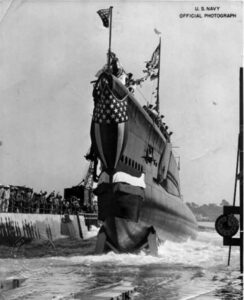 USS Tinosa was laid down on 21 Feb 1942, launched on 7 Oct 1942, commissioned on 15 Jan 1943 under Lt. Comdr. Lawrence Randall Daspit in command.
USS Tinosa was laid down on 21 Feb 1942, launched on 7 Oct 1942, commissioned on 15 Jan 1943 under Lt. Comdr. Lawrence Randall Daspit in command.
From Pearl Harbor on 16 April she departed on 3 May for her first patrol until 19 June, damaging three ships east of Kyūshū. After a refit-repairs at Midway, she sailed on 7 July to patrol between Borneo and Truk. On 24 July 1943 she missed the largest Japanese tanker (19,262 tons), Tonan Maru No. 3 underway from Palau to Truk, vectored in by Codebreakers. He fire more, all duds or going well under her keel. In the end she spent all remaining for naught and sailed back to Pearl Harbor. Daspit complained at SUBPAC’s office on his firing all 15 Mark 14 torpedoes over two days with just 2 “working” (but not detonating). It was reported higher up by Rear Admiral Lockwood (COMSUBPAC) and recommended technical changes. Her 3rd patrol started on 23 September from Pearl Harbor to the Carolines. On 6 October she damaged a lone tanker but was DC attacked, a fire broke out in the motor room. Alongside Tinosa and Steelhead she continued toa attack the tanker until she sank. On 6 October she surfaced to shell the radio station on Alet Island (Truk) and ended at Midway on 16 October.
4th patrol started on 27 Octobe to the Palau-Truk sea lanes. On 22 November she spotted a convoy, fired six torpedoes, hitting both cargo ships (wrecked) but she counter-attack was fierce: She lost her planes, gyro, steering, internal communications among others and climb to 250 feet, dove to 380 feet and regained control. On 26 November, she sank Shini Maru and fired a torpedo stuck in tube. In the Molucca Passage-Palau she spotted and sank Azuma Maru then ended at Fremantle on 16 December.
From 10 January 1944 she headed for the South China Sea to land an intel team at Labian Point (North Borneo) on 20 January, and patrolled the Flores Sea. She sank Koshin Maru and Seinan Maru, damaged a third off Viper Shoal. On 15-16 February she sank Odatsuki Maru and Chojo Maru and was back at at Pearl Harbor on 4 March. Her next patrol was in WP with USS Parche and Bang in the East China Sea from 29 March. Then in the Ryukyus. Her group pressed six major convoy attacks, herself sank Taibu Maru and Toyohi Maru on 4 May. Later she gunned down three other vessels and was back at Majuro on 15 May.
She departed on 7 June for the East China Sea. On the 18th she surfaced and sank a three-masted 400-ton sampan. She finished the work of her guns by covering her deck with oil-soaked rags and put them in flames. On 2 July she was bombed by Japanese planes and patrol vessels off Nagasaki. Later she bagged Konsan Maru and Kamo Maru and ended at Hunters Point on 7 August for her main overhaul.
From Pearl Harbor, she was assigned to Nansei Shoto ofor recce and test her FM sonar to detect Japanese mines. She was back to Pearl Harbor and departed on 17 March 1945 from Tanapag (Marshalls) to Nansei Shoto, mapping minefuields with her “temperamental” FM sonar. She was back in Guam, on 7 April.
On 28 April she sailed for Truk she again mapped min,efields and on 3 May, was air attacked off Moen Island. She shelled IJN facilities at Ulul Island on 14 May and gathered more intel and ended in Guam on 16 May.
She was back in the Sea of Japan on 29 May, rescued 10 airmen from a B-29. With a wolf pack she took part in Operation Barney into the Sea of Japan, plotting minefields in Tsushima Strait on 6 June. On 12 June she made six torpedo attacks, sank three cargo ships and gunned down Keito Maru, damaged another and ended in Pearl Harbor on national day, 4 July.
She started her 12th patrol on 11 August and learned of the capitulation underway. She left Midway on 26 August for an overhaul at San Francisco and training until June 1946, in reserve and decommissioned on January 1947, but recom. in 1952–53. She was stricken on 1 September 1958 and her hull was used as ASW target until scuttled off Hawaii by November 1960. ACE SUB: 18th rank, 3 Presidential Unit Citation, nine battle stars.
 USS Tullibee (SS-284)
USS Tullibee (SS-284)
USS Tullibee was laid down on 1 Apr 1942, launched on 11 Nov 1942, commissioned on 15 Feb 1943. To be completed at a later date.
 USS Golet (SS-361)
USS Golet (SS-361)
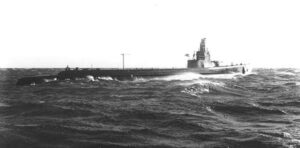 USS Golet was among the four last of the FY43 Gato class (should have been Balao class) laid down by Manitowoc Shipbuilding on 27 Jan 1943, launched on 1 Aug 1943 and commissioned on 30 Nov 1943. She had been partly built with war bonds from Shreveport and Cadddo Parish, Louisiana. She was transferred via the Misissippi on drydock to New Orleans, trained there, as well as in Balboa, then Hawaii and left Pearl Harbor on 18 March 1944 for her 1st patrol off the Kurile Islands, Southern Hokkaidō, Eastern Honshū, mared by the monsoon, fog, rain, ice. No luck. Back to Midway on 3 May. 2nd patrol under LtCdr James S. Clark, departed Midway on 28 May for northern Honshū, Japan, never heard from again. Presumed lost 26 July 1944. Japanese records: Probably sunk on 14 June 1944. A plaque was erected at Metairie, Louisiana.
USS Golet was among the four last of the FY43 Gato class (should have been Balao class) laid down by Manitowoc Shipbuilding on 27 Jan 1943, launched on 1 Aug 1943 and commissioned on 30 Nov 1943. She had been partly built with war bonds from Shreveport and Cadddo Parish, Louisiana. She was transferred via the Misissippi on drydock to New Orleans, trained there, as well as in Balboa, then Hawaii and left Pearl Harbor on 18 March 1944 for her 1st patrol off the Kurile Islands, Southern Hokkaidō, Eastern Honshū, mared by the monsoon, fog, rain, ice. No luck. Back to Midway on 3 May. 2nd patrol under LtCdr James S. Clark, departed Midway on 28 May for northern Honshū, Japan, never heard from again. Presumed lost 26 July 1944. Japanese records: Probably sunk on 14 June 1944. A plaque was erected at Metairie, Louisiana.
 USS Guavina (SS-362)
USS Guavina (SS-362)
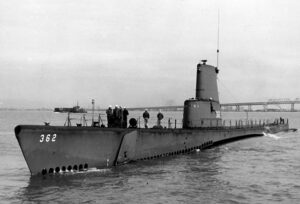 USS Guavina was laid down on 3 March 1943 at Maniwotoc, launched on 29 August 1943 and completed on 23 December 1943. After shakedown, transferred down the Mississippi to New Orleans she trained at New Orleans and Balboa and was at Pearl Harbor on 5 April. 1st patrol started on 6 April. 22 April, gunned down two trawlers and on the 25th, a large “maru”. 26 she sank Noshiro Maru, and claimed a second. After lifeguard duty off Wake Island she resupplied at Majuro on 28 May.
USS Guavina was laid down on 3 March 1943 at Maniwotoc, launched on 29 August 1943 and completed on 23 December 1943. After shakedown, transferred down the Mississippi to New Orleans she trained at New Orleans and Balboa and was at Pearl Harbor on 5 April. 1st patrol started on 6 April. 22 April, gunned down two trawlers and on the 25th, a large “maru”. 26 she sank Noshiro Maru, and claimed a second. After lifeguard duty off Wake Island she resupplied at Majuro on 28 May.
2nd patrol started on 20 June to Brisbane, sinking 1 ship, rescuing 12 aviators. 13:24 3 July radara contact. 03:48 next morning, launched four, claimed Tama Maru. Lifeguard duty off Yap 2-21 July, picked 12 airmen, ended in Brisbane. 3rd patrol from 16 August along the Philippine coast of Mindanao. 31 August sank two small coastwise steamers. Lifeguard dut. 15 September spotted and launched three at a transport at anchor. Launched three more, 3 hits. Three more, 2 hits, she sank. 4th patrol from Brisbane on 27 October, South China Sea. 15 November sank a “maru” loaded with aviation gasoline. Sank a tanker on 22 November, another on the 23th. Ended in Perth 27 December.
5th patrol with Pampanito, Becuna and Blenny from 23 January, South China Sea. 6 February she bagged the Taigyo Maru. 20th she diverted attention for Pampanito to bag the tanker Eiyo Maru. She was severely DCd for 7 hours, was repaired at Subic Bay from 5 March.
6th war patrol from 21 March with Rock, Cobia, Blenny in the South China Sea. No luck but rescued 5 airmen on the 28th, back to to Pearl Harbor on 8 May, then West Coast for overhaul. Completed 6 August, learned V day underway, back to the States with 5 battle stars, reserve in Mare Island, Decommissioned 8 June 1946. Converted as oiler under project SCB 39 with snorkel, recom. as SSO-362, 1 February 1950. Final base at Key West. OVL at Philadelphia 18 April-26 July 1952 as AGSS-362. Then other OVL at Philadelphia with new features to aid refueling seaplanes. Cancellation of the P6M SeaMaster program (she could carry 160,000 gallons of aviation fuel). She also served as such in the Mediterranean Sea. New OVL at Charleston in 1957 as AOSS-362. She was grounded on 16 February 1958 in the Bahamas, San Salvador after high winds, heavy seas. Stuck hard, freed by combined efforts. Charleston Ny 4 January 1959, decom. 27 March, reserve. TS, Naval Reserve Baltimore until stricken 30 June 1967, sunk as a target Cape Henry 14 November 1967 (new torpedo test).
 USS Guitarro (SS-363)
USS Guitarro (SS-363)
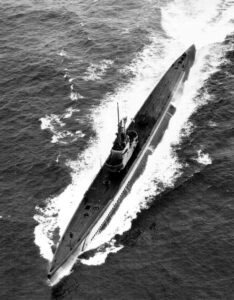 USS Guitarro was laid down on 7 Apr 1943, launched on 26 Sep 1943 and commissioned on 26 Jan 1944. She left for Chicago on 13 February, transferred by floating drydock to New Orleans, sailed to Balboa, then Pearl Harbor on 2 April. Departed on 7 May for Formosa. 30 May she sank Shisen Maru and met a wolf pack under Comdr. F. W. Fenno. 2 June she sank the frigate Awaji. 1st patrol ended in Darwin 19 June, Fremantle. Departed on 21 July for the South China Sea and west coast of Luzon. 7 August missed one, but sank the frigate Kusakaki. Gunned down a small coastal vessel. At Cape Bolinao met USS Raton (SS-270).
USS Guitarro was laid down on 7 Apr 1943, launched on 26 Sep 1943 and commissioned on 26 Jan 1944. She left for Chicago on 13 February, transferred by floating drydock to New Orleans, sailed to Balboa, then Pearl Harbor on 2 April. Departed on 7 May for Formosa. 30 May she sank Shisen Maru and met a wolf pack under Comdr. F. W. Fenno. 2 June she sank the frigate Awaji. 1st patrol ended in Darwin 19 June, Fremantle. Departed on 21 July for the South China Sea and west coast of Luzon. 7 August missed one, but sank the frigate Kusakaki. Gunned down a small coastal vessel. At Cape Bolinao met USS Raton (SS-270).
10 August, convoy, launched four sank the Tanker Shinei Maru. Damaged by DCs. Cape Calavite, 21 August detected a convoy but blocked by current but sank the Uga Maru. 27 August gunned three coastal tankers, sank Nanshin Maru. Back to Fremantle 8 September.
3rd patrol with Bream (SS-243) from 8 October, Philippine waters, Battle of Leyte Gulf, sighted the Central Force under Admiral Kurita on 23–24 October and Mindoro Strait, gathered intel. Guitarro, Bream, Raton on 30 October attacked a convoy off Cape Bolinao. Guitarro at 08:47 sank a cargo (ammunition ship). Next she was with Bream and Ray on 4 November, sank the Kagu Maru. Western Luzon she attacked IJN Kumano in convoy, already damaged at Samar, three hits with nine torpedoes but she survived, was sunk by the others. Bakck to Fremantle, 16 November. Navy Unit Commendation.
4th patrol 11 December via Lombok Strait, South China Sea. Attacked a convoy off Cape Batagan in February, misses. 1 March surfaced in heavy fog, at 01:10 mistook, torpedoed (dodged) by other US sub spotted via SJ radar, managed to reach her via recognition signals. Back Fremantle 15 March 1945.
5th patrol 9 April, Lombok Strait, northeast Sumatra, minelaying off Berhala Island. Patrolled Borneo-Singapore, Saipan 27 May, Pearl Harbor, then Mare Island for overhaul, 18 June, decommissioned 6 December, reserve. 4 battle stars. 1952-1953 Fleet Snorkel conversion. Transferred to Turkey as TCG Preveze (S 340) 7 August 1954, decommissioned on 4 May 1972.
 USS Hammerhead (SS-364)
USS Hammerhead (SS-364)
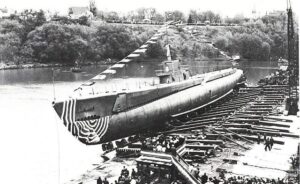 USS Hammerhead was laid down on 5 May 1943, launched on 24 Oct 1943 and commissioned on 1 Mar 1944. Very last of the Gato series, built at Maniwotoc, Wisconsin, and after a month in training on the Lake Michigan she was carried in a floating drydock, towed down the Mississippi River to New Orleans on 8 April 1944, proceeded to Balboa and Pearl Harbor for a 1st patrol from 6 June 1944 with USS Steelhead and Parche south of Formosa. On 9 June she sank a sampan and later missed a coastal oiler on 29 June. On the 30th she damaged several ships of a convoyand arrived in Fremantle on 17 August 1944. Her 2nd patrol was in Java and South China Seas from 9 September. On 1st Oct. she attacked a convoy off Borneo, fired 10 torpedoes, 6 hits, claimed Hiyori Maru, Higane Maru, Kokusei Maru. On 20 October another convoy, six-torpedo, two cargos. She was back on 2 November 1944, awarded a Navy Unit Commendation.
USS Hammerhead was laid down on 5 May 1943, launched on 24 Oct 1943 and commissioned on 1 Mar 1944. Very last of the Gato series, built at Maniwotoc, Wisconsin, and after a month in training on the Lake Michigan she was carried in a floating drydock, towed down the Mississippi River to New Orleans on 8 April 1944, proceeded to Balboa and Pearl Harbor for a 1st patrol from 6 June 1944 with USS Steelhead and Parche south of Formosa. On 9 June she sank a sampan and later missed a coastal oiler on 29 June. On the 30th she damaged several ships of a convoyand arrived in Fremantle on 17 August 1944. Her 2nd patrol was in Java and South China Seas from 9 September. On 1st Oct. she attacked a convoy off Borneo, fired 10 torpedoes, 6 hits, claimed Hiyori Maru, Higane Maru, Kokusei Maru. On 20 October another convoy, six-torpedo, two cargos. She was back on 2 November 1944, awarded a Navy Unit Commendation.
3rd war patrol started on 25 November in the South China Sea wuth Lapon and Paddle. Nope. Back 17 January 1945. 4th war patrol started on 19 February with Baya. Off Cape Varella on 23 February she launched 4 torpedoes, sank the frigate Yaku. The commander being ill she was back on 3 March 1945 at Subic Bay.
5th patrol started on 10 March 1945, Indochina, 29 March convoy, sank one cargo and the escort, damaged two and retired, back on 6 April at Subic Bay.
6th patrol: Gulf of Siam, 6 May, missed a small tanker but tried again and sank Kinrei Maru. 14 May sank a cargo. Back 25 May.
7th patrol June–August 1945 from Fremantle, Gulf of Siam. 10 July: sank Sakura Maru and Nanmei Maru No. 5. Ended 21 August, Pearl Harbor, 7 battle stars.
Mare Island, decommissioned 9 February 1946, Reserve Fleet, recom. for the Korean War February 1952, TS until 21 August 1953, decom. Converted to a GUPPY at Mare Island, transferred 23 October 1954 on loan to Turkey as TCG Cerbe (S 341), decom. 4 May 1972.
Sources:
Books
Bauer, K. Jack; Roberts, Stephen S. (1991). Register of Ships of the U.S. Navy, 1775-1990: Major Combatants. Westport, Connecticut: Greenwood Press.
Blair, Clay Jr. (2001). Silent Victory: The U.S. Submarine War Against Japan. Naval Institute Press.
Friedman, Norman (1995). U.S. Submarines through 1945: An Illustrated Design History. Annapolis, Maryland: United States Naval Institute.
Friedman, Norman (1994). U.S. Submarines since 1945: An Illustrated Design History. Annapolis, Maryland: United States Naval Institute.
Alden, John D., Commander (U.S. Navy Ret) (1979). The Fleet Submarine in the U.S. Navy: A Design and Construction History. NIP
Bauer, K. Jack; Roberts, Stephen S. (1991). Register of Ships of the U.S. Navy, 1775–1990: Major Combatants. Greenwood Press.
Blair, Clay Jr. (2001). Silent Victory: The U.S. Submarine War Against Japan. Naval Institute Press.
Fluckey, Eugene B. (1992). Thunder Below: The USS Barb Revolutionizes Submarine Warfare in World War II. University of Illinois Press.
Friedman, Norman (1995). U.S. Submarines Through 1945: An Illustrated Design History. Annapolis, Maryland: United States Naval Institute.
Friedman, Norman (1994). U.S. Submarines Since 1945: An Illustrated Design History. Annapolis, Maryland: United States Naval Institute.
Gardiner, Robert; Chesneau, Roger (1980). Conway’s All the World’s Fighting Ships 1922–1946. Conway Maritime Press.
Hutchinson, Robert (2001). Jane’s submarines : war beneath the waves from 1776 to the present day. London: HarperCollins.
Johnston, David L. (2024). “A Visual Guide to the U.S. Fleet Submarines Part Four: Gato Class (With a Tambor/Gar Class Postscript) 1941–1945” (PDF).
McFarlane, Suzanne (23 August 2017). “Tunny I (SS-282)”. Dictionary of American Naval Fighting Ships. Navy Department, Naval History and Heritage Command.
O’Kane, Richard (1987). Wahoo – The Patrols of America’s Most Famous WWII Submarine. Presidio Press.
Roscoe, Theodore (1949). United States Submarine Operations in World War II. Naval Institute Press.
Silverstone, Paul H. (1989) [1965]. U.S. Warships of World War II. Annapolis, MD: Naval Institute Press.
Links
on pwencycl.kgbudge.com Pacific encyclopedia
on mackinnon.org/
guppysubmarinetribute.homestead.com/
rnsubs.co.uk/dits-bits guppy.html
on nationalinterest.org/
history.navy.mi USS growler
on ussalabama.com/
on uboat.net/
navsource.org/ USS Gato
navsource.org/ uss guavina
navsource.org uss Guitarro
navsource.org uss hammerhead
navsource.org/ gaot class line drawings and schemes
silversidesmuseum.org
on web.archive.org/ public.navy.mil
web.archive.org/ maritime.org fleetsub
on rnsubs.co.uk/
on usscod.org
On navsource.org USS Cod
navweaps.com/ 3in/50
navweaps.com 4-in/50 mk9
navweaps.com 5-in/25 mk10
on en.m.wikipedia.org
USS Cod’s stranded boarding party
https://www.drum228.org/
https://web.archive.org/web/20110201162627/http://ussdrum228story.com/Official_SS-228_Documentary_Website/Home.html
web.archive.org/ hnsa.org/ uss cod
history.navy.mil /USS cod
apps.dtic.mil hydrophones
on en.m.wikipedia.org/ Gato-class
on commons.wikimedia.org/ Gato_class
Videos
3D
Models Kits
Many kits, full list on scalemates
Gallery

USS Gato (1/700)

USS Tench (1/700)
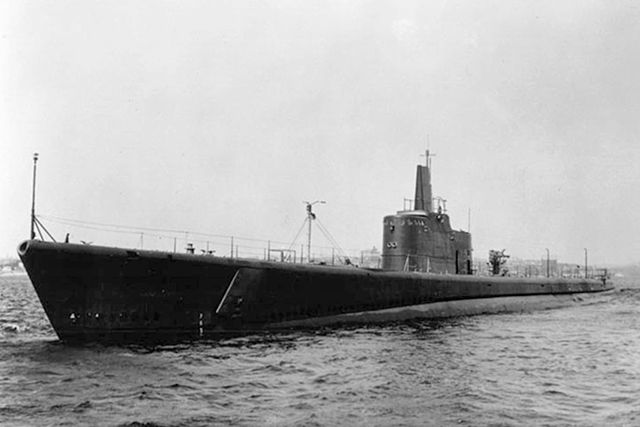
USS Grunion, SS-216
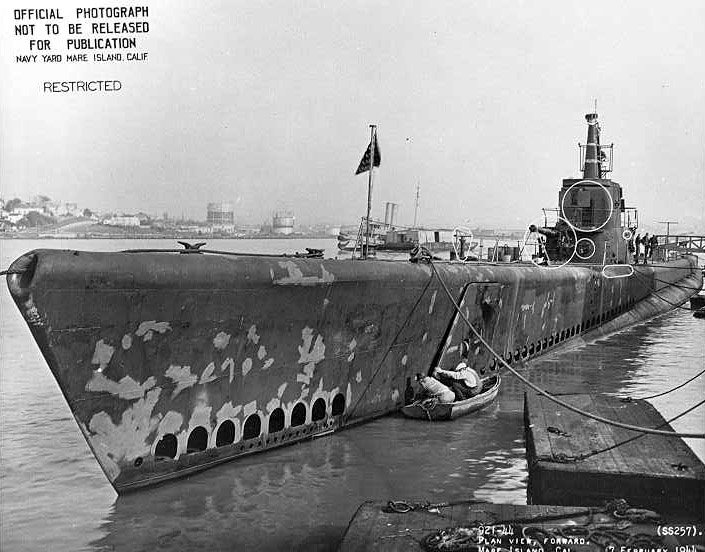
USS Harder, 1945, Mare Island Navy Yard

USS Mingo
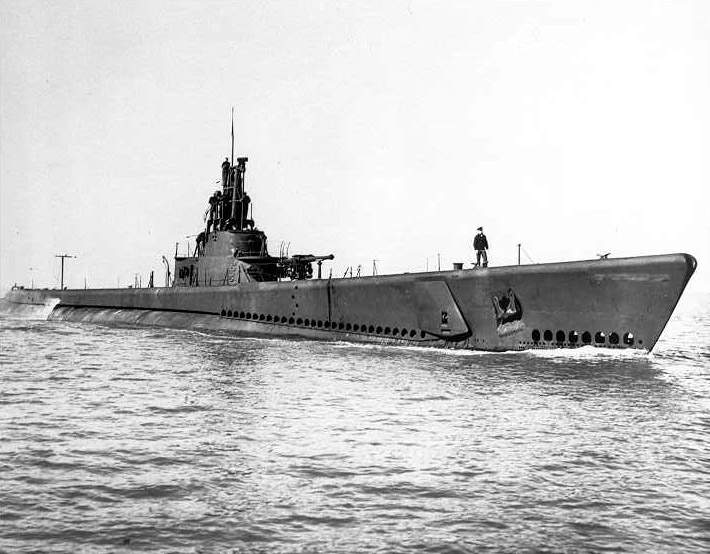
USS Paddle
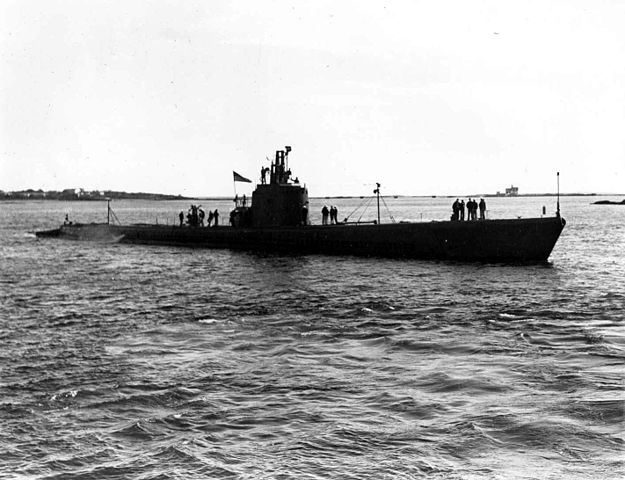
USS Runner
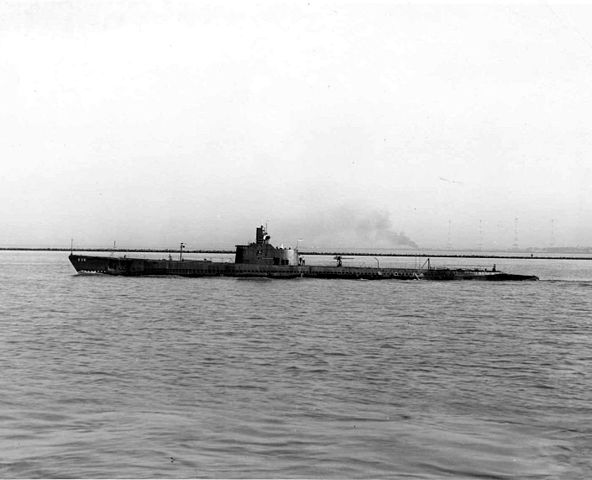
USS Silversides

USS Tench, HD 1/400 illustration

Balao, Tench, Gato class, HD 1/400 illustrations

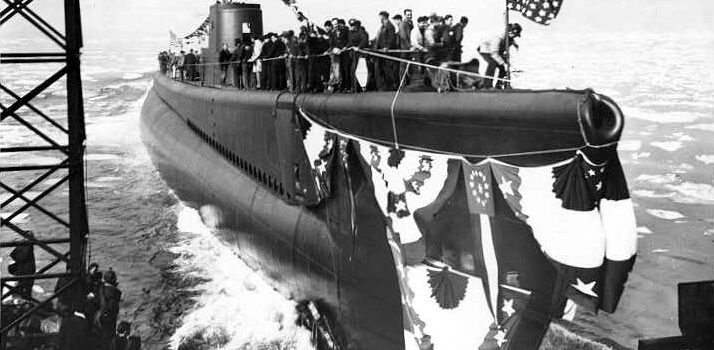
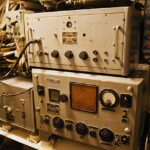
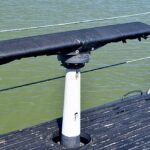





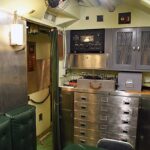




 Latest Facebook Entry -
Latest Facebook Entry -  X(Tweeter) Naval Encyclopedia's deck archive
X(Tweeter) Naval Encyclopedia's deck archive Instagram (@navalencyc)
Instagram (@navalencyc)





 French Navy
French Navy Royal Navy
Royal Navy Russian Navy
Russian Navy Armada Espanola
Armada Espanola Austrian Navy
Austrian Navy K.u.K. Kriegsmarine
K.u.K. Kriegsmarine Dansk Marine
Dansk Marine Nautiko Hellenon
Nautiko Hellenon Koninklije Marine 1870
Koninklije Marine 1870 Marinha do Brasil
Marinha do Brasil Osmanlı Donanması
Osmanlı Donanması Marina Do Peru
Marina Do Peru Marinha do Portugal
Marinha do Portugal Regia Marina 1870
Regia Marina 1870 Nihhon Kaigun 1870
Nihhon Kaigun 1870 Preußische Marine 1870
Preußische Marine 1870 Russkiy Flot 1870
Russkiy Flot 1870 Svenska marinen
Svenska marinen Søværnet
Søværnet Union Navy
Union Navy Confederate Navy
Confederate Navy Armada de Argentina
Armada de Argentina Imperial Chinese Navy
Imperial Chinese Navy Marinha do Portugal
Marinha do Portugal Mexico
Mexico Kaiserliche Marine
Kaiserliche Marine 1898 US Navy
1898 US Navy Sovietskiy Flot
Sovietskiy Flot Royal Canadian Navy
Royal Canadian Navy Royal Australian Navy
Royal Australian Navy RNZN Fleet
RNZN Fleet Chinese Navy 1937
Chinese Navy 1937 Kriegsmarine
Kriegsmarine Chilean Navy
Chilean Navy Danish Navy
Danish Navy Finnish Navy
Finnish Navy Hellenic Navy
Hellenic Navy Polish Navy
Polish Navy Romanian Navy
Romanian Navy Turkish Navy
Turkish Navy Royal Yugoslav Navy
Royal Yugoslav Navy Royal Thai Navy
Royal Thai Navy Minor Navies
Minor Navies Albania
Albania Austria
Austria Belgium
Belgium Columbia
Columbia Costa Rica
Costa Rica Cuba
Cuba Czechoslovakia
Czechoslovakia Dominican Republic
Dominican Republic Haiti
Haiti Hungary
Hungary Honduras
Honduras Estonia
Estonia Iceland
Iceland Eire
Eire Equador
Equador Iran
Iran Iraq
Iraq Latvia
Latvia Liberia
Liberia Lithuania
Lithuania Mandchukuo
Mandchukuo Morocco
Morocco Nicaragua
Nicaragua Persia
Persia San Salvador
San Salvador Sarawak
Sarawak Uruguay
Uruguay Venezuela
Venezuela Zanzibar
Zanzibar Warsaw Pact Navies
Warsaw Pact Navies Bulgaria
Bulgaria Hungary
Hungary

 Bundesmarine
Bundesmarine Dutch Navy
Dutch Navy Hellenic Navy
Hellenic Navy Marina Militare
Marina Militare Yugoslav Navy
Yugoslav Navy Chinese Navy
Chinese Navy Indian Navy
Indian Navy Indonesian Navy
Indonesian Navy JMSDF
JMSDF North Korean Navy
North Korean Navy Pakistani Navy
Pakistani Navy Philippines Navy
Philippines Navy ROKN
ROKN Rep. of Singapore Navy
Rep. of Singapore Navy Taiwanese Navy
Taiwanese Navy IDF Navy
IDF Navy Saudi Navy
Saudi Navy Royal New Zealand Navy
Royal New Zealand Navy Egyptian Navy
Egyptian Navy South African Navy
South African Navy






























 Ukrainian Navy
Ukrainian Navy dbodesign
dbodesign